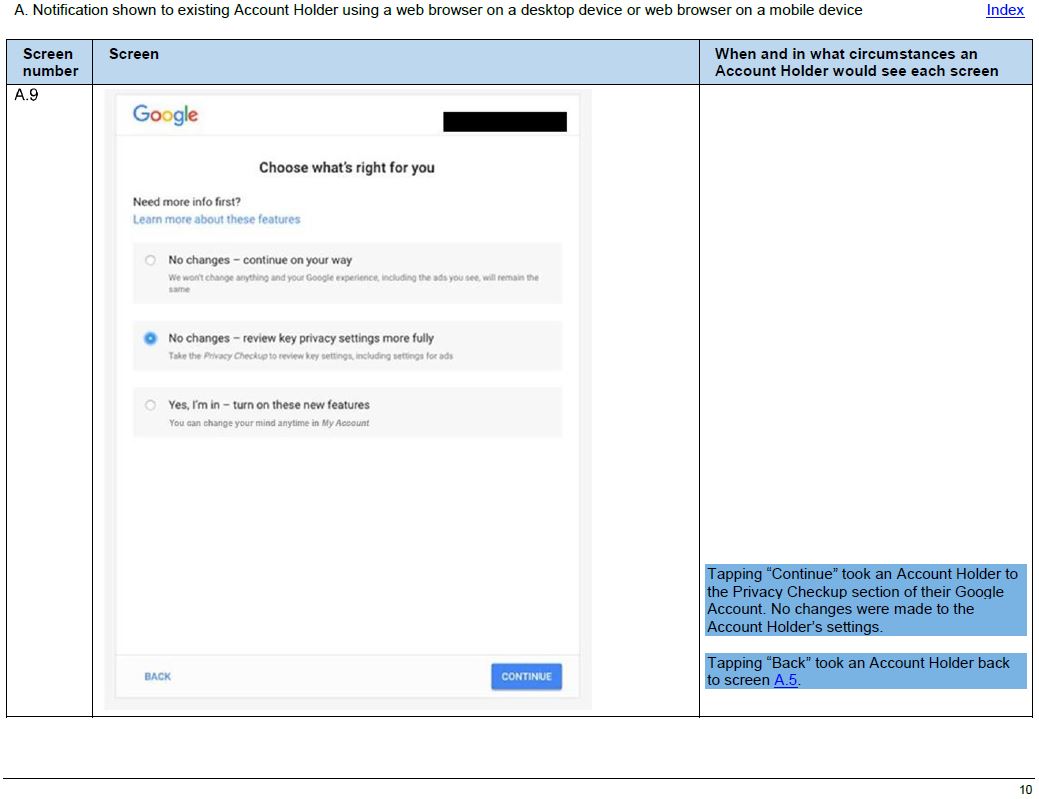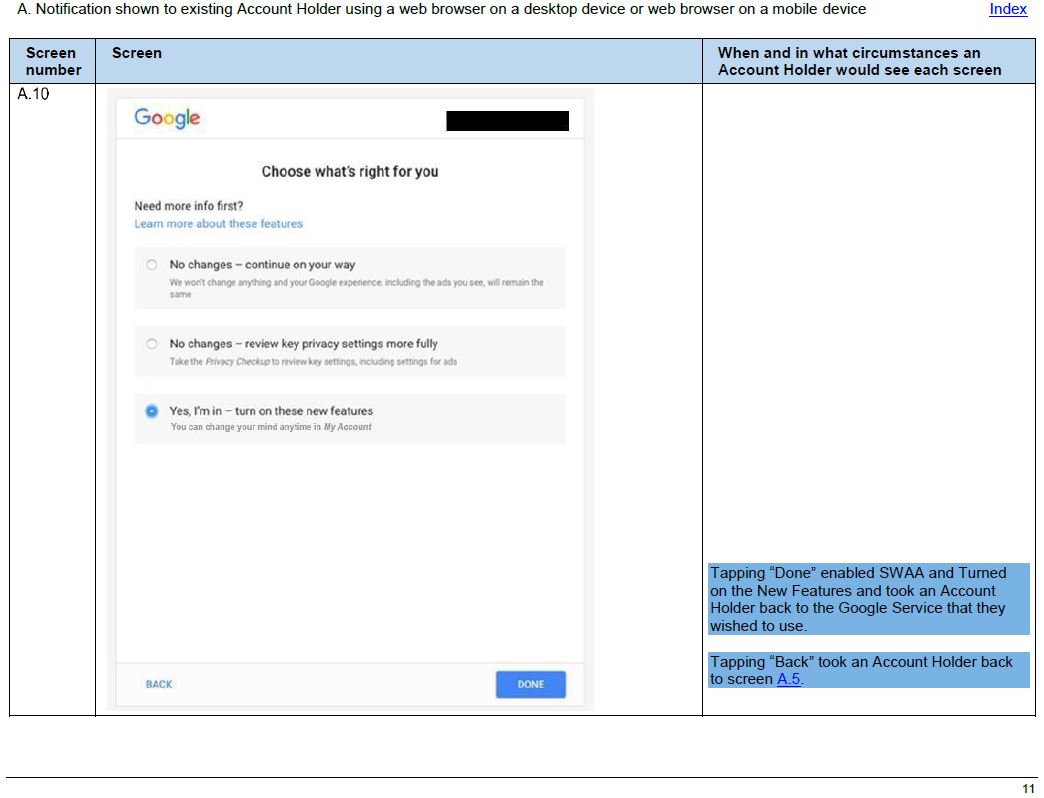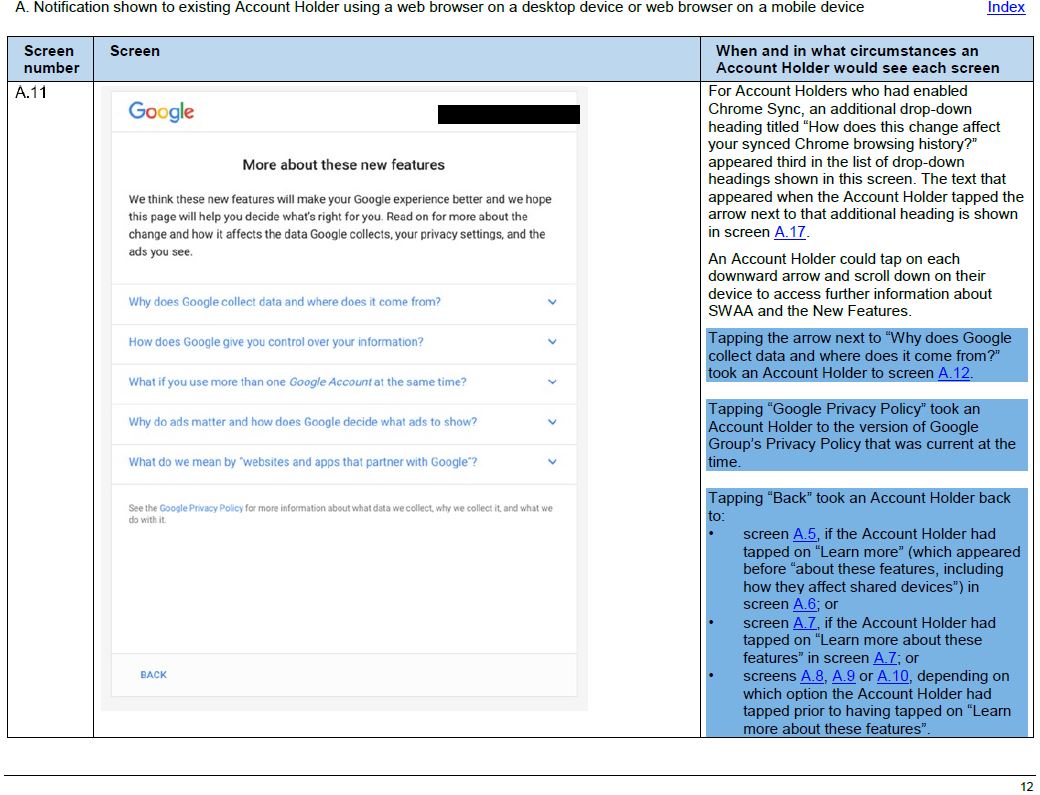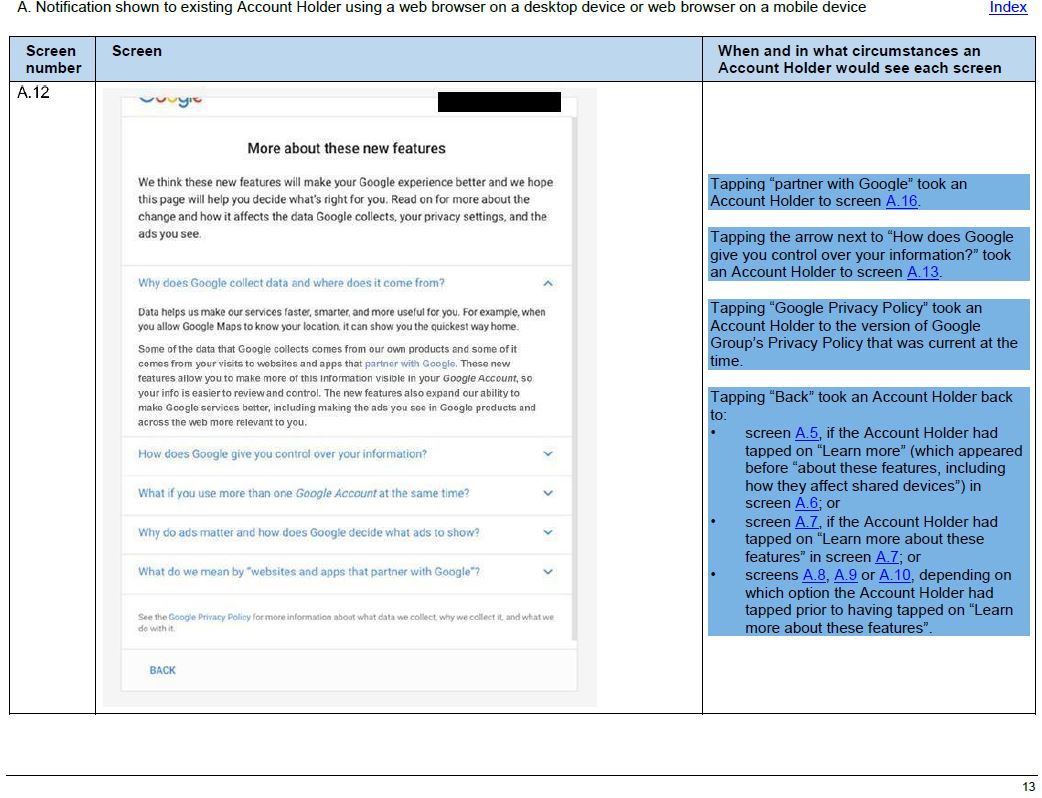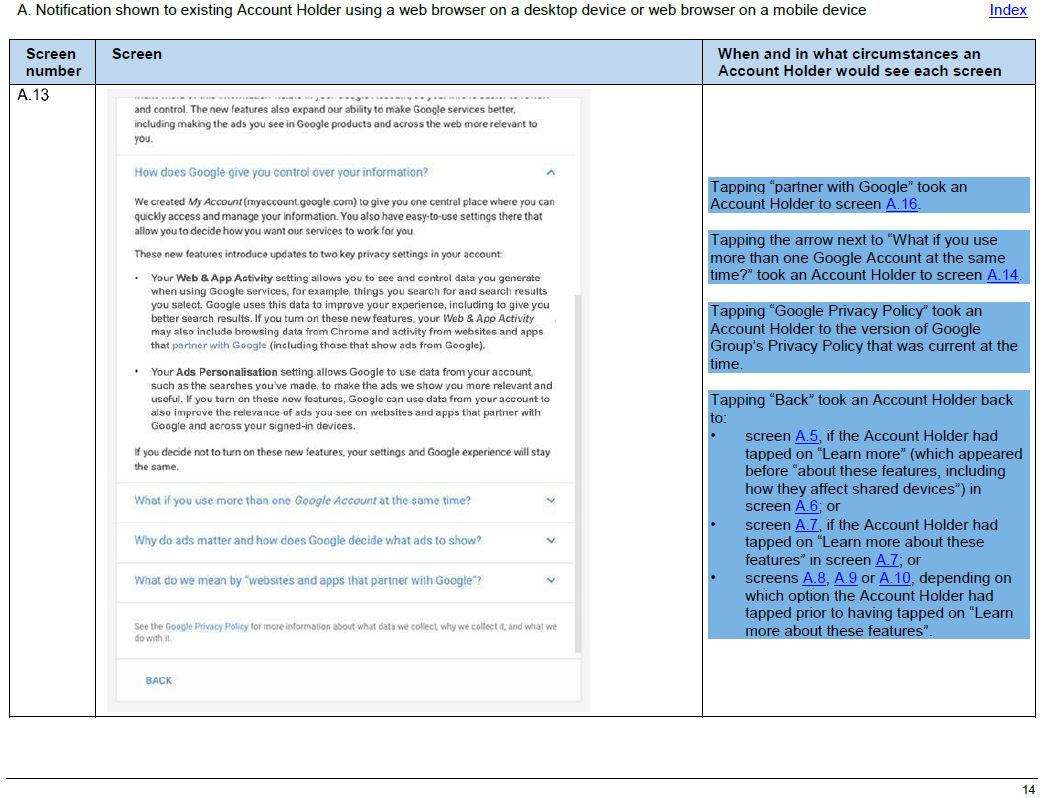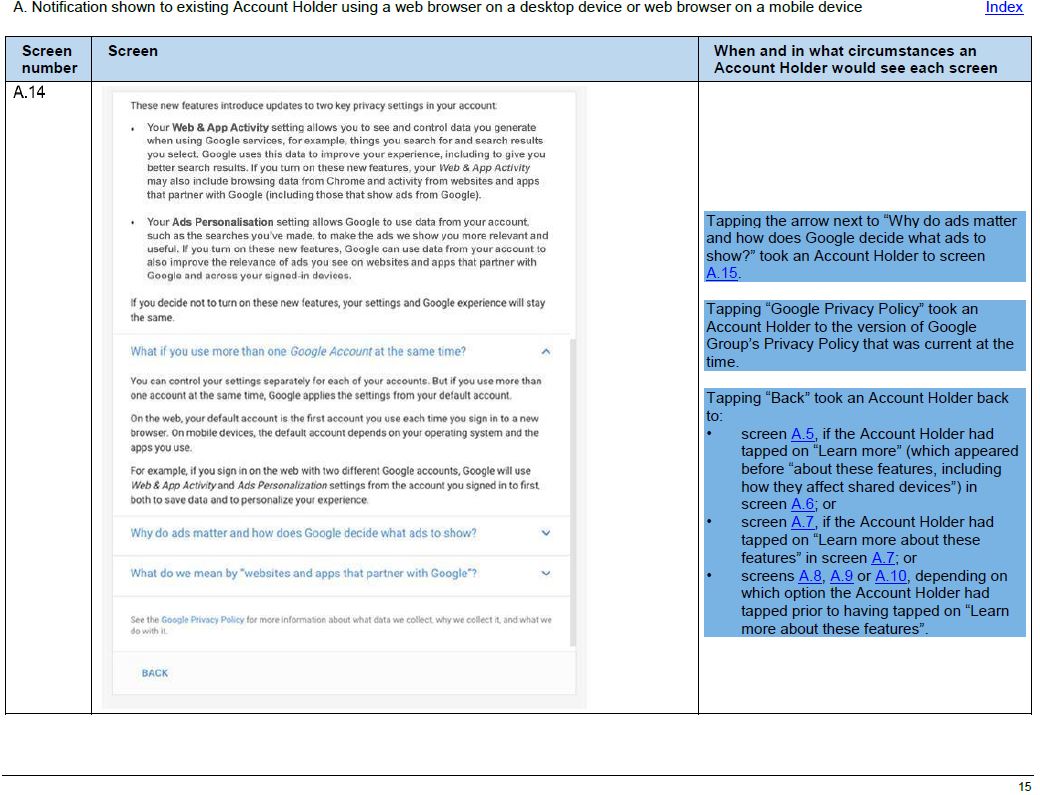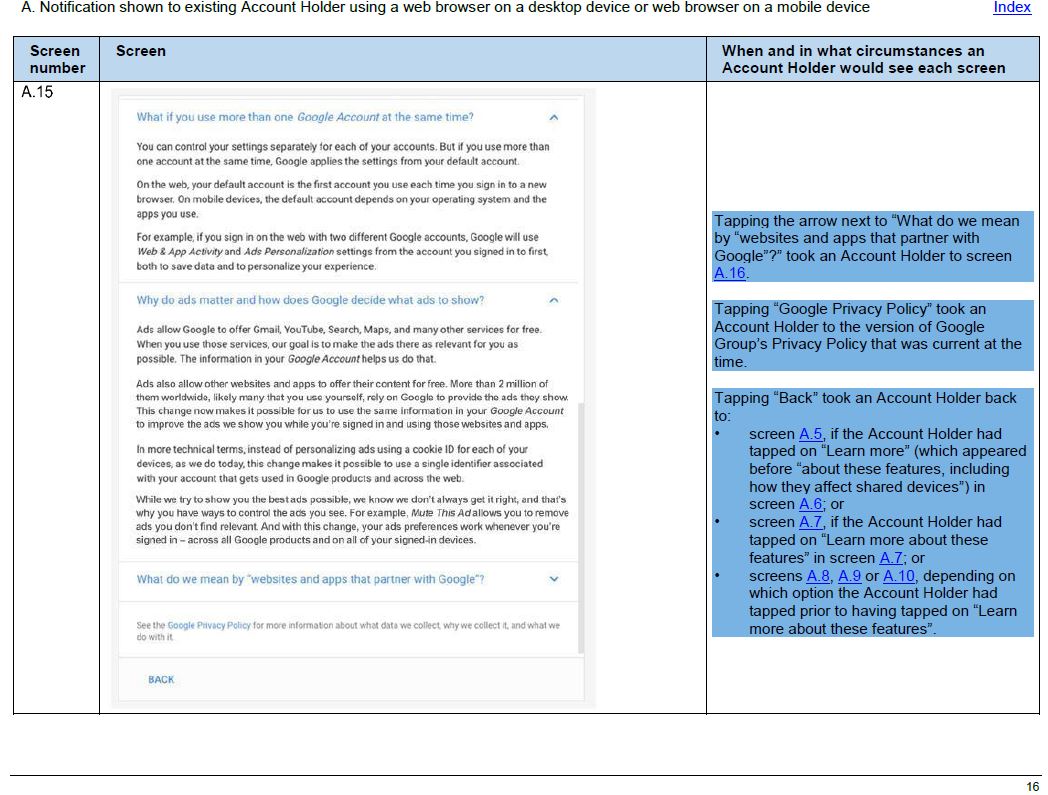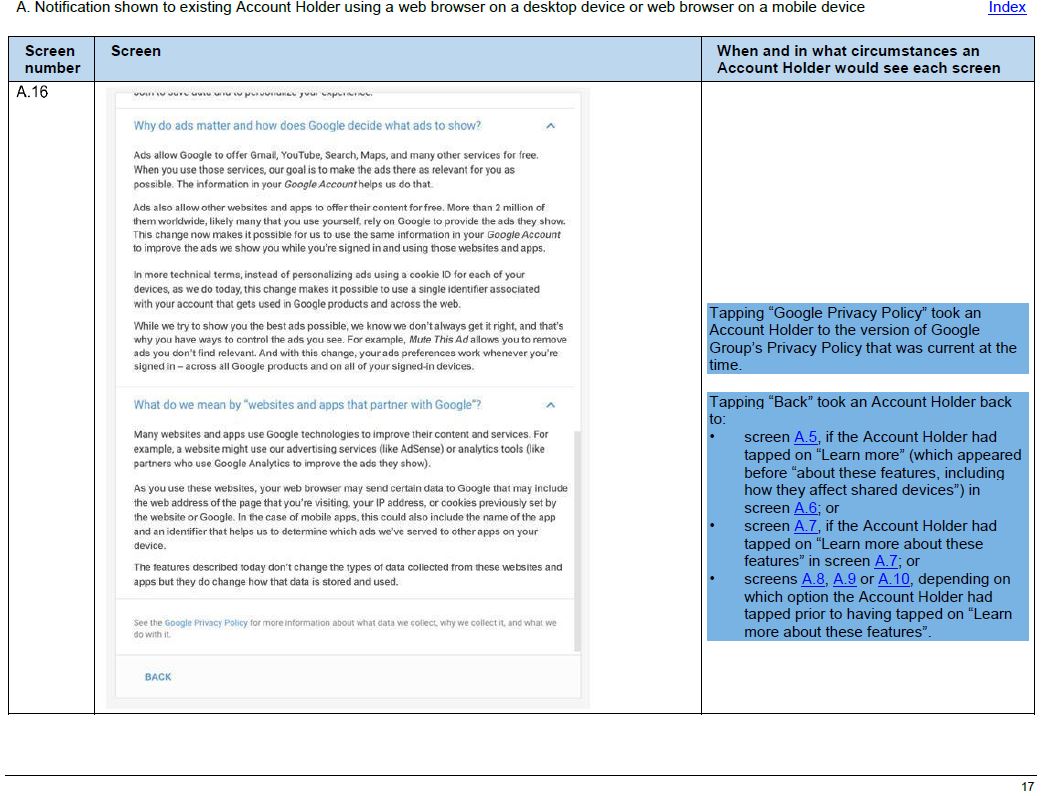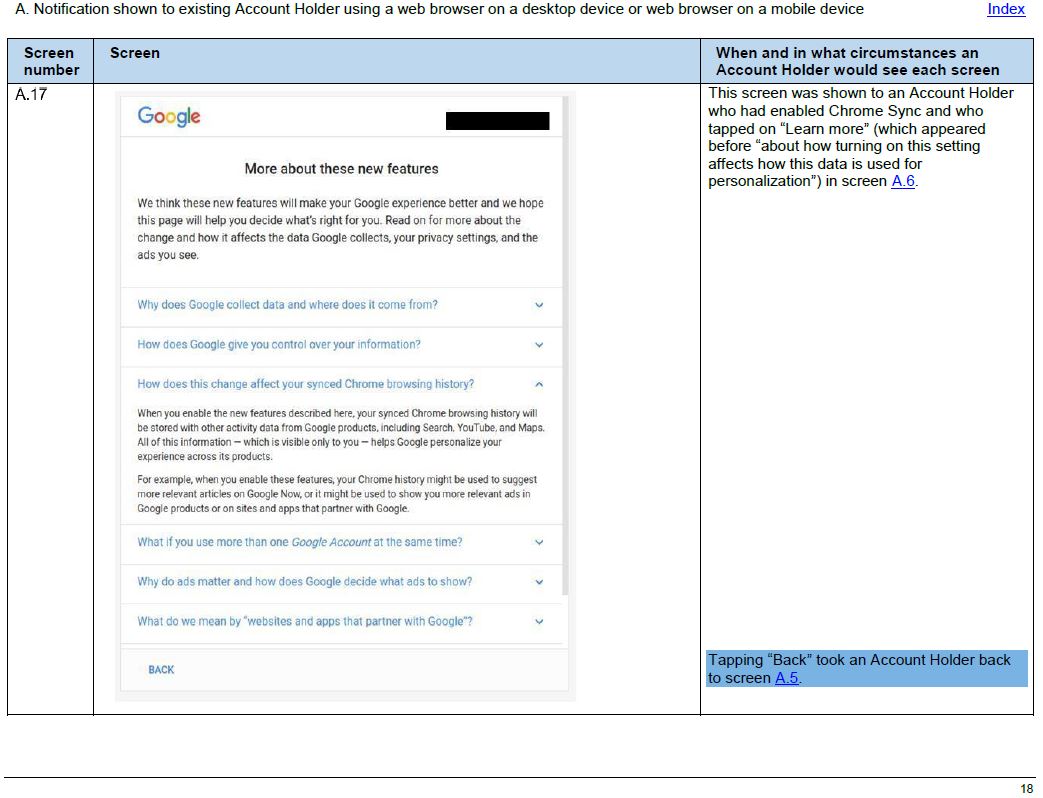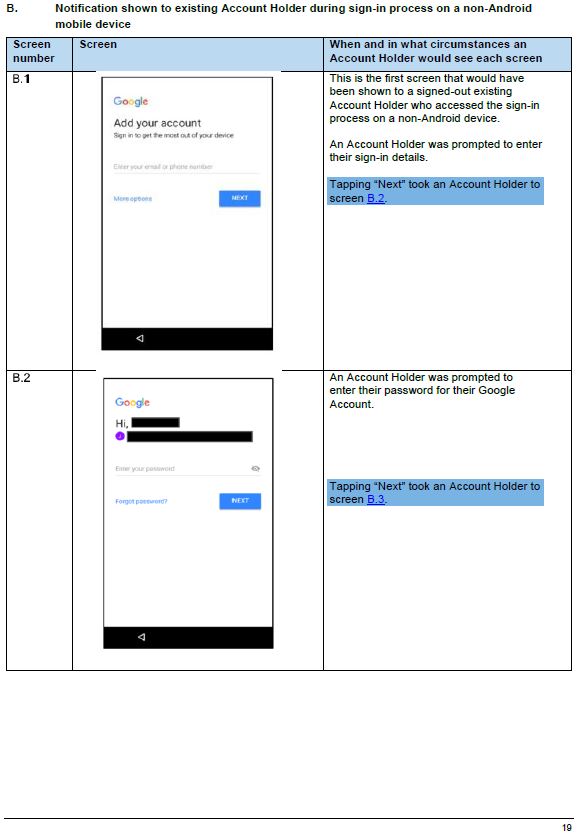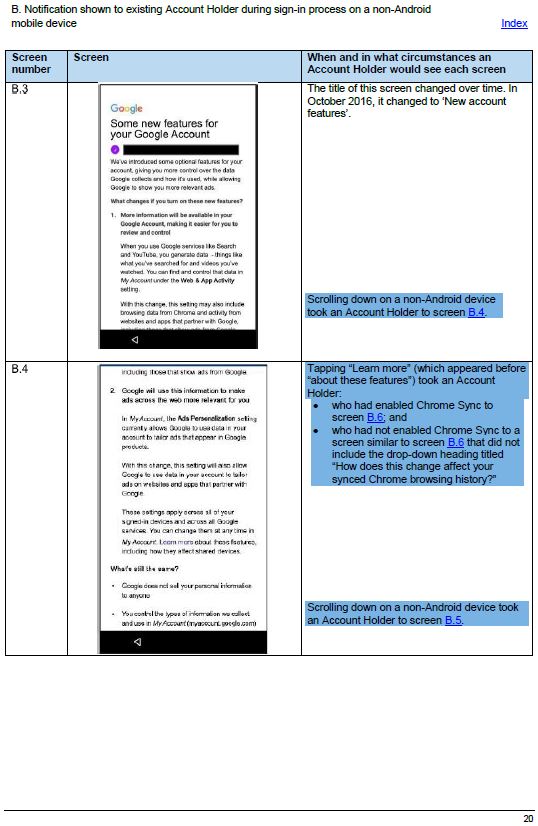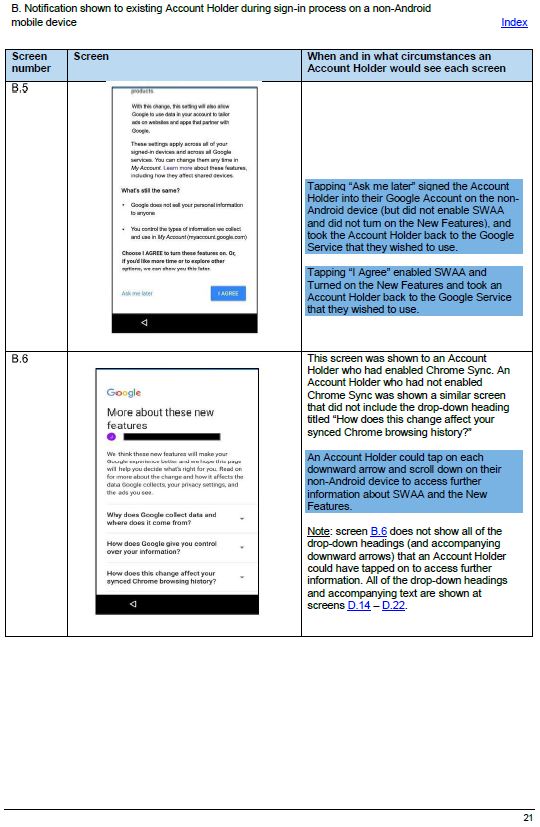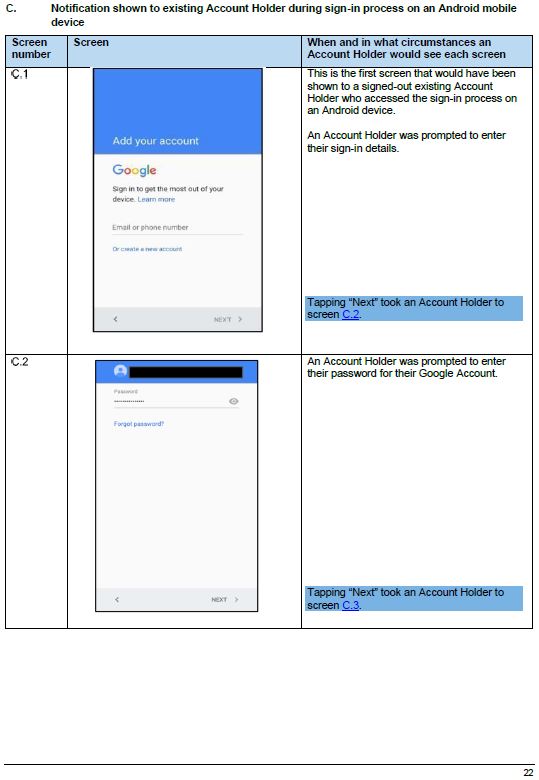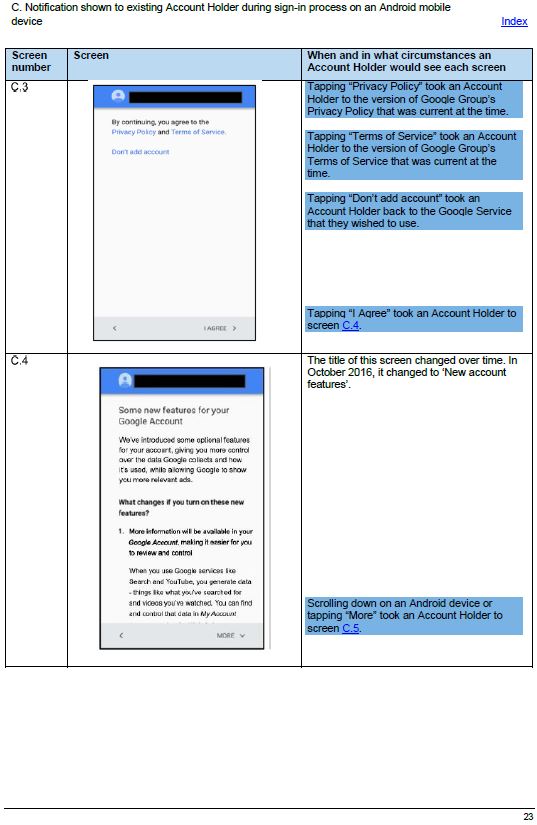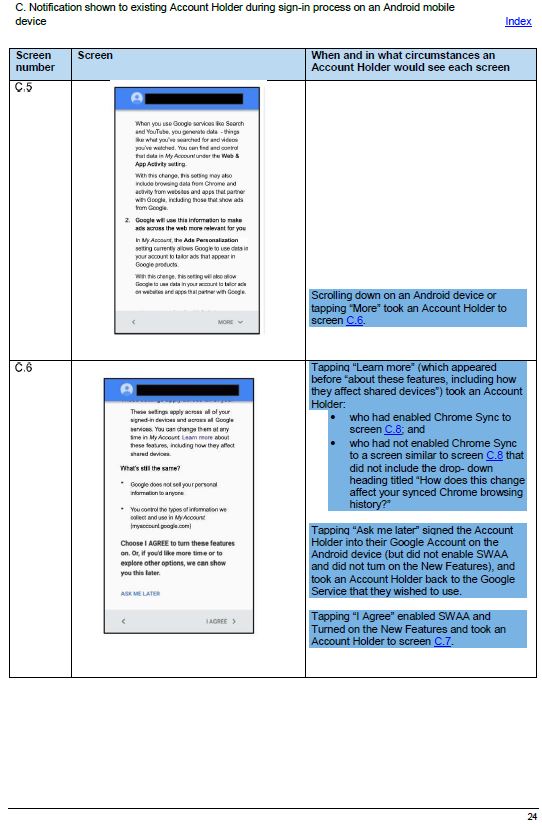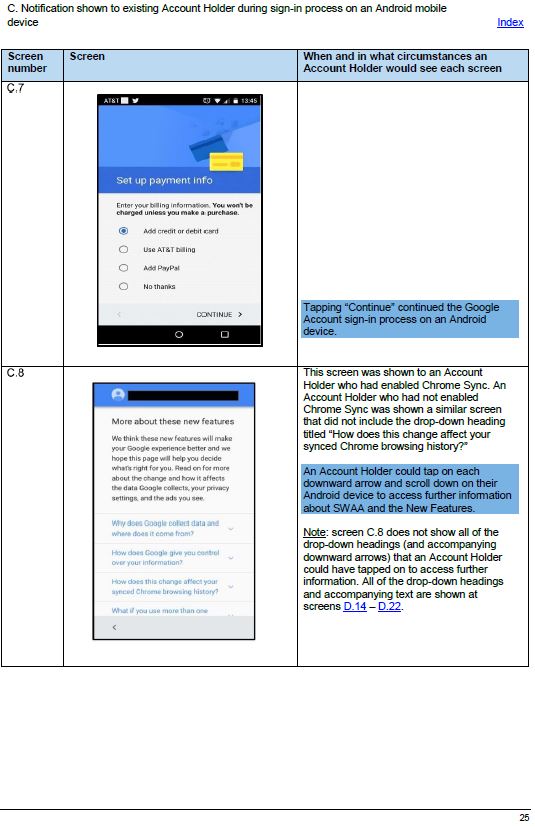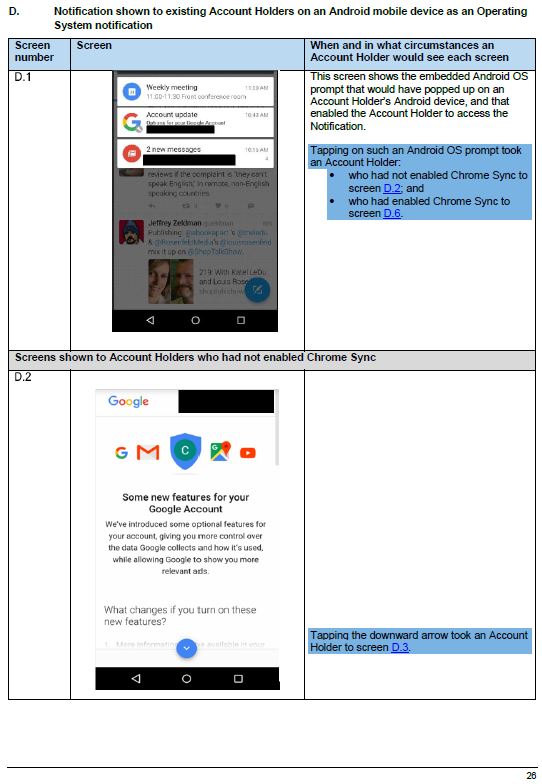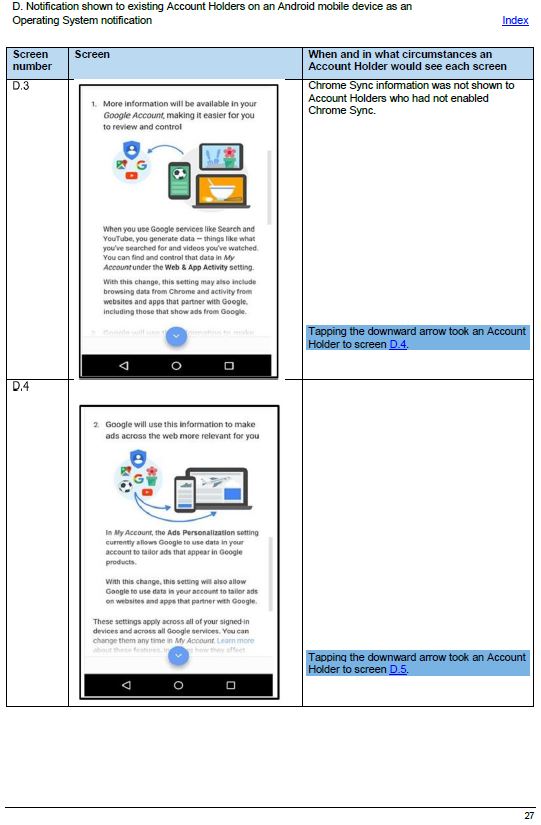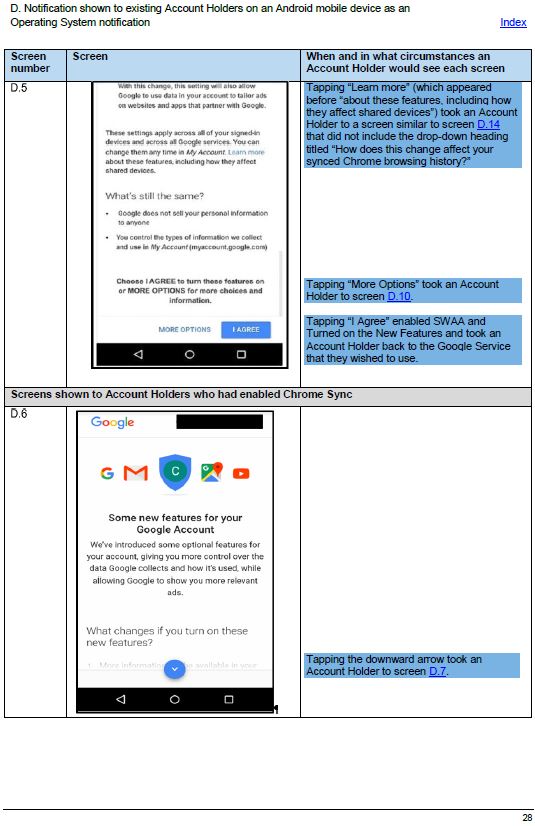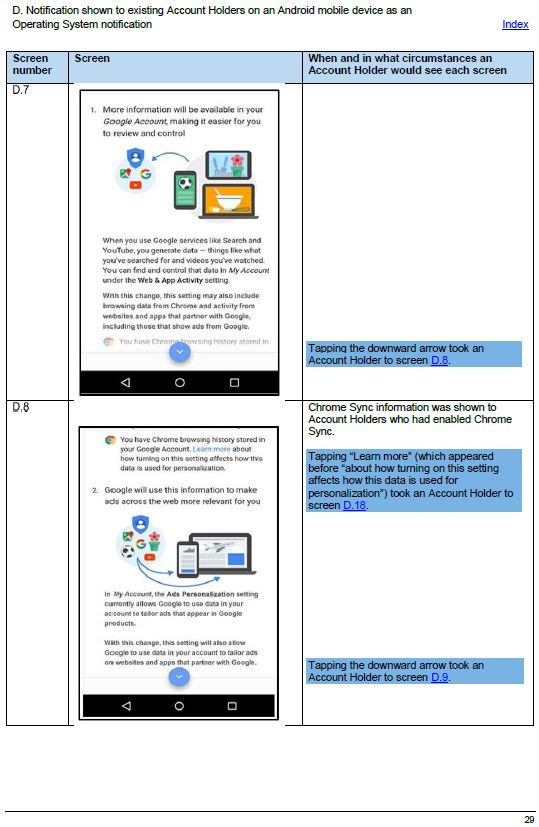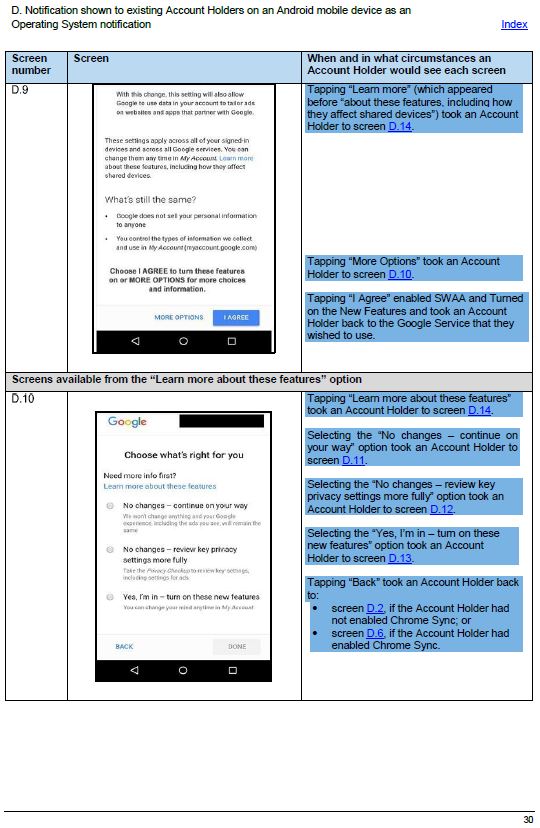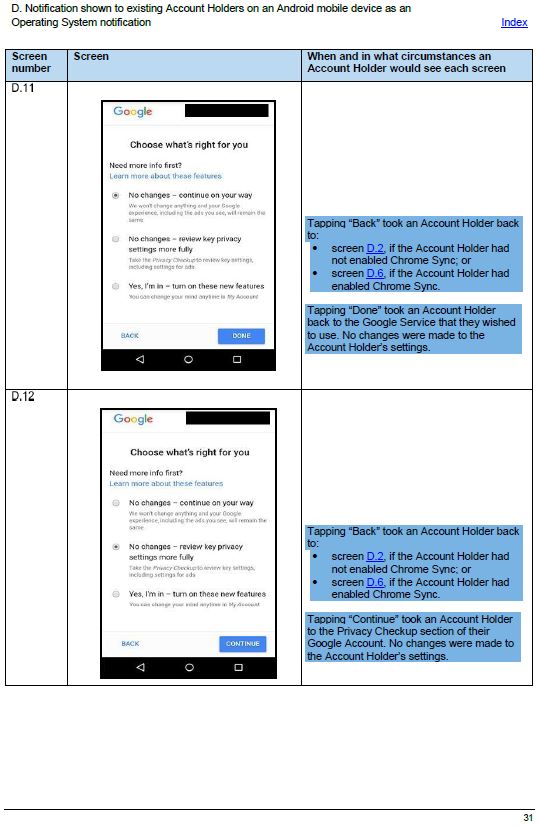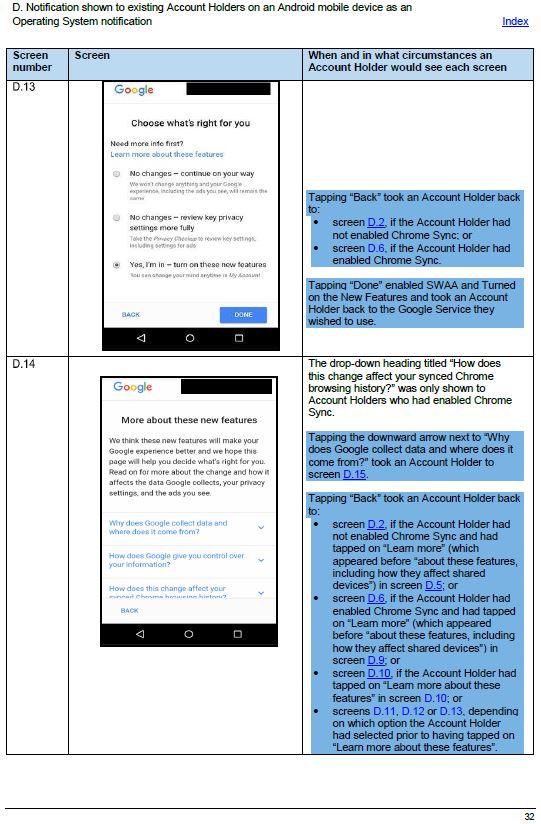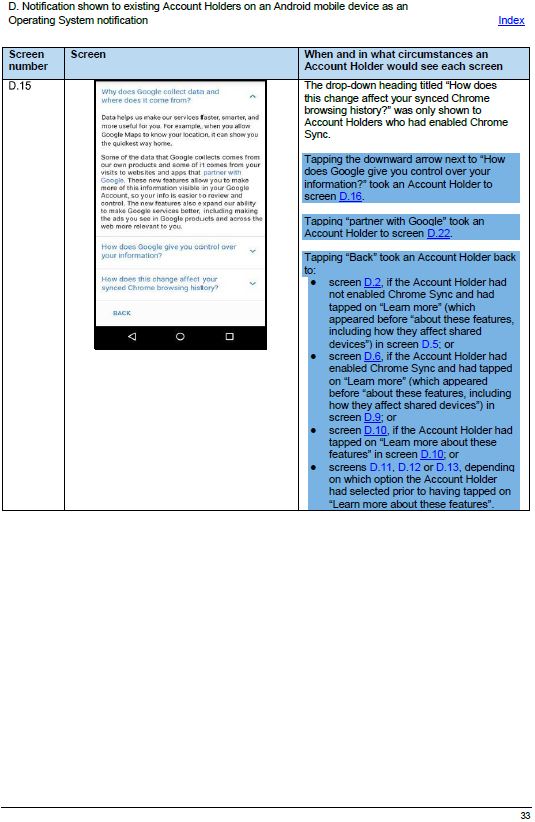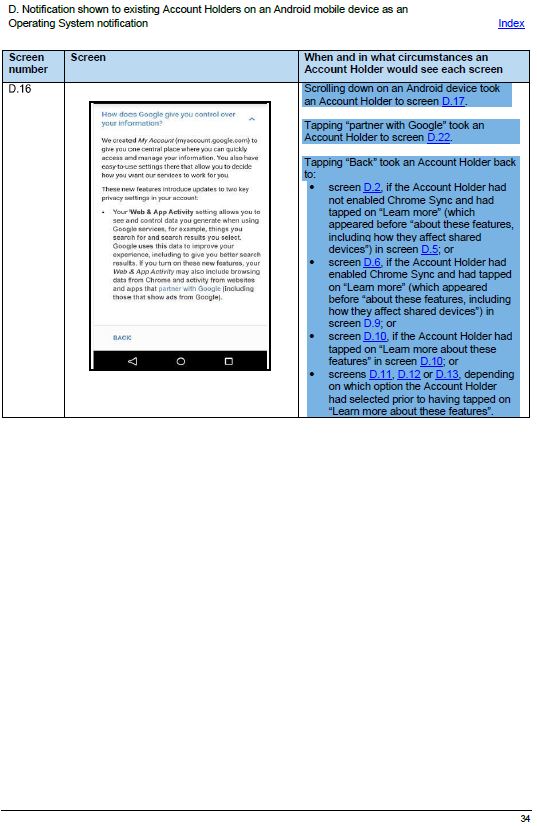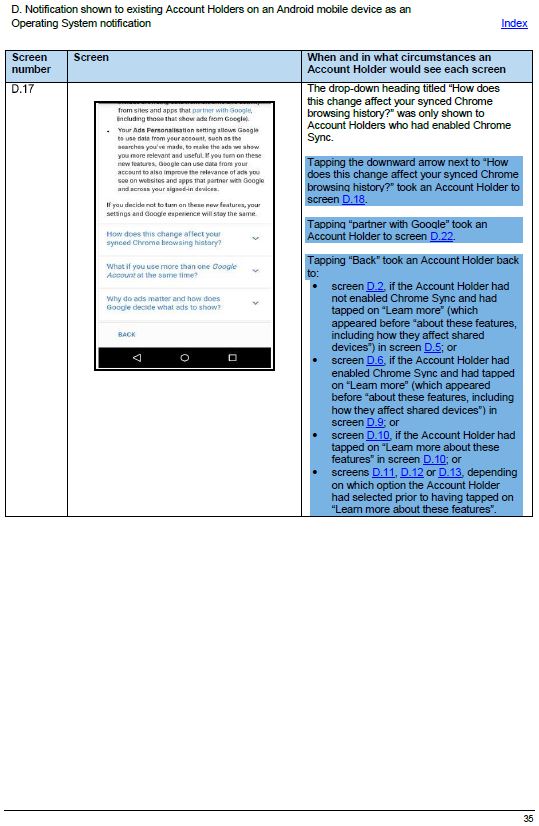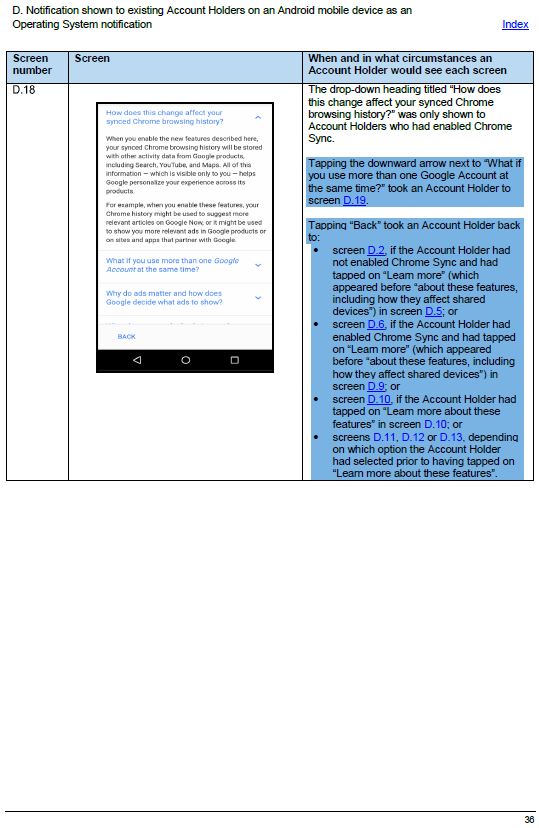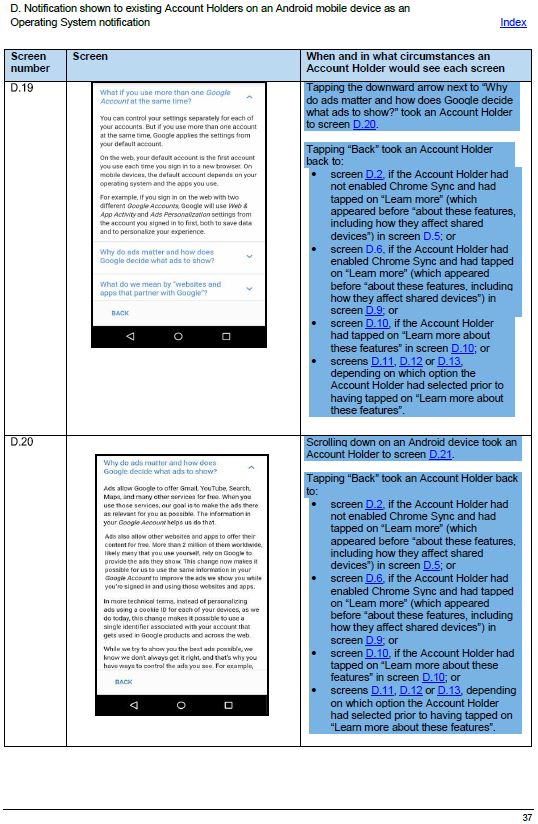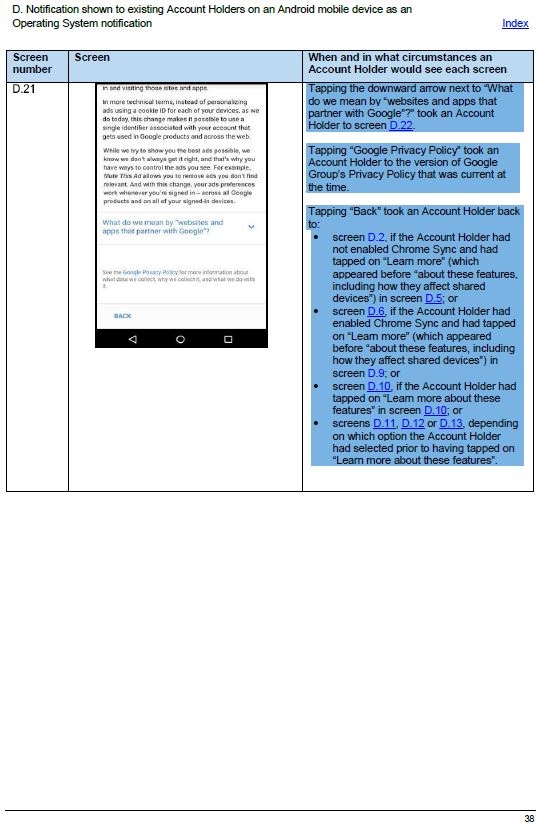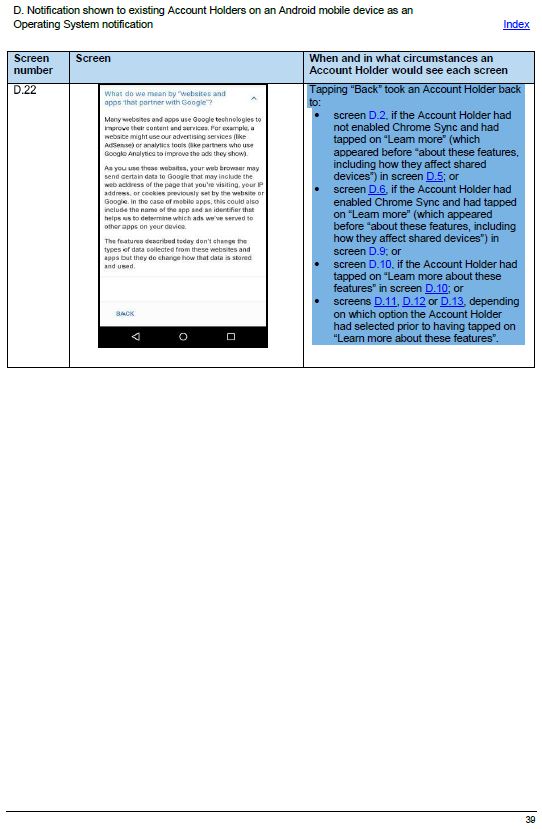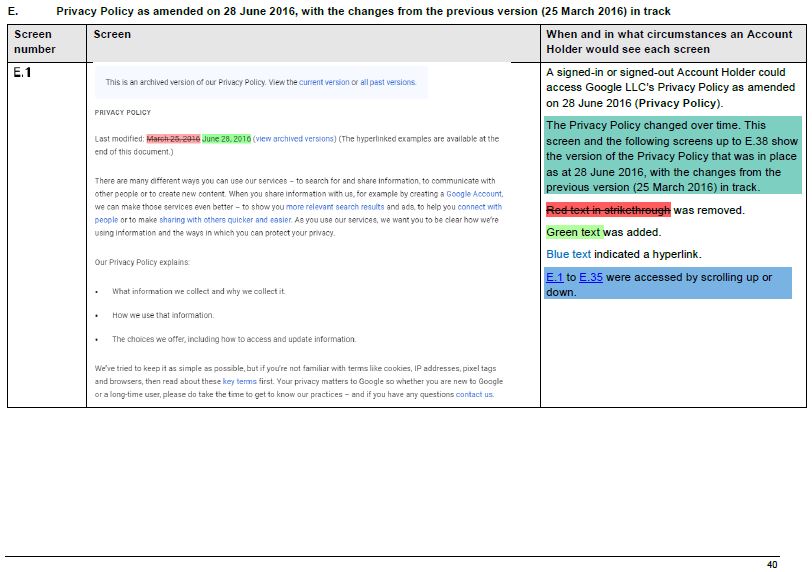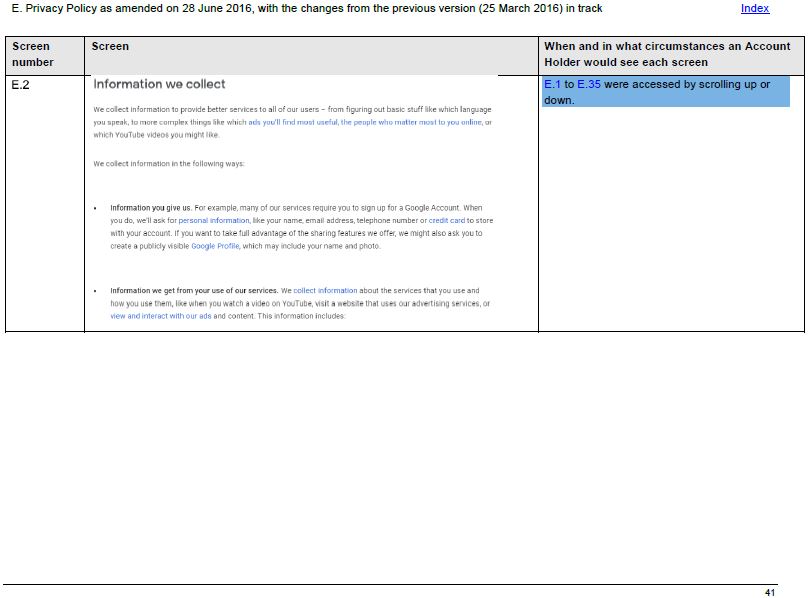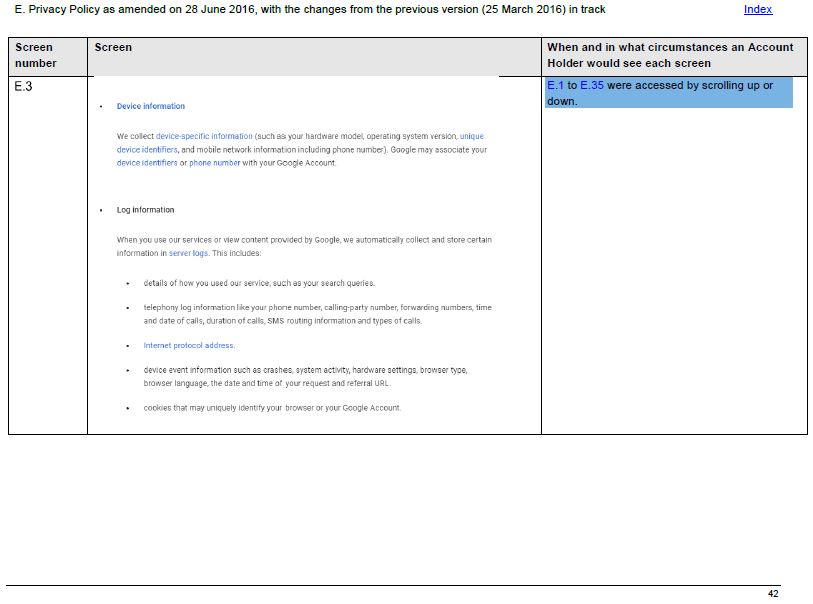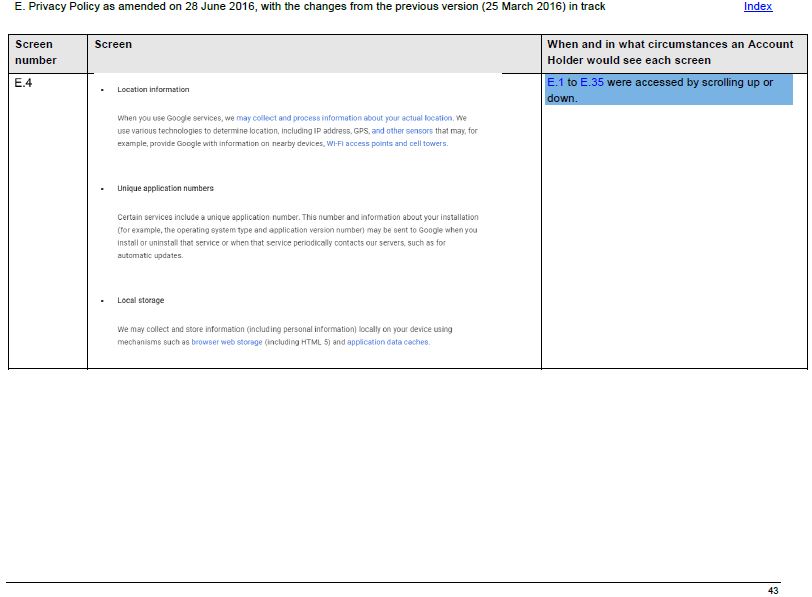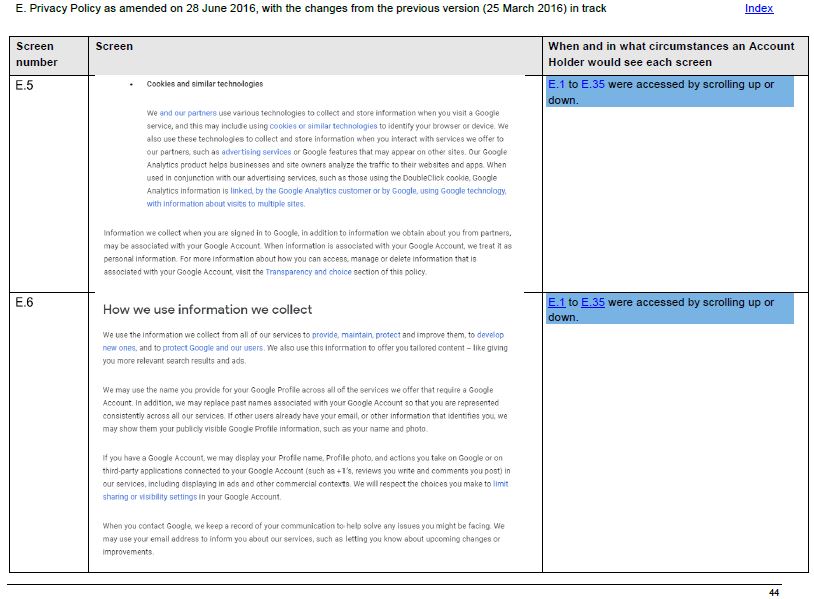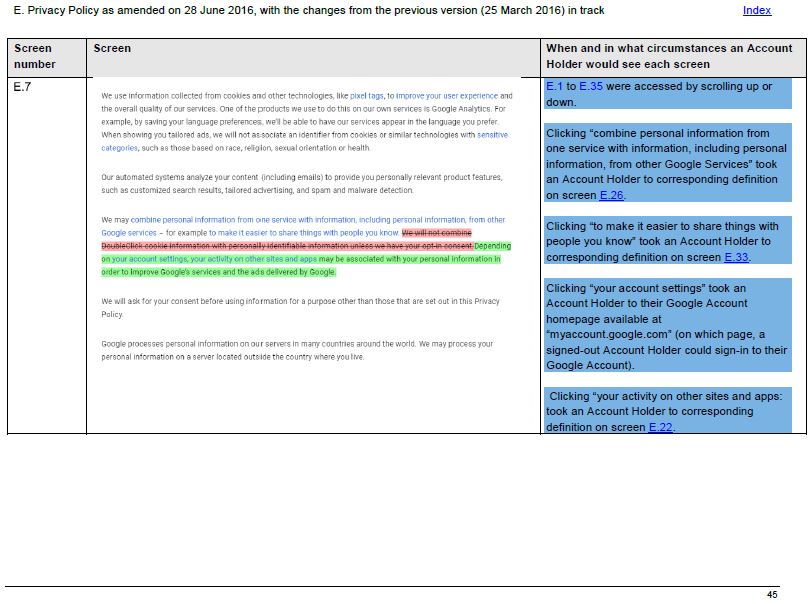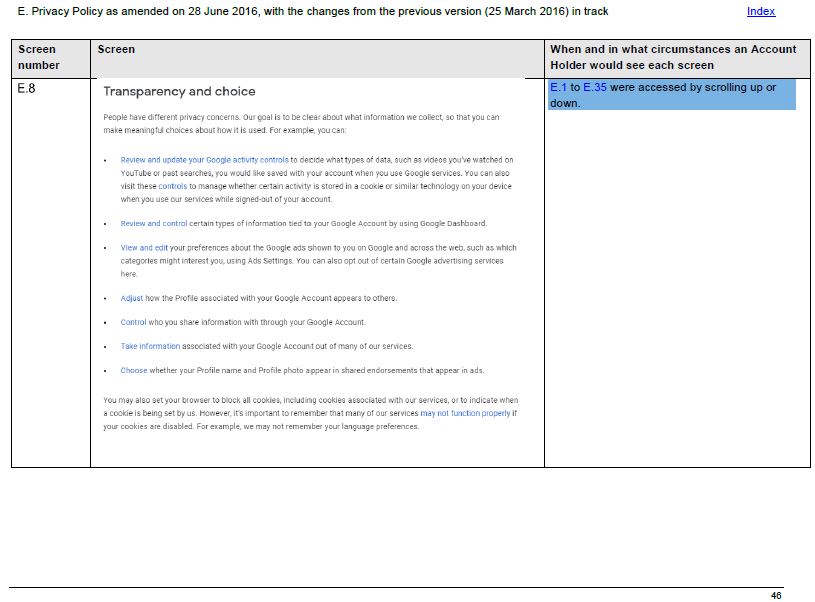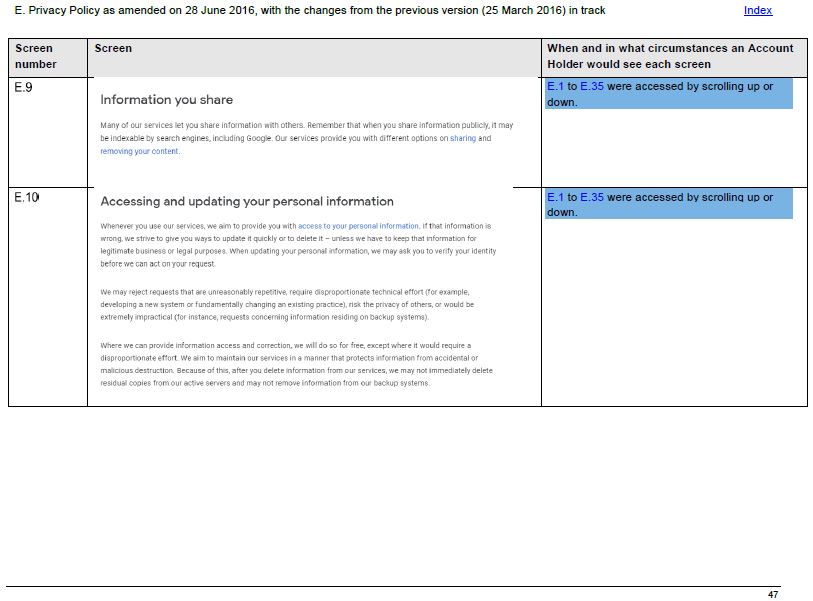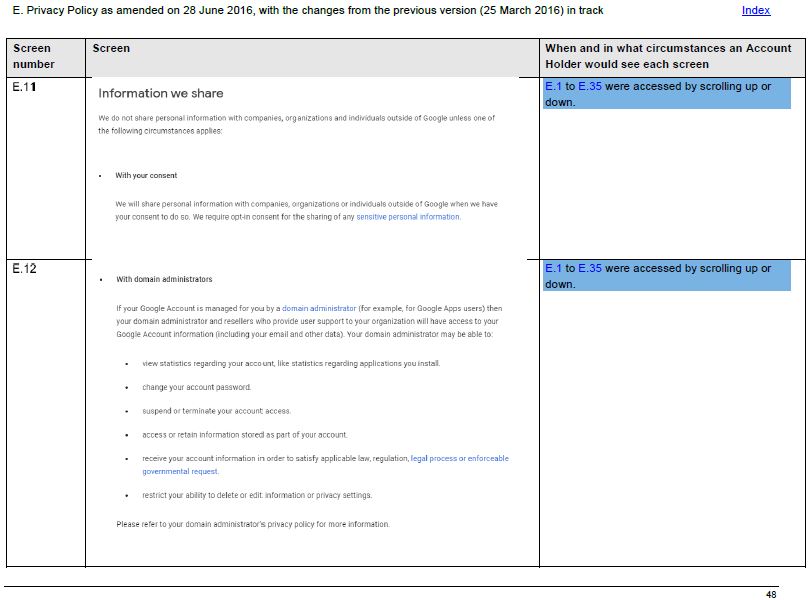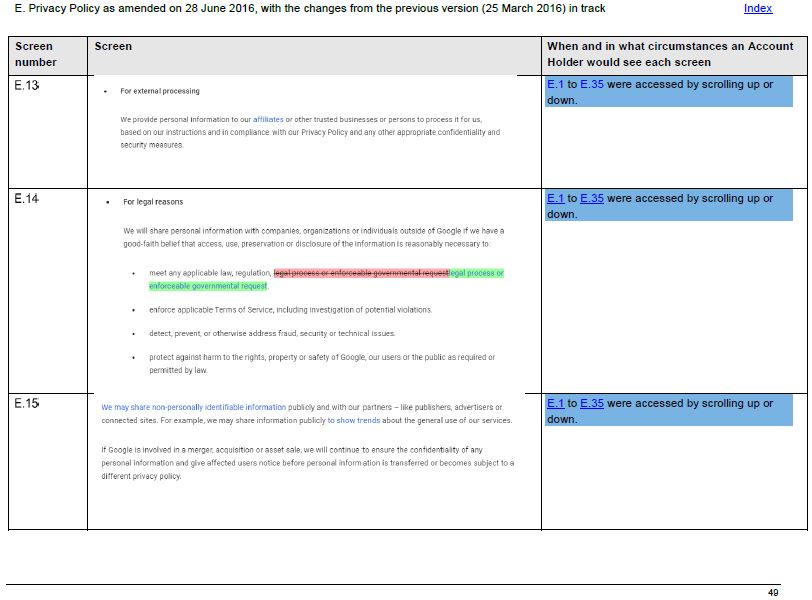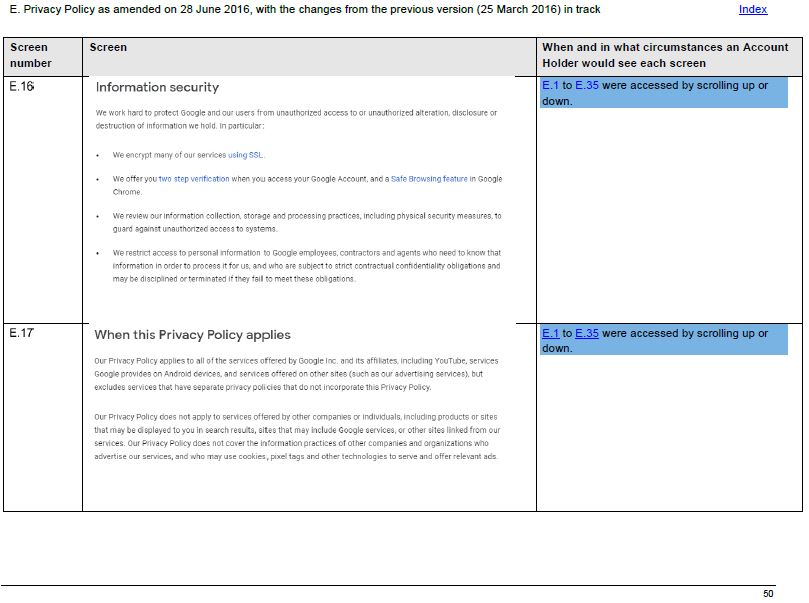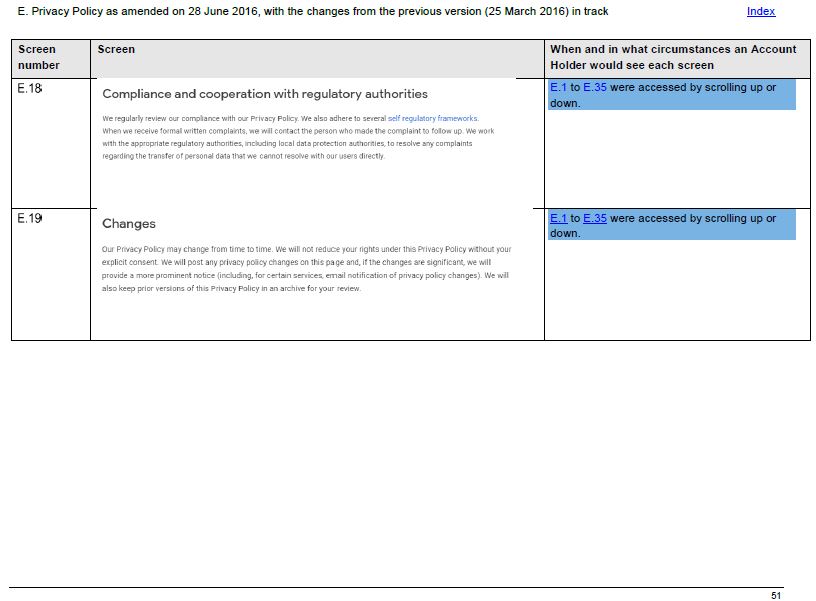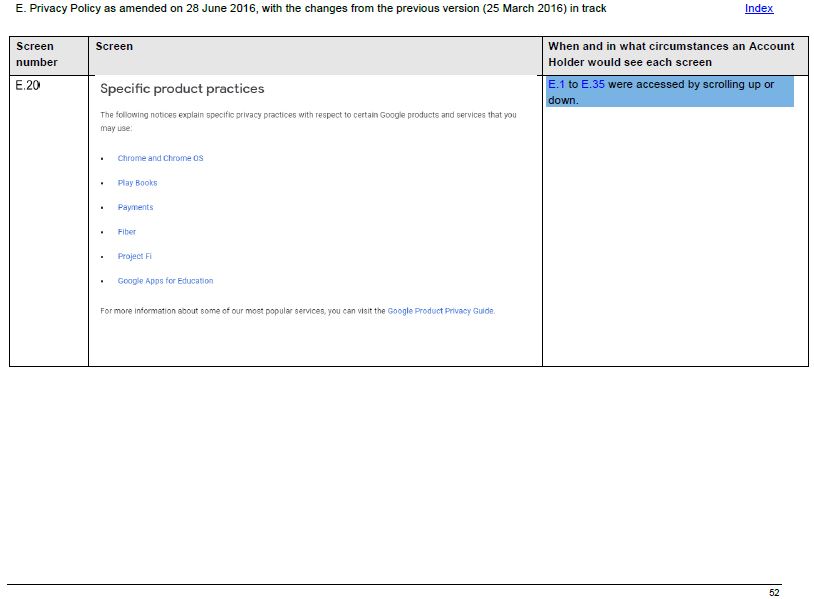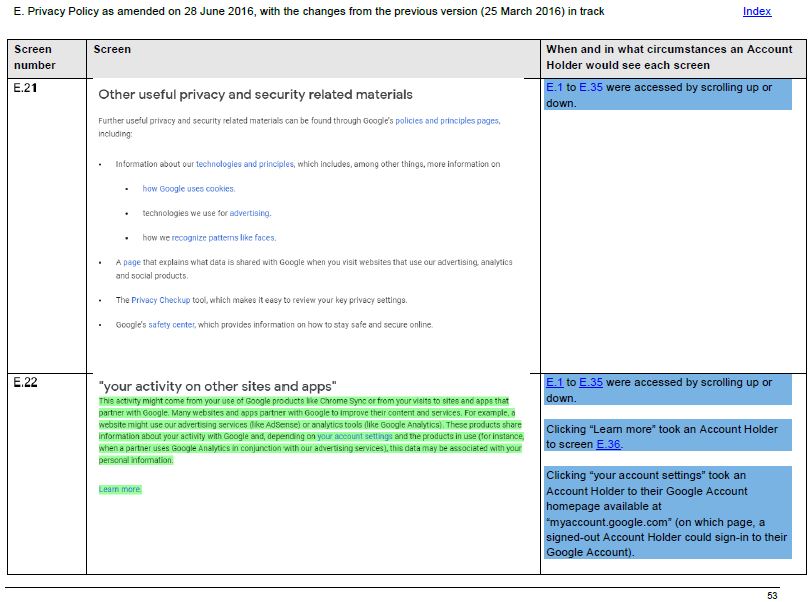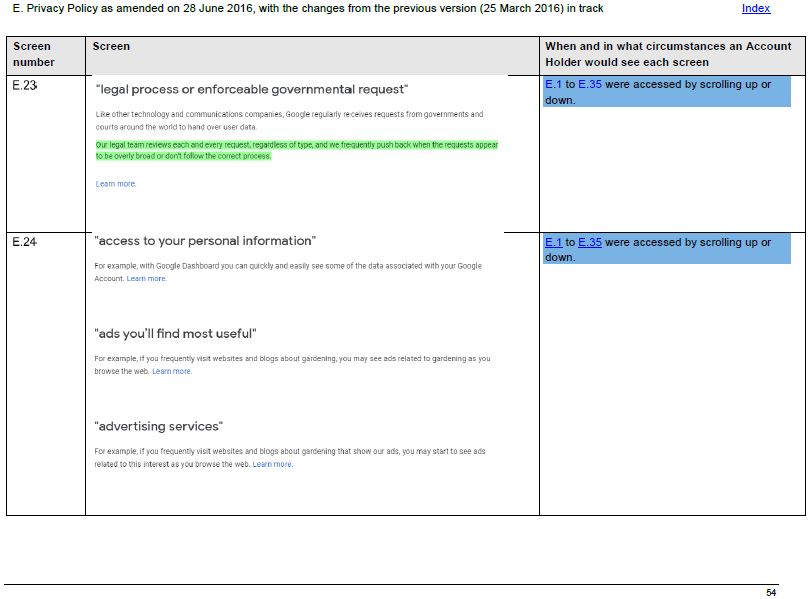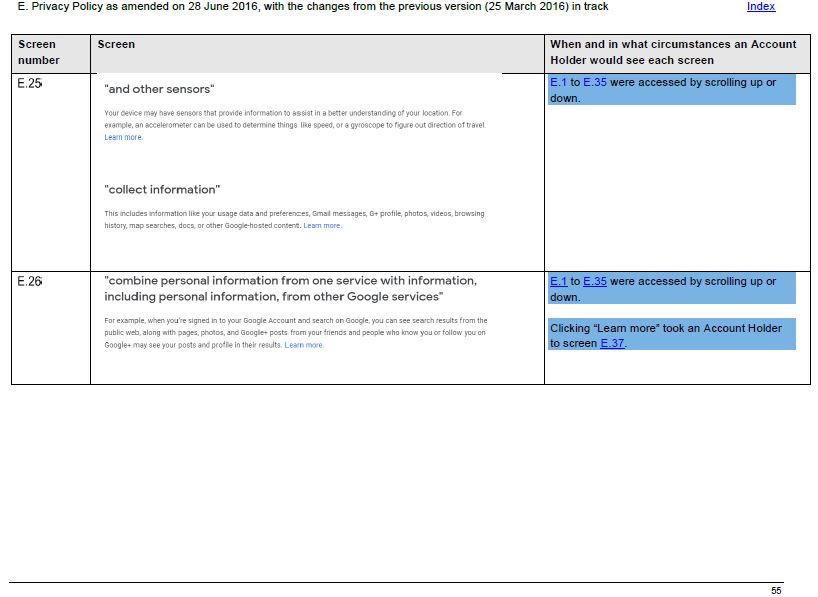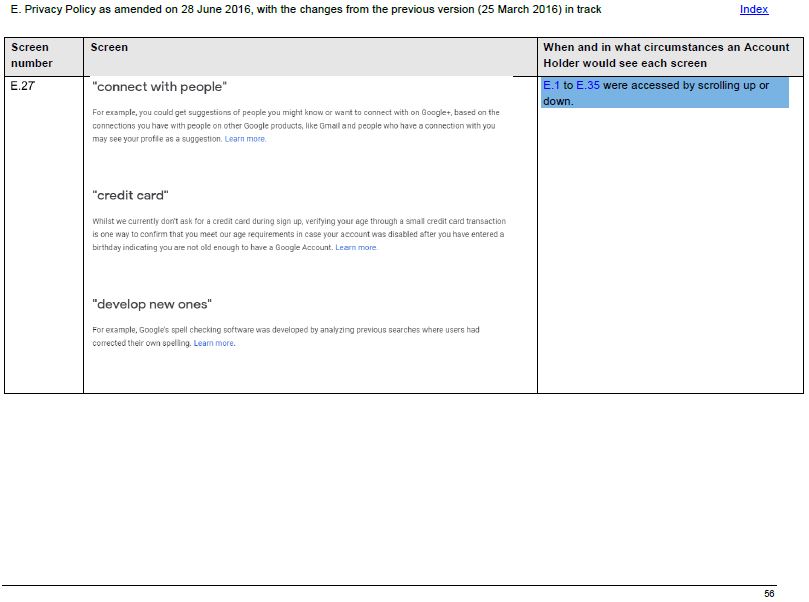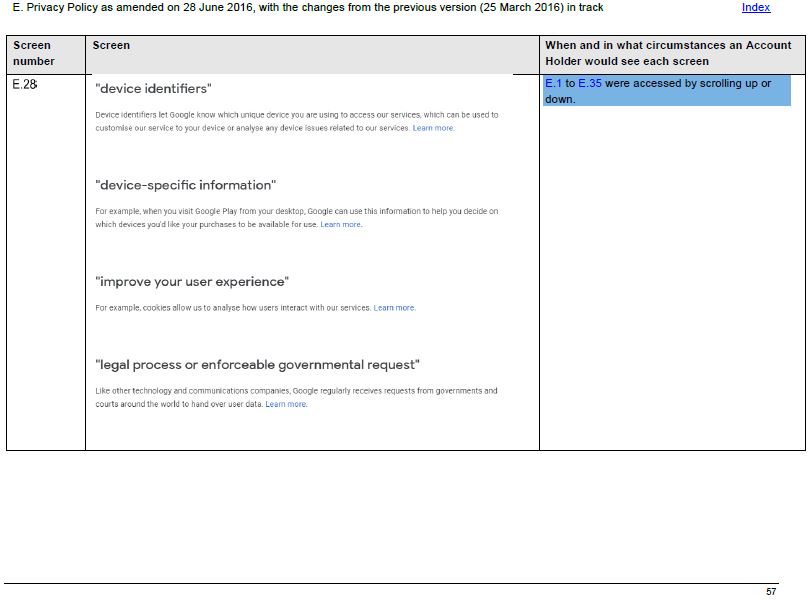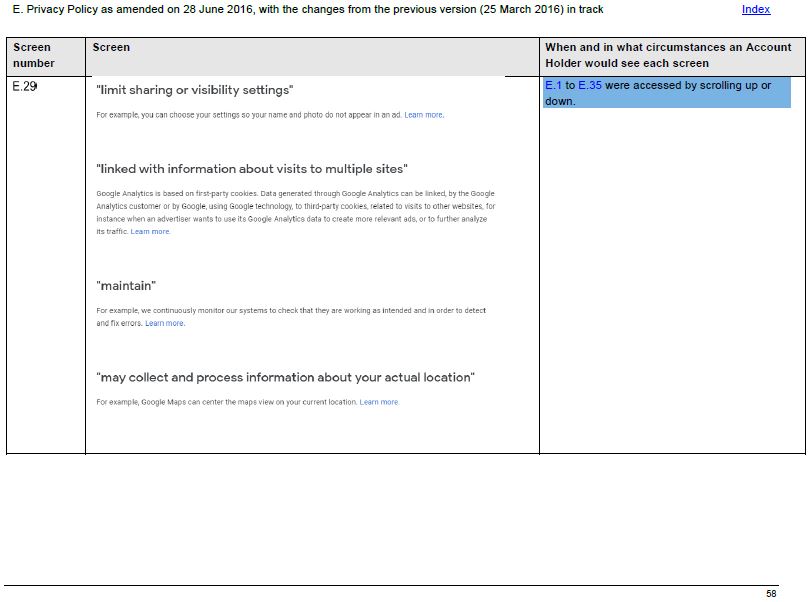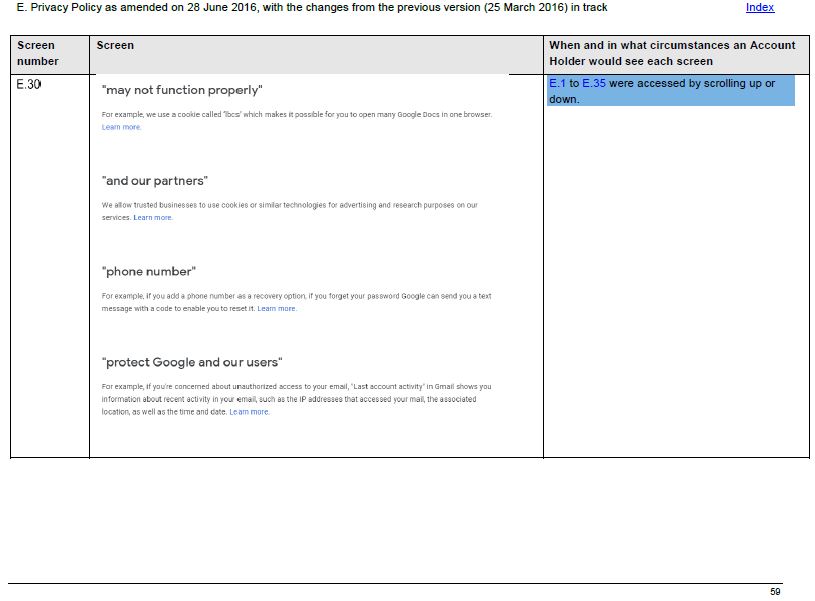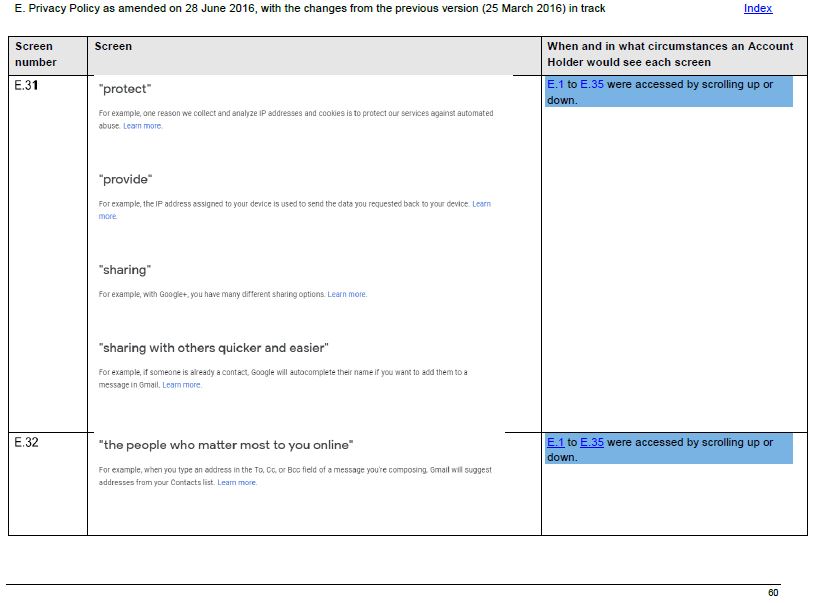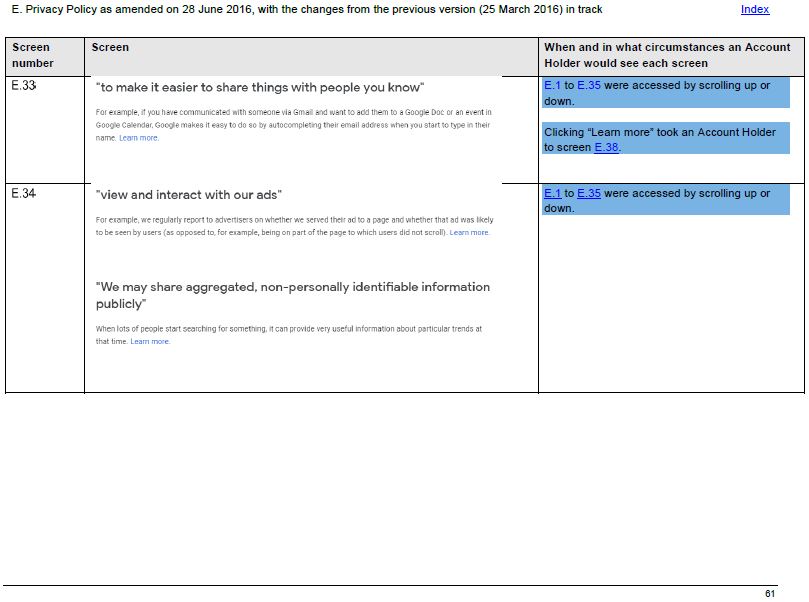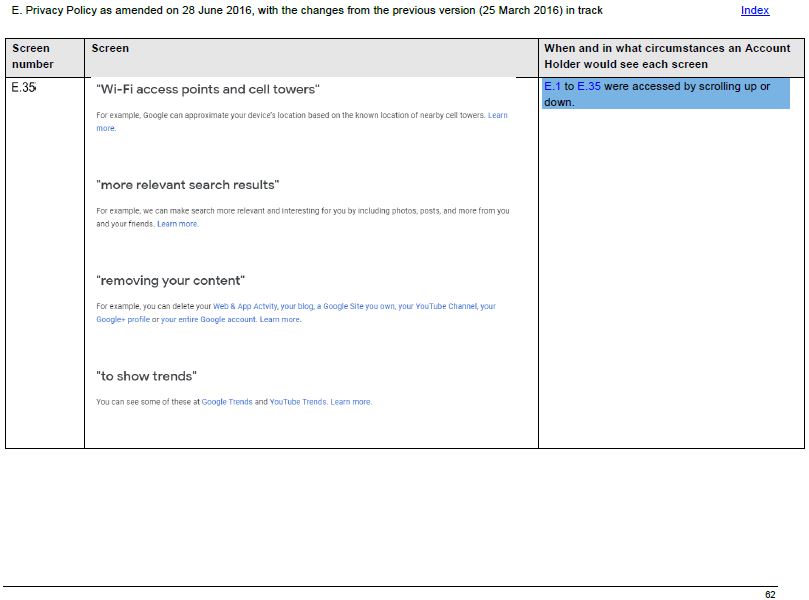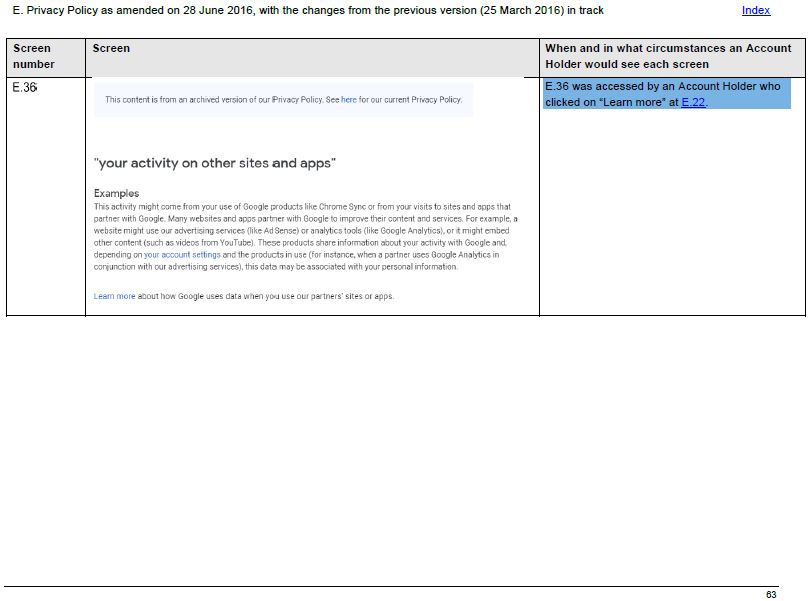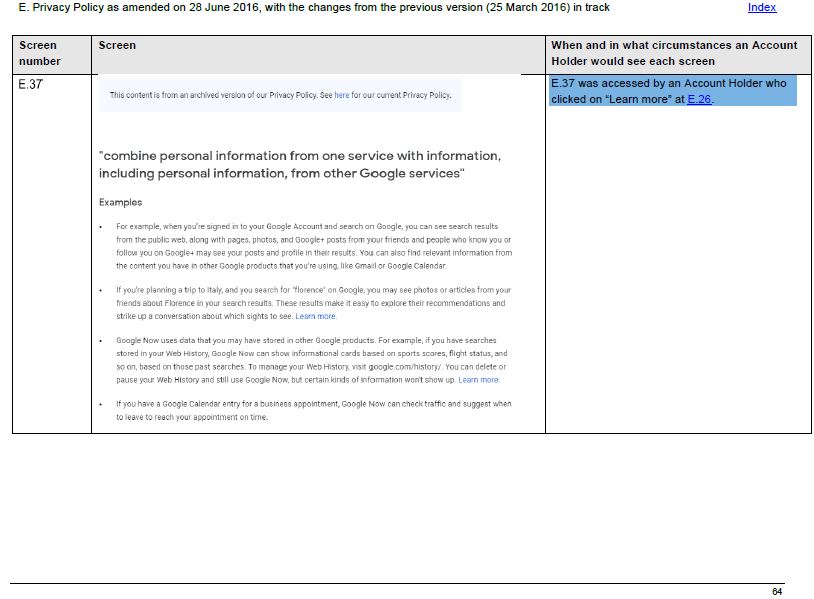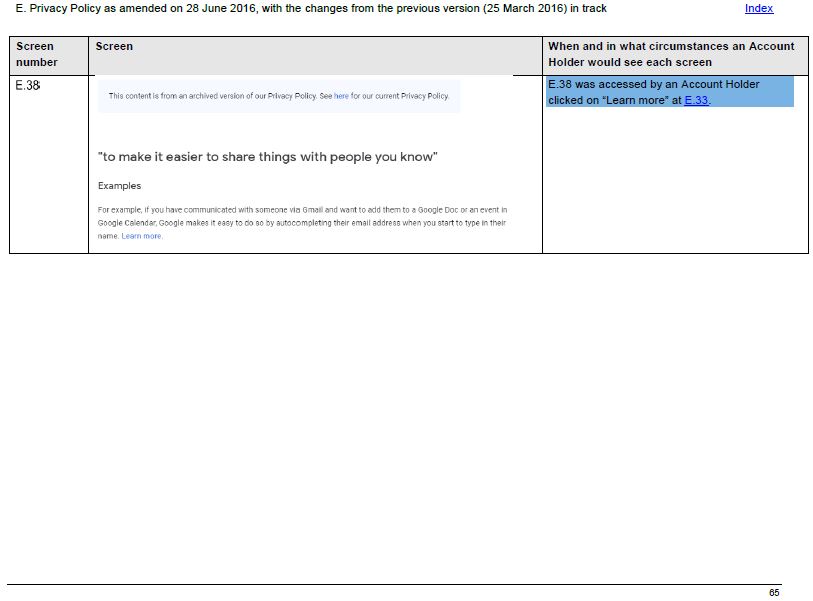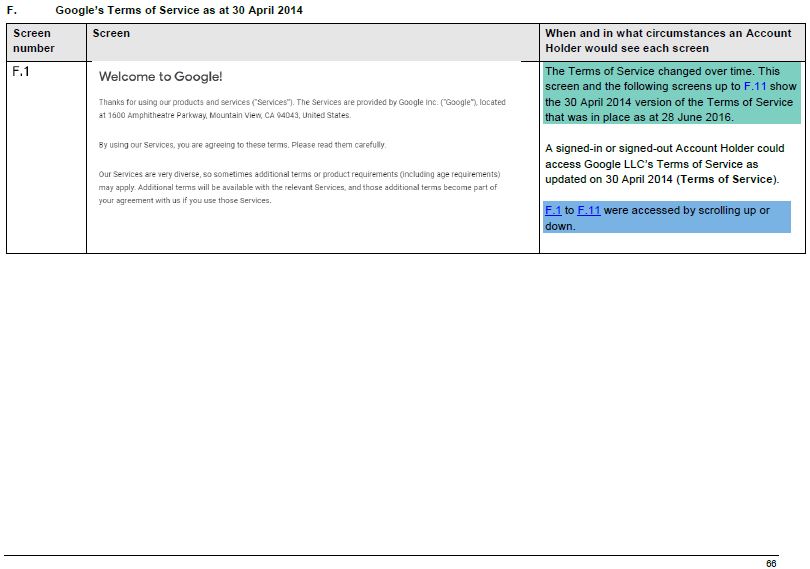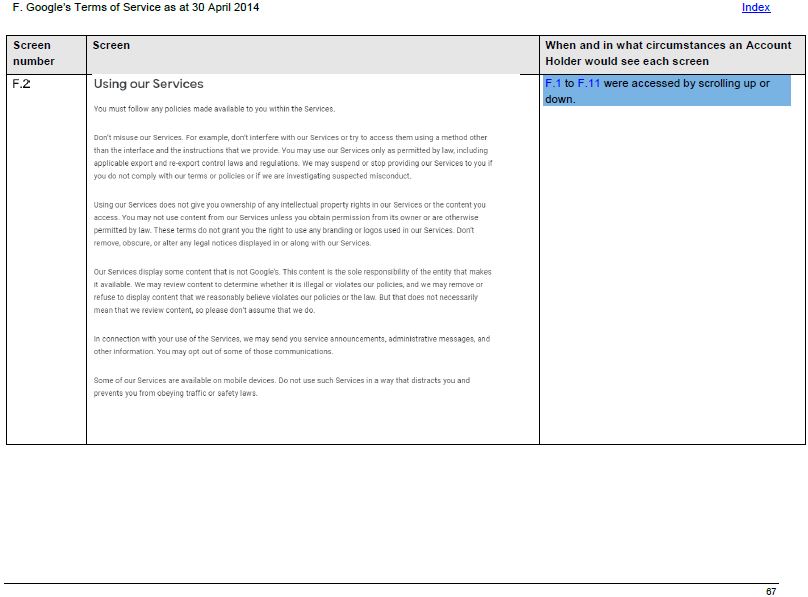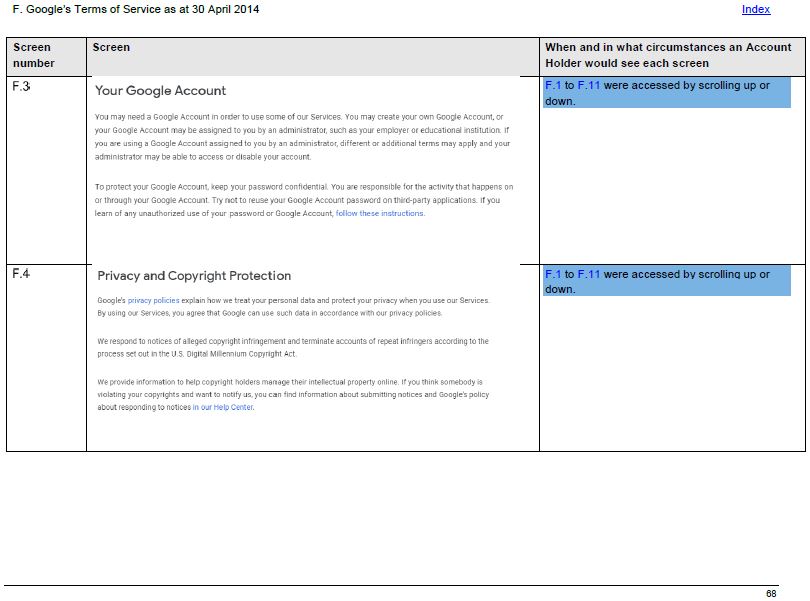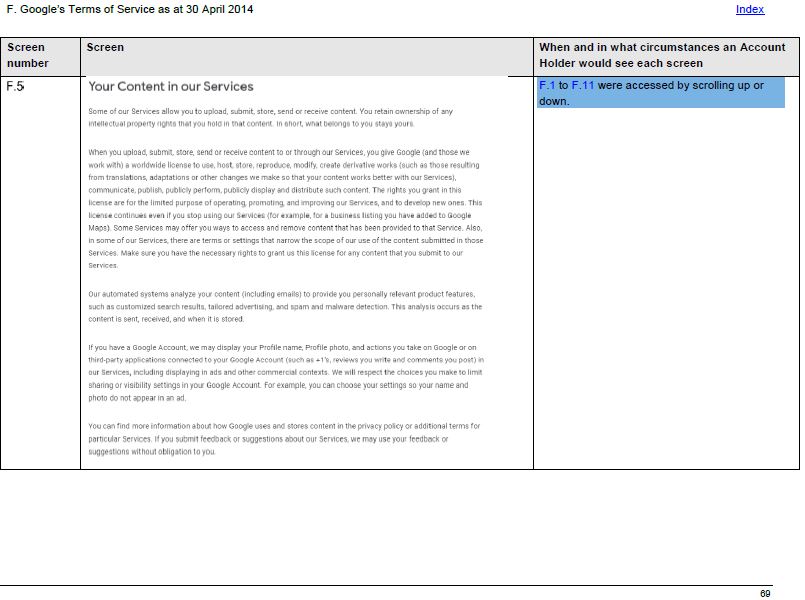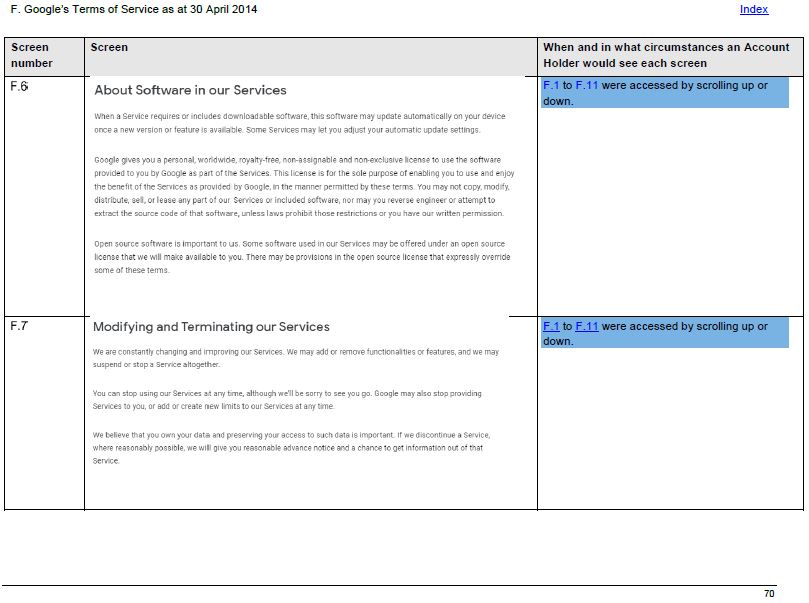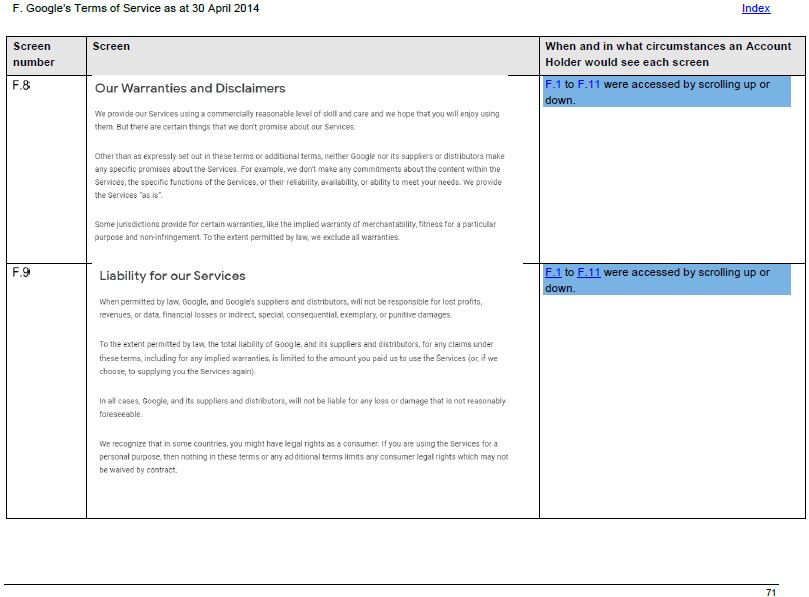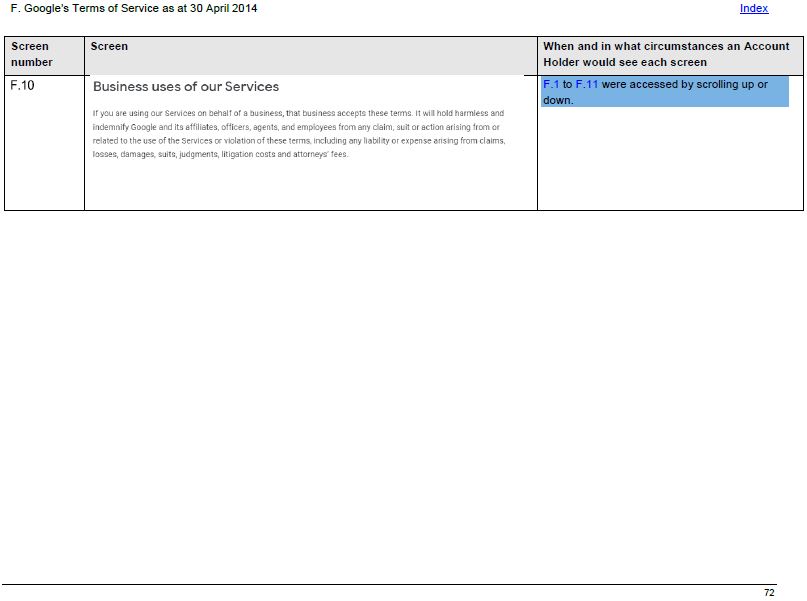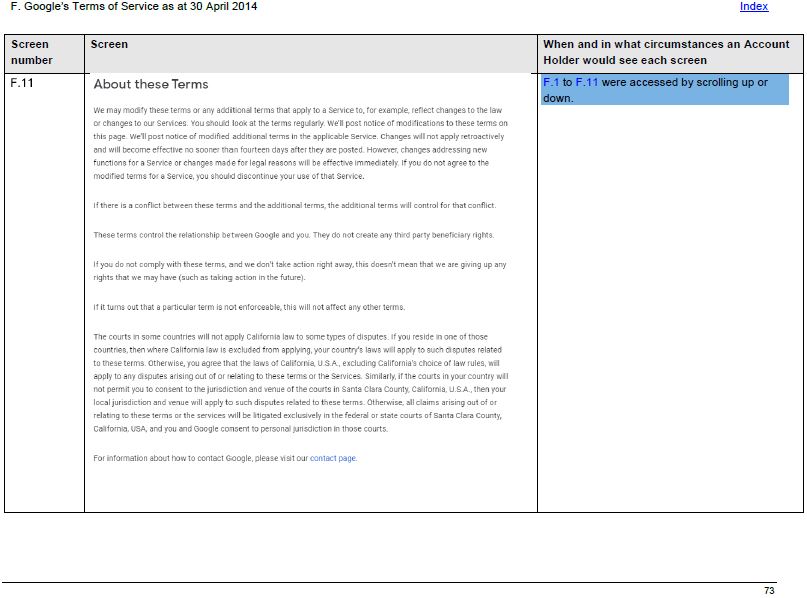Federal Court of Australia
Australian Competition and Consumer Commission v Google LLC (No 2) [2022] FCA 1476
ORDERS
AUSTRALIAN COMPETITION AND CONSUMER COMMISSION Applicant | ||
AND: | Respondent | |
DATE OF ORDER: |
THE COURT ORDERS THAT:
1. The originating application be dismissed.
2. The applicant pay the respondent’s costs.
Note: Entry of orders is dealt with in Rule 39.32 of the Federal Court Rules 2011.
[1] | |
[12] | |
[12] | |
Google’s objections to Associate Professor Payzan-LeNestour’s evidence | [26] |
[41] | |
[52] | |
[53] | |
[56] | |
[63] | |
[64] | |
[67] | |
[71] | |
[74] | |
[80] | |
[84] | |
[89] | |
[123] | |
[134] | |
[150] | |
[150] | |
[150] | |
[163] | |
[164] | |
[165] | |
[177] | |
[186] | |
[222] | |
[225] | |
[227] | |
[237] | |
[257] | |
[259] | |
[260] | |
The Commission’s case based on the Explicit Consent Representation | [269] |
[271] | |
[291] |
YATES J:
1 The applicant, the Australian Competition and Consumer Commission (the Commission), alleges that the respondent, Google LLC (Google), contravened the Australian Consumer Law (the ACL) (Schedule 2 to the Competition and Consumer Act 2010 (Cth)) by:
(a) engaging in conduct that was misleading or deceptive, or likely to mislead or deceive, contrary to s 18 of the ACL;
(b) making false or misleading representations about the services it provided concerning the performance characteristics, uses, or benefits of those services, contrary to s 29(1)(g) of the ACL;
(c) making false or misleading representations about the services it provided in relation to the existence, exclusion or effect of a right, contrary to s 29(1)(m) of the ACL; and
(d) engaging in conduct that was liable to mislead the public as to the nature or characteristics of the services it provided, contrary to s 34 of the ACL.
2 The Commission seeks, amongst other relief, declarations, pecuniary penalties, redress and publication orders, and compliance orders.
3 The conduct in question is alleged to have occurred in the period between 28 June 2016 and at least 10 December 2018 (the relevant period) in connection with a global project which was known within Google as, variously, “Narnia 2.0”, “NS”, “N20” or, simply, “Narnia” (Narnia 2.0). In implementing the project, Google sought the permission of its account holders (Account Holders) to make changes to the settings in their Google Accounts which, if agreed to, authorised Google to:
(a) combine or associate Account Holders’ personal information with their activity on Third Party Websites and Third Party Apps, in addition to combining or associating Account Holders’ personal information with their activity on Google Services;
(b) allow that combined or associated information to be used to create or generate Account-based Advertising for Google Partner Websites and Google Partner Apps; and
(c) deliver Account-based Advertising to signed-in Account Holders on both Google Services and Google Partner Websites and Google Partner Apps on any of their devices.
4 In order to obtain permission to make these changes, Google displayed a notification on the desktop and mobile devices of its Account Holders who had signed-in to their Google Accounts and who had already enabled various settings in respect of those accounts (the Notification). The Notification appeared in different ways depending on the Account Holder’s device and the Google Service that was being used at the time. I will discuss the form and content of the Notification in greater detail below: [89] – [122].
5 The Commission’s case is that the Notification failed to inform, or adequately inform, Account Holders that Google was seeking consent to undertake the activities referred to above and that, according to the Commission, Google had made a change to its Privacy Policy (which I discuss below) (the Notification conduct).
6 The Commission alleges that, as a consequence, Google engaged in conduct that was misleading or deceptive, or likely to mislead or deceive (s 18(1)), and which was liable to mislead the public as to the nature or characteristics of Account Holders’ Google Accounts and Google Services (s 34).
7 The Commission also alleges that, by displaying the Notification, Google represented that it was only seeking the consent of Account Holders to “turn on” new features that would result in:
(a) more information being visible in Account Holders’ Google Accounts, making it easier to review and control that information; and
(b) Google using that information to make advertisements across the internet more relevant to Account Holders,
(the Notification Representations).
8 The Commission alleges that, as a consequence, Google made a false or misleading representation as to the performance characteristics, uses or benefits of Account Holders’ Google Accounts and Google Services (s 29(1)(g)), and engaged in conduct that was misleading or deceptive or likely to mislead or deceive (s 18(1)) or was liable to mislead the public as to the nature or characteristics of Account Holders’ Google Accounts and Google Services (s 34).
9 As to the changes to Google’s Privacy Policy, the Commission alleges that, in the face of an express statement that it would not reduce Account Holders’ rights under the policy without Account Holders’ explicit consent (the Explicit Consent Representation), Google did, in fact, reduce those rights in three ways.
10 The Commission alleges that, as a consequence, Google made a false or misleading representation as to the performance characteristics, uses or benefits of Account Holders’ Google Accounts and Google Services (s 29(1)(g)), and made a false or misleading representation concerning the existence, exclusion or effect of a right in relation to Account Holders’ Google Accounts and Google Services (s 29(1)(m)). The Commission also alleges that, as a consequence, Google engaged in conduct that was misleading or deceptive or likely to mislead or deceive (s 18(1)) and was liable to mislead the public as to the nature or characteristics of Account Holders’ Google Accounts and Google Services (s 34).
11 For the following reasons, I am not satisfied that the Commission has established that Google contravened the ACL as alleged.
12 The evidence comprises a Statement of Agreed Facts dated 12 March 2021, prepared pursuant to s 191 of the Evidence Act 1995 (Cth) (the Evidence Act), and a number of documentary tenders. The Statement of Agreed Facts annexes a collection of screenshots depicting the various forms in which the Notification was given to Account Holders, Google’s Privacy Policy, and Google’s Terms of Service (the Screenshot Bundle). I have reproduced the Screenshot Bundle in Schedule A to these reasons.
13 Each party also called expert evidence. The Commission called Associate Professor Elise Payzan-LeNestour. Google called Professor John List.
14 Associate Professor Payzan-LeNestour is a behavioural scientist who undertook her PhD research at the Swiss Finance Institute at the École Polytechnique Fédérale de Lausanne in 2009 in Neurofinance. She completed the first part of her PhD at the London School of Economics.
15 Associate Professor Payzan-LeNestour commenced as a Senior Lecturer at the University of New South Wales (UNSW) in the School of Banking and Finance in 2010, and was promoted to the position of Associate Professor in 2018. She currently teaches in the Behavioural Finance course offered at undergraduate and Masters levels at the UNSW Business School.
16 As explained by Associate Professor Payzan-LeNestour, Neurofinance is a new kind of behavioural economics that consists of integrating insights from psychological research into economic science. She explained that, while standard behavioural economics focuses on describing how individuals behave, Neurofinance addresses the origins of observed behaviour at the neurobiological level.
17 Associate Professor Payzan-LeNestour also described Neurofinance as a subfield of Neuroeconomics, which involves “the application of insights from decision neuroscience to predict economic behaviour both at the individual and collective/aggregate levels”.
18 According to Associate Professor Payzan-LeNestour, her expertise in Neurofinance encompassed all that concerns individual decision-making under uncertainty: that is, how individuals acquire and process information to form an opinion when they have to decide under uncertainty, and how they make a decision on the basis of their opinion.
19 Associate Professor Payzan-LeNestour prepared two reports, dated 26 July 2021 (first report) and 3 September 2021 (second report) respectively. Her second report responded to a report prepared by Professor List.
20 Among other appointments, Professor List is the Kenneth C. Griffin Distinguished Service Professor in Economics at the University of Chicago and the Distinguished John Mitchell Professor of Economics in the Research School of Economics at Australian National University. He has a PhD in Economics. He is the recipient of a number of Honorary Doctorates. In addition to his academic responsibilities, Professor List is currently the Chief Economist at Lyft Inc. and a Senior Consultant at Compass Lexecon.
21 Professor List said that his research makes extensive use of behavioural economics and experimental economics to evaluate a wide variety of issues, including how individuals make decisions, the external validity of behavioural and experimental economic analysis, the valuation of environmental amenities, education outcomes, and charitable giving.
22 Professor List has received numerous awards for his scholarship, including being named in the “Top 25 Behavioural Economists” by TheBestSchool.org.
23 Professor List’s report is dated 9 August 2021. It responded to Associate Professor Payzan-LeNestour’s first report.
24 Associate Professor Payzan-LeNestour and Professor List prepared a Joint Expert Report. They gave their oral evidence concurrently.
25 No consumer evidence (from Account Holders) was called.
Google’s objections to Associate Professor Payzan-LeNestour’s evidence
26 At the commencement of the hearing, Google objected to the admissibility of Associate Professor Payzan-LeNestour’s reports and to her comments in the Joint Expert Report. Amongst other objections, Google raised a number of “global” objections.
27 One “global” objection was that the questions asked of Associate Professor Payzan-LeNestour (to which her first report was directed) sought an opinion that was not based, wholly or substantially, on her “specialised knowledge”, within the meaning of s 79 of the Evidence Act.
28 There were two aspects to this objection. The first aspect was that Associate Professor Payzan-LeNestour’s opinions were based on her own, non-expert reading of the Notification. The second aspect was that Associate Professor Payzan-LeNestour’s first report was directed, in part, to answering a particular question by reference to “the principles applying to information acquisition and processing in the context of navigating through screens on a desktop or mobile device”. Google submitted that Associate Professor Payzan-LeNestour had no specialised knowledge in relation to that particular matter, and had referred to no such principles in her reports.
29 This objection was made in the following context. On 15 September 2021, I made orders by consent that provided for the convening of a joint conference of experts to prepare a joint report identifying, in summary form, the principal areas of agreement between them, and the principal areas of disagreement between them (including the reasons for that disagreement). The joint report was also to identify whether, and in what respects, the experts’ respective opinions departed from the opinions they had expressed in their reports.
30 By the time these orders were made, Associate Professor Payzan-LeNestour’s two reports had been served. Professor List’s responding report had also been served. Significantly, at that time, Google had not raised any objection that the opinions expressed in Associate Professor Payzan-LeNestour’s two reports were not based wholly or substantially on her specialised knowledge.
31 Pursuant to the orders made on 15 September 2021, Associate Professor Payzan-LeNestour and Professor List met, online, on 5 October 2021 and 15 October 2021, and prepared the Joint Expert Report.
32 The first time that an objection to the admissibility of Associate Professor Payzan-LeNestour’s reports was raised with the Court was in Google’s written opening submissions dated 22 November 2021, five business days before the commencement of the final hearing.
33 Section 192A of the Evidence Act provides the facility for the Court to give a ruling on the admissibility of evidence, in advance of that evidence being adduced, should the Court consider it appropriate to do so. Google did not seek to use that facility, even though the basis for objecting to Associate Professor Payzan-LeNestour’s reports, on the ground that the opinions she expressed were not based wholly or substantially on specialised knowledge, must have been apparent to it relatively shortly after the service of Associate Professor Payzan-LeNestour’s first report in July 2021.
34 There is an oddity in objecting to the admissibility of opinion evidence, on the basis that the opinion is not wholly or substantially based on specialised knowledge, after the party objecting to the evidence has not only engaged, substantively, with the opinion by filing a responding expert’s report, but has also engaged with the opinion through participation, without objection, in a conference of experts directed to preparing a joint report of the kind sought by the orders made on 15 September 2021.
35 The objection that Associate Professor Payzan-LeNestour’s opinions were not based wholly or substantially on her specialised knowledge was not clear cut—although, as I explain in a later section of these reasons, I accept that her opinions proceeded from her own, non-expert reading of the Notification.
36 Google made other “global” objections to the admissibility of Associate Professor Payzan-LeNestour’s reports, including that, should the Court come to the view that Associate Professor Payzan-LeNestour had specialised knowledge relevant to the determination of the matters in issue in the proceeding, her opinions: (a) were not expressed in a manner which permitted the Court to be satisfied that they were based on that specialised knowledge; and (b) trespassed beyond the matters pleaded in the Amended Concise Statement. Once again, the basis for these objections would also have been apparent to Google relatively shortly after the service of Associate Professor Payzan-LeNestour’s first report in July 2021.
37 It is important to note that success on any of these objections would not have led, necessarily, to the rejection of Associate Professor Payzan-LeNestour’s reports, or her comments in the Joint Expert Report, in their entirety.
38 At the time when these objections were raised in opening, I expressed my concern that, in order to rule on them, it would be necessary for me to have a deep understanding of not only Associate Professor Payzan-LeNestour’s first report (which was complex), but also Professor List’s responding report, Associate Professor Payzan-LeNestour’s second report, and the Joint Expert Report. I was concerned that dealing with Google’s “global” objections at that time would be a significant undertaking that would adversely impact on the trial schedule. I suggested that the better course, in the present case, was to admit all the expert evidence, leaving it to the parties to address me in closing submissions on the weight I should give it.
39 Google expressed its concern that, if it acquiesced in that course, it might be taken as consenting to an “enlarged case” which, it contended, Associate Professor Payzan-LeNestour had addressed. In response, I made it clear that I would not countenance any suggestion that the case that Google was required to meet was something other than the case presented in the Amended Concise Statement.
40 In light of that indication, Google did not proceed with its objections. Associate Professor Payzan-LeNestour’s reports, and her comments in the Joint Expert Report, were admitted into evidence accordingly.
41 As the parties recognised, the present case does not involve any novel question of law. The relevant legal principles are well-settled. Nevertheless, the Commission called in aid the following uncontentious principles.
42 First, conduct will be misleading or deceptive if it induces or is capable of inducing error or has a tendency to lead into error: Australian Competition and Consumer Commission v TPG Internet Pty Ltd [2013] HCA 54; 250 CLR 640 (TPG) at [39].
43 Secondly, whether particular conduct is misleading or deceptive is a question of fact to be determined having regard to the context in which the conduct takes place and the surrounding facts and circumstances: Parkdale Custom Built Furniture Pty Ltd v Puxu Pty Ltd [1982] HCA 44; 149 CLR 191 (Puxu) at 198 – 199; Taco Co of Australia Inc v Taco Bell Pty Limited (1982) 42 ALR 177 at 202.
44 In this connection, the Commission submitted that the assessment of Google’s conduct should not be limited to the text of the Notification. Rather, regard should be had to all the surrounding facts and circumstances. The Commission submitted that this included Google’s business records which, the Commission submitted, revealed that the Notification was designed to maximise the number of people who clicked “I AGREE”. The Commission submitted that the Notification was not designed to maximise the number of people who understood the implications of agreeing to Notification. I observe, however, that no such allegation is made in the Amended Concise Statement.
45 Thirdly, the Commission submitted that half-truths may amount to misleading representations. In this connection, the Commission referred to the following passage in Australian Competition and Consumer Commission v LG Electronics Australia Pty Ltd [2017] FCA 1047 (LG Electronics) at [53]:
53 It can readily be accepted that a half a truth may be worse than a blatant lie. A half-truth may beguile the receiver of the half-truth into a false sense that he or she is receiving the whole truth and nothing but the truth – and hence is under the understanding, and reasonable and legitimate expectation, that the person giving the information is presenting all the information necessary for the recipient to act accordingly.
46 Fourthly, the Commission submitted that the conduct in question must be considered by reference to the class of consumers likely to be affected by the conduct.
47 The Commission relied on the following passage from Australian Competition and Consumer Commission v TPG Internet Pty Ltd [2020] FCAFC 130; 278 FCR 450 at [22(e)]:
22 The applicable principles concerning the statutory prohibition of misleading or deceptive conduct (and closely related prohibitions) in the ACL are well known and there was no dispute between the parties concerning those principles. The central question is whether the impugned conduct, viewed as a whole, has a sufficient tendency to lead a person exposed to the conduct into error (that is, to form an erroneous assumption or conclusion about some fact or matter): Taco Co of Australia Inc v Taco Bell Pty Ltd (1982) 42 ALR 177 (Taco Bell) at 200 per Deane and Fitzgerald JJ; Parkdale Custom Built Furniture Pty Ltd v Puxu Pty Ltd (1982) 149 CLR 191 (Puxu) at 198 per Gibbs CJ; Campomar Sociedad, Limitada v Nike International Ltd (2000) 202 CLR 45 (Campomar) at [98]; Australian Competition and Consumer Commission v TPG Internet Pty Ltd (2013) 250 CLR 640 (TPG Internet) at [39] per French CJ, Crennan, Bell and Keane JJ; Campbell at [25] per French CJ. A number of subsidiary principles, directed to the central question, have been developed:
…
(e) … where the impugned conduct is directed to the public generally or a section of the public, the question whether the conduct is likely to mislead or deceive has to be approached at a level of abstraction where the Court must consider the likely characteristics of the persons who comprise the relevant class to whom the conduct is directed and consider the likely effect of the conduct on ordinary or reasonable members of the class, disregarding reactions that might be regarded as extreme or fanciful: Campomar at [101]–[105]; Google at [7] per French CJ and Crennan and Kiefel JJ.
48 Fifthly, and relatedly, the Commission submitted that it is not necessary to approach the analysis of the conduct in question by isolating one hypothetical person within the class who had one response or reaction to the conduct to determine whether there has been a contravention: Australian Competition and Consumer Commission v Google LLC (No 2) [2021] FCA 367; 391 ALR 346 at [87] – [98].
49 In relation to s 18 of the ACL, Google also referred to the first and fourth principles noted above. In addition, it submitted that while conduct which has a tendency to lead a consumer into error might be misleading or deceptive or likely to mislead or deceive, the causing of confusion or questioning is insufficient: Australian Competition and Consumer Commission v Coles Supermarkets Australia Pty Ltd (2014) 317 ALR 73 at [39]. Further, it submitted that whether conduct is misleading or deceptive is a question of fact to be determined objectively. Google accepted that there was no need for the Commission to prove that any person was actually misled or deceived (Puxu at 199) or that Google acted with an intention to mislead or deceive (TPG at [56]).
50 Google submitted that, where conduct is directed to the public at large, or to a section of the public, rather than to identified individuals, the conduct in question should be tested against an ordinary or reasonable member of that class, disregarding assumptions by persons whose reactions are extreme or fanciful. The class does not include consumers who fail to take reasonable care of their own interests: Puxu at 199; Campomar Sociedad, Limitada v Nike International Limited [2000] HCA 12; 202 CLR 45 at [105].
51 Finally, Google submitted that, where the Court is concerned to ascertain the mental impression created by a number of representations conveyed by one communication, it is wrong to attempt to analyse the separate effect of each representation. Rather, the conduct must be viewed as a whole. Viewing isolated parts of the conduct “invites error”: Puxu at 199; Butcher v Lachlan Elder Realty Pty Ltd [2004] HCA 60; 218 CLR 592 at [109]; Campbell v Backoffice Investments Pty Ltd [2009] HCA 25; 238 CLR 304 at [102]; TPG at [52].
52 To appreciate the significance of the changes that Google sought to introduce by Narnia 2.0, it is necessary to understand the nature of the various services that Google provides; the settings presently relevant to the use of Google Accounts by signed-in Account Holders; the information in relation to Account Holders which, before the relevant period, Google was entitled to collect and store; and the information which, before the relevant period, Google was entitled to combine or associate with other information.
53 To create an account with Google (a Google Account), a person is required to create a username and password and to provide personal information, such as the person’s name and date of birth. The person is prompted to provide additional personal information, such as the person’s gender and location. The person is also required to accept Google’s Terms of Service and Privacy Policy. The Account Holder’s personal information is then associated with that person’s Google Account.
54 Google supplies a range of services which include an internet search engine (Google Search); a mapping service (Google Maps); an email service (Gmail); an online video platform (YouTube); an online entertainment store (Google Play); and an internet web browser (Google Chrome) (together, Google Services).
55 Some Google Services, like Gmail and Google Play, require Account Holders to be signed-in to their Google Account to use the service. Other Google Services, such as YouTube and Google Maps, can be used without a Google Account, but may have reduced functionality if an Account Holder is not signed-in to their Google Account when using the service.
56 Google provides online display advertising and analytics services to individuals and businesses. Google derives the majority of its revenue from these services.
57 Online display advertising services connect website and app publishers to advertisers for the purposes of utilising advertising space. The services match the criteria of advertisers with the criteria of the website or app publishers, so as to display advertisements that are likely to be of interest to the person viewing the website or app in question.
58 For present purposes, online display advertising may be classified as Pseudonymous Advertising or Account-based Advertising.
59 Pseudonymous Advertising is informed by the pseudonymous usage history of a particular browser on a particular computer or particular mobile device. The usage history is collected from the browser used on a computer via “cookies” or from the mobile device using equivalent technology.
60 Cookies are small pieces of text sent to a user’s browser by the website that is being visited. The cookies can be configured to record a unique identifier that helps a website remember information about a user’s visit using a particular browser and enables content or advertisements to be delivered (“served”) to users of that browser based on those visits. Cookies (and the equivalent technology on mobile devices and apps) do not require a Google Account to function.
61 Pseudonymous Advertising is tailored to an individual user only to a limited extent. It is informed only by the usage history of a particular browser on a particular computer or particular mobile device. There may be more than one user of the particular browser on the particular computer or the particular mobile device. Further, a person’s usage of their browser on, say, a work computer cannot inform the advertising served to that person on their home computer.
62 Account-based Advertising is informed by information that includes account activity (such as IP address, time/date, URL and advertisements served) stored in an Account Holder’s account. Once again, this information is recorded via cookies on browsers, or equivalent technology (in the case of mobile devices). Unlike Pseudonymous Advertising, Account-based Advertising serves advertisements regardless of the device used. For example, in relation to Google Accounts, Account-based Advertising on an Account Holder’s personal mobile phone or home computer may be informed by that person’s usage on their work computer or mobile phone, if that person is signed-in to their Google Account on all of those devices and has other relevant settings enabled.
Relevant settings and the storage of information
63 The following settings in respect of Account Holders’ Google Accounts are relevant to the present case:
(a) the WAA (Web and App Activity) Setting;
(b) the Ad Personalisation Setting;
(c) the Chrome Sync Setting; and
(d) the SWAA (Supplemental Web & App) Setting.
The WAA and Ad Personalisation Settings
64 The WAA Setting and the Ad Personalisation Setting are enabled by default during the sign-up process for a Google Account. When enabled, the WAA Setting permits Google to store, in association with the Account Holder’s Google Account, information about the activity of the signed-in Account Holder across Google Services, including:
(a) searches in Google Search;
(b) activity in Google Maps;
(c) activity in Google Play;
(d) articles read in Google News;
(e) commands given to Google Assistant and its response;
(f) any advertisements clicked on by the Account Holder; and
(g) data such as an Account Holder’s location, language and IP address.
65 When the Ad Personalisation Setting is also enabled, Google is permitted to deliver Account-based Advertising using that information to the signed-in Account Holder across Google Services.
66 This was the position both before and after 28 June 2016. It is important to note that, both before and after 28 June 2016, Account Holders could access, manage, and therefore change, their WAA Setting and Ad Personalisation Setting.
67 The SWAA Setting can only be enabled if the WAA setting is enabled.
68 If enabled, the SWAA Setting permits Google to associate with the Account Holder’s Google Account, information that includes: (a) certain app data from Android devices on which the Account Holder is signed-in (such as, whether the Account Holder has viewed multiple pages or sections of an app); and (b) the Account Holder’s Chrome internet browsing history (if the Chrome Sync Setting is enabled and the Account Holder has chosen to “sync” that person’s Chrome internet browsing history, as to which see [71] – [73] below).
69 This was the position both before and after 28 June 2016. Once again, it is important to note that, both before and after 28 June 2016, Account Holders could access, manage, and therefore change, their SWAA Setting.
70 Prior to 28 June 2016, information stored because the SWAA Setting was enabled (excluding information collected via the Google Mobile Ads SDK), was not used by Google to serve Account-based Advertising on Google Partner Websites and Google Partner Apps. However, I infer that this information could be used to serve Pseudonymous Advertising on Google Partner Websites and Google Partner Apps.
71 The Chrome Sync Setting enables Account Holders to choose whether Google can associate various aspects of their use of the Chrome internet browser with their Google Accounts, including their Chrome internet browsing history and other “synced” information (for example, bookmarks, passwords, and other settings on the their devices).
72 This was the position both before and after 28 June 2016.
73 During the relevant period, information stored because Chrome Sync was enabled was not used by Google to serve either Pseudonymous Advertising or Account-based Advertising on Google Partner Websites or Google Partner Apps. I infer it could, however, be used to serve advertisements to Account Holders on Google Services.
Other collection and storage of information
74 If websites elect to use Google advertising cookie technology, Google collects information (as Account Holders’ browser settings permit) about users’ and Account Holders’ internet browsing activities on Google Partner Websites via cookies set in the doubleclick.net web domain. This information is stored on a pseudonymous basis in association with an identifier unique to a user’s browser.
75 This was the position both before and after 28 June 2016.
76 If apps elect to use Google Mobile Advertising technology, Google collects information (as Account Holders’ browser settings permit) about users’ and Account Holders’ activities on third-party mobile device-based apps (such as in-app purchases, and views and interactions with in-app advertisements) using the Google Mobile Ads SDK (software development kit).
77 Before 28 June 2016, information collected using the Google Mobile Ads SDK was stored by Google on a pseudonymous basis in association with an identifier unique to the mobile device used, and was used by Google to deliver Pseudonymous Advertising on Google Partner Apps subsequently accessed using that mobile device. The information was not stored by Google in association with Account Holders’ Google Accounts (or any other personal information) without their consent, and was not used to serve Account-based Advertising.
78 This remained the position after 28 June 2016 if Account Holders did not turn on the “new features” in response to the Notification.
79 Prior to 28 June 2016, Google did not combine the information it collected about Account Holders’ activities on Third Party Websites and Third Party Apps with personal information in Account Holders’ Google Accounts, unless Account Holders enabled and permitted Google to do so by means of the Chrome Sync Setting and/or the SWAA Setting.
80 Before 28 June 2016, if the WAA and Ad Personalisation Settings were enabled (as they were by default), Google was permitted to serve Account-based Advertising to Account Holders across Google Services using information based on their activity on Google Services.
81 In addition, if the SWAA Setting was enabled, prior to 28 June 2016, Google was permitted to associate supplementary information with Account Holders’ Google Accounts, which included certain app data and, if the Chrome Sync Setting was enabled and Account Holders had chosen to “sync” data, certain other data including their Chrome internet browsing history, to serve advertisements to them on Google Services.
82 Further, information collected by Google using the Google Mobile Ads SDK was stored by Google on a pseudonymous basis. This information was used by Google to serve Pseudonymous Advertising on Google Partner Apps subsequently accessed using the mobile device.
83 Therefore, before 28 June 2016, the only place where Account-based Advertising was served was on Google Services.
Changes sought to be introduced by Narnia 2.0
84 An internal Google document dated 18 July 2016 described the key goals of Narnia 2.0 as including:
• Holistic identity - Unifying our view of users’ cross-device identity and data across Google’s advertising and consumer products around GAIA. For display ads, we will enable GAIA-Keyed Serving (GKS) for millions of third party properties where Google’s display systems serves ads (e.g. NYTimes, BBC, Farmville, Weather.com’s app etc.).
• Informed consent - Obtaining users’ opt-in consent to unify Display Ads and Google identity per Google’s privacy policy. This consent is the legal and privacy foundation for GAIA-keyed serving, making it the lynchpin of Narnia 2. We get informed consent as part of the new account sign-up process, and via the “consent bump” for existing accounts.
• Better controls - Improving transparency and control for users over how Google uses their data across all their devices. With a signed-in experience, we can be much more transparent sharing user activity and exposing detailed controls. Without signed-in, we never know if a machine is shared. And these controls work only on a single browser or mobile device.
• Improved ad offerings - Building better ads products. Since significant user data at Google is GAIA-keyed data, leveraging this data for display ads will provide opportunities for improved personalization. Moreover, new ads capabilities, such as click-to-buy ads that connect to a user’s Google account, become possible in a GAIA-keyed system. Note: Our Moment of Consent (MOC) launch includes no substantial changes to our ad offerings -- these will come later.
85 The fundamental change introduced by Narnia 2.0, with the Account Holder’s explicit consent, was to expand the use of Account-based Advertising to Google Partner Websites and Google Partner Apps, taking into consideration information about the Account Holder’s activity on Third Party Websites and Third Party Apps stored by Google in association with personal information in the Account Holder’s Google Account.
86 Specifically, if the Account Holder agreed to the proposed changes, the WAA Setting and the Ad Personalisation Setting were enabled to permit Google to serve Account-based Advertising using the information described at [64] above (i.e., information about the activity of a signed-in Account Holder across Google Services) across Google Partner Websites and Google Partner Apps as well as across Google Services.
87 Further, the SWAA Setting (which sat below the WAA Setting) was enabled to permit Google to associate, with the Account Holder’s Google Account, information from Third Party Websites visited when the Account Holder was signed-in to their Google Account, as well as the information referred to at [64] above. From 28 June 2016, this information also included information collected via the Google Mobile Ads SDK. The information stored (because the SWAA Setting was enabled) could be used by Google to serve Account-based Advertising on Google Partner Websites and Google Partner Apps.
88 For new Account Holders (i.e., persons who signed up for a Google Account from 28 June 2016), these changes were enabled by default. The present case, however, is only concerned with the position of those persons who were Account Holders as at 28 June 2016.
89 As I have said, the Notification appeared in different ways, depending on the Account Holder’s device and the Google Service they were using at the time.
90 The Screenshot Bundle shows the various forms in which the Notification was given to an existing Account Holder:
(a) using a web browser on a desktop device or web browser on a mobile device (screens A.1 – A.4 were the screens shown to signed-in Account Holders and screens A.5 – A.17 were the screens shown to Account Holders once signed-in);
(b) during the sign-in process on a non-Android mobile device (screens B.1 – B.6);
(c) during the sign-in process on an Android mobile device (screens C.1 – C.8); and
(d) on an Android mobile device as an Operating System notification (screens D.1 – D.22).
91 The parties advanced screens D.2 – D.5 as representative of the “main body” of the Notification (i.e., that part of the Notification that appeared to Account Holders without the Account Holder clicking additional links). Although four screens are depicted, screens D.2 – D.5 represent, in fact, one page through which Account Holders were required to scroll. This appears to have been the inevitable consequence of limited screen real estate. This page was referred to by the parties and expert witnesses as page 1 of the Notification:




92 Page 1 of the Notification commences with the heading “Some new features for your Google Account” (screen D.2). Icons for the Google Services are depicted above the heading.
93 The text proceeds by referring to the fact that there are some new features for the Account Holder’s Google Account that are “optional” features. The text conveys that the optional features concern how Google collects and uses data, and the control which the Account Holder has in respect of that data. The text also conveys that this relates to advertisements that Google shows to the Account Holder.
94 The question is posed: “What changes if you turn on these new features?” The use of the word “if” reiterates that the new features are optional for the Account Holder. As the Account Holder scrolls down page 1, the question is answered by reference to the numbered headings depicted in screens D.3 and D.4 and the text appearing under those headings.
95 The first numbered heading (screen D.3) refers to the fact that, if the Account Holder turns on the new features, more information will be available in the Account Holder’s account which, it is said, will make it easier for the Account Holder to review and control. The reference to the availability of “more” information in the Account Holder’s Google account is then explained.
96 In this connection, the Account Holder is told that, when they use Google Services, data is generated and that this data can be found and controlled by the Account Holder using the WAA Setting. Importantly, however, the Account Holder is also told that, “with this change”—clearly a reference to the change for which Google was seeking consent—other data may be included, namely the Account Holder’s browsing data from Chrome and data from their activity on websites and apps that partner with Google, including those that show ads from Google. It is important to note that, here, Google is addressing the Account Holder personally and referring to the Account Holder’s personal activity, not someone else’s browsing activity.
97 The diagram under the first numbered heading shows data from the Account Holder’s browsing activity on a mobile phone, tablet device, and a computer going into the Account Holder’s Google Account. The Account Holder’s Google Account is represented by some of the icons that depict Google Services, as well as the Google Account Holder icon (or “avatar”) itself.
98 The second numbered heading (screen D.4) tells the Account Holder that “this information” (obviously meaning all the information collected by Google as discussed in relation to the first numbered heading) will be used by Google to “make ads across the web more relevant for you [the Account Holder]”.
99 As to this, the Account Holder is told that the Ad Personalisation Setting “currently” allows Google to use data in the Account Holder’s account to tailor ads that appear in Google “products”. This is a reference (although not by name) to the Account-based Advertising served by Google when the Account Holder is using Google Services.
100 Importantly, however, the Account Holder is told that, “with this change” the Ad Personalisation Setting will allow Google to use the data in the Account Holder’s Google Account to tailor advertisements on websites and apps that partner with Google. In other words, if the Account Holder turns on the new features, all the data that would then be available in the Account Holder’s Google Account will also be used in this way.
101 The diagram under the second numbered heading shows the expanded data in the Account Holder’s Google Account serving advertisements to a mobile phone and a computer (representing the Account Holder’s signed-in devices).
102 The Account Holder is also told that these settings will apply across all of their signed-in devices, but that “you [the Account Holder] can change them [the settings] at any time” (screens D.4 and D.5).
103 Then, the question is posed: “What’s still the same?” The Account Holder is told that the practice of their personal information not being sold to anyone, and their ability to control the types of information Google collects and uses, will remain the same.
104 Finally, the Account Holder is told to choose the “I AGREE” button to turn on the new features or to click the “MORE OPTIONS” button for “more choices and information”.
105 I have used screens D.2 – D.5 as the starting point for my analysis of the Notification. It is appropriate that I record the following further facts concerning the form and structure of the Notification in the various forms in which it was provided to Account Holders.
106 Signed-in Account Holders using a web browser on a desktop or web browser on a mobile device received an alert shown in screens A.1 – A.3 of the Screenshot Bundle. If Account Holders chose “Learn More”, they were shown the Notification in screens A.5 and A.6. However, Account Holders did not have to choose “Learn More”. Account Holders could navigate away from the alert.
107 Account Holders with a non-Android device were shown the Notification in screens B.3 – B.5 during the sign-in process to their Google Accounts.
108 Account Holders with a mobile device using the Android Operating System (Android device) were shown the Notification in screens C.4 – C.6 during the sign-in process to their Google Account.
109 Account Holders with an Android device may have been alerted to the Notification with an Android Operating System prompt shown in screen D.1 of the Screenshot Bundle. If Account Holders tapped on the prompt, they were shown the Notification set out in screens D.2 – D.5 (for Account Holders who had not enabled the Chrome Sync Setting) or screens D.6 – D.9 (for Account Holders who had enabled the Chrome Sync Setting).
110 If Account Holders selected “MORE OPTIONS”—as shown in screen A.6 (for Account Holders using a web browser on a desktop or a web browser on a mobile device (including a non-Android device)), screen D.5 (for Account Holders using an Android device who had not enabled Chrome Sync and saw the Notification as an Operating System notification), and screen D.9 (for Account Holders using an Android device who had enabled Chrome Sync and saw the Notification as an Operating System notification)—they were shown a new page titled “Choose what’s right for you”, which contained a link titled “Learn more about these features”.
111 For Account Holders:
(a) who were using a web browser on a desktop or mobile device (including a non-Android device), this was shown in screen A.7; or
(b) who were using an Android device, this was shown in screen D.10.
112 Account Holders who were shown the Notification in the form of screens B.3 – B.5 (i.e. the Notification shown to existing Account Holders during the sign-in process on a non-Android device) and screens C.4 – C.6 (i.e. the Notification shown to existing Account Holders during the sign-in process on an Android device), were given the option to select “Ask me later” (rather than “MORE OPTIONS”).
113 If Account Holders selected “Learn more about these features”, as contained in screen A.7 (for Account Holders who were using a web browser on a desktop or web browser on a mobile device (including a non-Android device)), and screen D.10 (for Account Holders using an Android device and who saw the Notification as an Operating System notification), they were shown a new webpage titled “More about these new features”, which provided them with links to obtain additional information.
114 For Account Holders:
(a) using a web browser on a desktop or web browser on a mobile device (including a non-Android device), this was shown in screen A.11; and
(b) using an Android device, this was shown in screen D.14.
115 After reviewing the “Choose what’s right for you” page, on screen A.7 (for Account Holders using a web browser on a desktop or web browser on a mobile device (including a non-Android device)) and screen D.10 (for Account Holders using an Android device and who saw the Notification as an Operating System notification), Account Holders could select “BACK” to return to the Notification, as displayed on screen A.5 (shown to Account Holders once signed-in), screen D.2 (if the Account holder had not enabled Chrome Sync), or screen D.6 (if the Account Holder had enabled Chrome Sync), or they could select one of the three options listed and click “Done” or “Continue”.
116 Account Holders selecting one of the three options on the “Choose what’s right for you” page:
(a) using a web browser on a desktop or web browser on a mobile device (including a non-Android device), were shown screens A.8 – A.10;
(b) using an Android device were shown screens D.11 – D.13.
117 Similarly, if Account Holders clicked on “Learn more” (which appeared before “about these features” and under the subheading “2. Google will use this information to make ads across the web more relevant for you”) in screen A.6 (for Account Holders who were using a web browser on a desktop or web browser on a mobile device (including a non-Android device)), screen B.4 (for Account Holders using a non-Android device and who were shown the Notification during the sign-in process), screen C.6 (for Account Holders using an Android device and who were shown the Notification during the sign-in process), screen D.5 (for Account Holders using an Android device who had not enabled Chrome Sync and who saw the Notification as an Operating System notification), and screen D.9 (for Account Holders using an Android device who enabled Chrome Sync and who saw the Notification as an Operating System notification), they were shown the webpage titled “More about these new features”.
118 For Account Holders:
(a) using a web browser on a desktop or web browser on a mobile device (including a non-Android device), this was shown in screen A.11;
(b) using a non-Android device who had enabled Chrome Sync, this was shown in screen B.6 (Account Holders using a non-Android device who had not enabled Chrome Sync, were shown a screen similar to B.6 that did not include the drop-down heading titled “How does this change affect your synced Chrome browsing history?”); and
(c) using an Android device who had enabled Chrome Sync, this was shown in screens C.8 and D.14 (Account Holders using an Android device who had not enabled Chrome Sync, were shown a screen similar to C.8 and D.14 that did not include the drop-down heading titled “How does this change affect your synced Chrome browsing history?”).
119 If Account Holders selected “I AGREE” to the Notification, changes were made to their settings that permitted Google to combine the information it collected about their activity on Third Party Websites and Third Party Apps with their personal information. These changes included:
(a) the SWAA Setting being enabled or the functionality of the SWAA Setting being expanded (if the Account Holder had already enabled the SWAA Setting); and
(b) a new feature of the Ad Personalisation Setting (i.e. a checkbox labelled “Also use your activity & information from Google services to personalize ads on websites and apps that partner with Google to show ads”) being enabled that permitted Google to serve Account-based Advertising on Google Partner Websites and Google Partner Apps to the Account Holder.
120 In relation to Account Holders who clicked “I Agree” or “Yes, I’m in – turn on these new features” and “Done” to accept the new features, Google considered itself authorised to:
(a) combine or associate Account Holders’ personal information with their activity on Third Party Websites and Third Party Apps, in addition to combining or associating their personal information with their activity on Google Services; and
(b) allow that combined or associated information to be used to create or generate Account-based Advertising for Google Partner Websites and Google Partner Apps; and
(c) deliver Account-based Advertising to signed-in Account Holders on both Google Services and Google Partner Websites and Google Partner Apps on any of their devices.
121 An internal Google document makes clear what Google was trying to convey to Account Holders by the Notification:
We’re trying to emphasize a couple key points that we really want the user to understand.
⸰ First, that a user’s activity information on 3rd party sites and apps will now be associated with their account and not, say, a browser cookie or mobile identifier.
⸰ And second, that their account information, including this “web traversal” or “app traversal” data, will be used to improve the ads the user sees on 3rd party sites and apps.
122 As Senior Counsel for the Commission put the matter in closing submissions (with reference to this document):
The debate between us is that we say the [N]otification did not actually tell users that that was what was happening.
123 The Commission’s case on the Notification has two aspects—the Notification Conduct and the Notification Representations.
124 The case with respect to the Notification Conduct is advanced in the Commission’s Amended Concise Statement as one of omission:
26 In relation to Account Holders who clicked “I Agree” or “Yes, I’m in – turn on these new features” and “Done” to accept the ‘new features’ (Turned on the New Features), Google considered itself authorised to:
(a) combine or associate the Account Holder’s personal information with their activity on Third Party Websites and Apps, in addition to combining or associating the Account Holder’s personal information with their activity on Google Services;
(b) allow that combined or associated information to be used to create or generate personalised advertisements for Google Partner Websites and Apps; and
(c) deliver those advertisements to signed in Account Holders on both Google Services and Google Partner Websites and Apps on any device.
27 By the Notification, Google failed to inform, or adequately inform, Account Holders that:
(a) Google had made the June 2016 Privacy Update to the Privacy Policy; and
(b) Google was seeking the Account Holder’s consent to be able to undertake the matters set out in paragraph 26 above,
(the Notification Conduct).
125 The Commission contends that Google’s conduct, in publishing the Notification, was misleading or deceptive in that it had the tendency to lead to a reasonable and legitimate expectation or understanding by Account Holders that the information being presented about the positive changes to their access to the data that Google was collecting, was all the information that was necessary for them to consider.
126 In opening its case, the Commission advanced five principal submissions in support of this contention.
127 First, the Commission submitted that the Notification did not say that Google would now combine the personal information in Account Holders’ Google Accounts with information about their activities on Third Party Websites and Third Party Apps. The Commission submitted that, although Account Holders were told that “more information will be available in your Google Account, making it easier for you to review and control” and that “Google would use this information to make ads across the web more relevant for you” (see, for example, screens D.3 and D.4), Google did not explain that the additional data it would be collecting would be data about the Account Holder’s activity on Third Party Websites and Third Party Apps. The Commission also submitted that Google did not explain that it could serve more targeted advertisements because it was collecting that information and combining it with the Account Holder’s personal information.
128 Secondly, the Commission submitted that the “new features” to which the Notification referred (see, for example, screen D.2) were described “beneficially to the Account Holder”. The Commission submitted that, by framing the Account Holder’s choice in this way, Google suggested that the changes were for the sole benefit of the Account Holder, such that adopting the changes would enhance the Account Holder’s use of Google without any cost or effect on the Account Holder more specifically. The Commission did not expand on what the other “cost or effect” was beyond the fact that Google would be using the combined information to show the Account Holder “more relevant ads”. The significance of this submission to the case articulated in the Amended Concise Statement is not apparent.
129 Thirdly, and relatedly, the Commission submitted that the language used to describe the detail of the first feature (“more information will be available in your Google Account, making it easier for you to review and control”) would have left Account Holders with the impression that the change was about the Account Holder’s access to information and data that Google was already collecting, and not that Google was collecting and combining additional information and data. In other words, the Notification did not indicate that the “more information” was information that Google had not previously associated with the Account Holder’s Google Account. Rather, the suggestion was that this was information that had not previously been available to the Account Holder to review.
130 Fourthly, the Commission submitted that, to the extent that Google informed Account Holders that their activities on other sites and apps would be associated with their personal information, it was only framed as beneficial for the second feature, namely “in order to improve Google’s services and the ads delivered by Google”. Once again, the Commission did not expand on this submission. Its significance to the case articulated in the Amended Concise Statement is not apparent.
131 Fifthly, the Commission submitted that the Notification did not inform Account Holders that there was a change to Google’s Privacy Policy. As I have noted, there is no dispute about this fact. There is, however, a dispute as to the effect of the June 2016 Privacy Update—a matter to which I will return.
132 In support of its submissions, the Commission relied on certain findings recorded in internal Google documents about the user testing which Google undertook as part of Narnia 2.0, and on the evidence given by Associate Professor Payzan-LeNestour.
133 It is convenient to turn to that evidence now.
134 The Commission tendered certain documents that Google had produced in response to compulsory notices and orders for discovery. These documents reveal that, in the period before June 2016, Google perceived that there was significant commercial value in being able to combine the data available to it about Account Holders’ activity on Google Services with the data available to it about those Account Holders’ activity on Third Party Websites and Third Party Apps. Google saw its (then) inability to combine and use this data as limiting the scope of the advertising services it could provide to advertisers.
135 These constraints stemmed from Google’s adherence to a previous commitment given by DoubleClick Inc—a supplier of ad-serving technology services which Google acquired in 2008—not to combine a user’s web-traversal cookie data with their personally identifiable information, without obtaining the user’s explicit consent. Narnia 2.0 sought to overcome this constraint, so as to enable Google to expand its ability to serve Account-based Advertising to Account Holders.
136 An aspect of Narnia 2.0 was the development of a “Consent Bump” (i.e., a notification directed to Account Holders seeking their consent to Google combining and using all this information). Obtaining Account Holders’ consent was, obviously, a matter of commercial significance for Google. The documents reveal that, by obtaining Account Holders’ consents, Google would increase its advertising revenue significantly.
137 Google carried out extensive market research and user testing in relation to the text and format of the “Consent Bump”. This testing was carried out in the United States of America, Germany, Japan, and the United Kingdom in 2015 and 2016 to ascertain: (a) users’ feelings about the changes, including the way in which data was to be collected and stored; (b) users’ comprehension of the notification that was being tested as the “Consent Bump”; and (c) the design and format of a “Consent Bump” that would make it more likely that users would “click” on the option to agree. In one document, Google expressed its aim as being to “Maximise conversion”. It was “Designing for Consent”.
138 The Commission places reliance on Google’s analysis and conclusions in respect of the user testing it was carrying out. In particular, it points to findings (expressed in various documents) that:
(a) participants did not have a good understanding of the information and data that existed across their various devices and the existing user control settings before the proposed changes;
(b) most users did not understand that the change would result in a combination of their data;
(c) in the absence of a clear yes/no choice, users felt that they did not have a choice whether or not to agree to the notification; and
(d) participants paid limited attention to the text of the Consent Bump, and most participants continued without reading the text closely.
139 However, the text and format of the Consent Bump developed over time in response to this testing and Google’s analysis of the test results.
140 The Commission appears to suggest that, in designing the text and format of the Consent Bump, Google was acting untowardly. For example, it relies not only on the fact that Google was “Designing for Consent” but also on the fact that, as versions of the “Consent Bump” involved, Google removed references to its Privacy Policy and to the word “privacy”. The Commission suggests these references were removed because testing indicated that Account Holders were less likely to consent to the proposed changes when the text of the notification referred to a change that affected their privacy.
141 The Commission contends that Google was designing the “Consent Bump” to maximise the number of Account Holders who checked “I AGREE” rather than to maximise the number of Account Holders who understood the implications of agreeing to the changes that were proposed. The Commission seeks to derive support for this contention from Associate Professor Payzan-LeNestour’s evidence, which I discuss in the next section of these reasons.
142 It was here that the Commission advanced the uncontroversial proposition that a half-truth may be a misleading representation: LG Electronics at [53]. This precept is the cornerstone of the Commission’s case in respect of the Notification Conduct.
143 I should say now that I am not persuaded that, in designing the “Consent Bump”, Google was acting in an untoward way. Google does not dispute that it was in its interests for Account Holders to respond to the Notification by consenting to the changes that Google wanted to implement. However, as Google points out, it is hardly surprising that it wanted Account Holders to consent. The fact that Google was seeking that consent must have been apparent to Account Holders on reading the Notification. Plainly, that is what the Notification was asking Account Holders to do—to consent to the changes that Google wanted to implement. That said, Account Holders were given the choice as to whether they should give consent.
144 On the basis of other documents tendered by the Commission, I am satisfied that, in “Designing for Consent”, Google was seeking to design a “Consent Bump” which gave Account Holders the information necessary to understand the changes that Google wanted to make so that, if consent was given, it was given on an appropriately informed basis. For example, in relation to the document in which Google expressed its desire to “Maximise conversion”, Google also referred, unequivocally, to its objective to obtain “informed consent”.
145 I also observe that, in “Designing for Consent”, with the objective of obtaining informed consent, Google recognised that its Account Holders comprised a range of individuals who it classified as “Skippers, Skimmers and Readers”. The documents reveal that Google understood that the “Consent Bump” had to be worded so as to cater for all these individuals.
146 Google’s appreciation that its Account Holders comprised “Skippers, Skimmers and Readers” explains why the Notification was presented in a way that provided links to enable Account Holders to obtain more information in relation to Google’s proposal, should that have been their desire when considering the Notification. In its internal documents, Google described this as presenting a “layered story”. This is a pithy way of explaining the cascading form of the Notification, with the increasing levels of detail described at [89] – [122] above.
147 In a document entitled “Narnia 2.0 Town Halls; Sridhar Intro: Transparency, Control, and an Identity-based Platform for Display Advertising”, Google explained:
…we’ve found through research that the group of users who don’t immediately want to agree are a nuanced group. So instead of offering a simple “no”, we’ve developed a few options that we feel will best address the desires of these users:
… First, some users may need additional details around how this new option works - what data we’re talking about, how their controls work, and more. Users who read this information are now empowered to make a better choice. Of course, there are some users who want to get on their way - selecting “no” and moving on is the first choice we offer here. And for some users, the best thing we can do for them is give them the option to view these changes in context by taking them to the Privacy Checkup …
148 In a document entitled “Comm Doc: Signed-In Ads (Global Consent) Messaging for Sales”, Google summarised the final results of its testing:
We’ve done extensive qualitative testing of the consent flow around the world, and the testing suggests that many users will choose to try out the new experience, though some users will decline. The ratios will vary regionally based on users’ attitudes about Google, privacy, and advertising. Our goal is simply to explain the update as clearly as we can and let users make a choice. We hope most will give the new approach a try, but it’s important that those who aren’t comfortable with the change have the chance to keep things the way they are.
149 In relation to the Notification Conduct, the only question is whether, by omission, Google’s conduct in asking for consent, through the medium of the Notification, was misleading or deceptive (or likely to mislead or deceive), or liable to mislead the public, in the specific ways alleged by the Commission in the Amended Concise Statement.
Associate Professor Payzan-LeNestour’s first report
Behavioural science principles
150 Associate Professor Payzan-LeNestour’s first report proceeded on the basis of 12 identified principles. She described these principles as well-established behavioural science principles which were “most obviously relevant” to understanding the decision-making of users navigating the webpages of the Notification relevant to the claims made in this proceeding. Associate Professor Payzan-LeNestour said that the conceptual framework used throughout her first report reflected the state-of-the-art in behavioural science.
151 Associate Professor Payzan-LeNestour explained that economics has long revolved around the “Homo economicus” model, which depicts an idealistic view of humans as emotion-free creatures setting goals and pursuing them with limitless capacity for rationality and using all available information and resources. She explained that this model reflects a simplifying strategy to deal with human behaviour by expelling all psychological notions from economic theory.
152 Associate Professor Payzan-LeNestour then described the emergence of the field of behavioural economics from work carried out in the late 1960s which exposed the failures of the Homo economicus model in predicting individual behaviour. Behavioural economics incorporates insights from human psychology into economic analysis, providing economists with a richer set of analytical and experimental tools for understanding and predicting human behaviour.
153 Associate Professor Payzan-LeNestour explained that one basic notion in behavioural science is that decision-making is a dual process comprising information acquisition and information processing on the one hand, and, on the other hand, the process of making decisions on the basis of opinions that have been formed. Contrary to the idolised figure of Homo economicus, who has automatic access to all available information in his surroundings, processes that information optimally to form his opinions, and always makes optimal decisions (in the sense of utility maximisation) for a given set of beliefs, humans are vulnerable to a number of behavioural biases which are widespread, and often difficult for them to intuit. Associate Professor Payzan-LeNestour explained that this implies that people’s choices often do not reflect their true preferences—they would like to behave differently if they knew about their biases. It also implies that people’s choices are manipulable (i.e., they can be altered) through designing the decision-making environment in particular ways—in other words, people can be “nudged” in their decision-making.
154 Associate Professor Payzan-LeNestour identified three principles relevant to information acquisition:
(a) Principle 1 – limited information recording;
(b) Principle 2 – information overload; and
(c) Principle 3 – limited attention.
155 Associate Professor Payzan-LeNestour said that the key contextual determinants in relation to information acquisition are:
(a) with reference to Principle 1, time and the nature of the information provided to the agent: agents stop acquiring information earlier under time constraints, and they prioritise sources of information that are quicker for the brain to record;
(b) with reference to Principle 2, complexity: providing more information often means that less information is, in effect, acquired; and
(c) with reference to Principle 3, salience: salient (“attention-grabbing”) information is attended at the expense of potentially more relevant information; for example, headings in bold and vivid images will catch attention.
156 Associate Professor Payzan-LeNestour identified three principles relevant to information processing:
(a) Principle 4 – limited memory and “recency bias”;
(b) Principle 5 – reinforcement learning; and
(c) Principle 6 – belief perseverance and “anchoring bias”.
157 Associate Professor Payzan-LeNestour said that there are four important determinants of the nature of the beliefs held by a person at a given point in time, and the extent to which those beliefs are correct:
(a) with reference to Principle 4, the nature of the information recently provided to the person;
(b) with reference to Principle 5, whether the person’s environment is stable;
(c) also with reference to Principle 5, and in the case of a changing environment, whether the person has been primed to recognise a change in their environment; and
(d) with reference Principle 6, the nature of the information initially provided to the person.
158 Associate Professor Payzan-LeNestour identified four principles relevant to the decision process:
(a) Principle 7 – limited deliberation;
(b) Principle 8 – default option bias;
(c) Principle 9 – decoy/contrast effect and the context-dependence of perception; and
(d) Principle 10 – framing effects.
159 Associate Professor Payzan-LeNestour said that there are four key determinants of the choice made by a person on the basis of their opinions:
(a) with reference to Principle 7, the time pressure felt by the agent;
(b) with reference to Principle 8, the default option in the choice set;
(c) with reference to Principle 9 – the nature of the other options present in the choice set; and
(d) with reference to Principle 10 – whether the information presenting the choice set is positive or negative.
160 These considerations imply that two decision-makers, sharing the same opinion (i.e., their assessment of the situation is strictly identical) will likely make a different decision if they decide under different degrees of time pressure, different choices, and different “framing”.
161 Associate Professor Payzan-LeNestour said that all the principles she had identified share three essential characteristics: (a) they are systematic (and hence predictable); (b) they are ingrained (i.e., they are rooted in neurobiology); and (c) they are counter-intuitive (people are typically unaware of the biases and, even when they are told about them, they are still susceptible to them and cannot spot them when they are happening).
162 Associate Professor Payzan-LeNestour identified two further principles:
(a) Principle 11 – “nudge”: a strategy for changing human behaviour on the basis of a scientific understanding of how humans behave (such as through the deployment of Principle 8 (default option bias)); and
(b) Principle 12 – interindividual differences (although Principles 1 – 11 apply to all persons, it is important to account for interindividual differences when studying individual decision-making).
Observations on the form and content of the Notification
163 Associate Professor Payzan-LeNestour then made a series of 15 observations about aspects of the form and content of the Notification and the June 2016 Privacy Update. These observations were based on Associate Professor Payzan-LeNestour’s own reading and personal understanding of the Notification and the June 2016 Privacy Update. Importantly, she accepted that her observations were not based on any expertise in textual analysis. As Associate Professor Payzan-LeNestour put it, her observations were based on, simply, “precise reading”. It is not necessary for me to list Associate Professor Payzan-LeNestour’s observations.
The questions advanced for consideration
164 Associate Professor Payzan-LeNestour then addressed two questions which were advanced by the Commission in these terms:
(a) Based on your specialised knowledge and training, and by reference to the principles applying to information acquisition and processing in the context of navigating through screens on a desktop or mobile device, what are the matters, elements or factors that may have influenced Account Holders when navigating the Notification as set out in sections A, B, C and D in Annexure A to the Statement of Agreed Facts? (first question)
(b) Based on your specialised knowledge and training, and by reference to the principles applying to decision-making in the context of navigating through screens on a desktop or mobile device, what are the matters, elements or factors that may have influenced Account Holders when making decisions in respect of the Notification as set out in sections A, B, C and D in Annexure A to the Statement of Agreed Facts? (second question)
165 As to the first question, Associate Professor Payzan-LeNestour expressed the following ultimate conclusion:
In my opinion … it is highly likely that many if not most users clicked ‘I AGREE’ on the first page of the Notification without knowing what they were agreeing to, because the ‘what’ was not explained anywhere in the Notification, and it is unlikely that users would realise it (the missing information) given the human tendency to expedite the information acquisition process. Besides, it is likely that many users—including internet-savvy users—were misled by the way the proposed change was described in the Notification, and that they agreed to something different from the actual change intended by Google. Specifically, it is likely that users agreed to Google turning on new functionalities to improve their experience and that they did not realise that by agreeing, they were giving their consent to the change intended by Google, which concerned their privacy.
166 Associate Professor Payzan-LeNestour explained this conclusion over a number of pages in her report. In doing so, she referred to the principles she had discussed earlier in her report in conjunction with the observations she had made about the form and content of the Notification and the June 2016 Privacy Update. I note, again, that her observations in this regard were not based on any expertise in textual analysis. Moreover, when one reads Associate Professor Payzan-LeNestour’s analysis, it is clear that it contains her personal (non-expert) expectations of what the Notification and the June 2016 Privacy Update preferably should have said. It is important to bear this in mind when considering a number of Associate Professor Payzan-LeNestour’s conclusions, such as that the headings used by Google were “misleading in reality” or contradicted other information that was given in the Notification.
167 Associate Professor Payzan-LeNestour’s analysis commences with the controversial proposition that Account Holders were not informed of the “Nature of the Change”, which she defined as “Google’s move on 28 June 2016 to start combining personal information in consumers’ Google Accounts with information about those individuals’ activities on Third-Party Websites and Apps”. I also observe, for present purposes, that this is not a complete statement of the proposed changes.
168 From that starting point, Associate Professor Payzan-LeNestour then expressed a number of conclusions, most significantly the probabilistic headline conclusion that it was “highly likely” that “most users” would not have clicked on the links provided to access more information. She conjectured that this was because, in her view: (a) “one would expect” that a “significant number” of users, before clicking “I AGREE” on page 1 of the Notification, did not ask themselves whether they were sufficiently informed about the proposed change; and (b) for those users who did ask themselves whether they were sufficiently informed, “one has reasons to believe” that “the large majority” of users gathered that they knew enough about the proposed change to make a decision. As to the latter, Associate Professor Payzan-LeNestour said that it was “highly likely” that users were either mistaken in thinking that they knew what the proposed change was about or simply trusted Google (according to Associate Professor Payzan-LeNestour, despite not understanding what the proposed change was).
169 It is important to note at the outset that, although Associate Professor Payzan-LeNestour explained her conclusions by reference to the principles she had discussed earlier, there is no evidence that, in relation to Account Holders’ understanding of the Notification, all those principles were, as a matter of fact, brought into play or had the various causal effects or consequences for which Associate Professor Payzan-LeNestour contended. Her conclusions were, in fact, her hypotheses or, as she elsewhere described them, her conjecture or predictions.
170 Further, Associate Professor Payzan-LeNestour’s analysis incorporated unproven and, in some cases, generalised simplifying assumptions—for example, users “likely” had “limited time” and “limited willingness” to spend time on reading the Notification, or that it was “likely that many (if not most) users only read the headings …”. These assumptions may or may not be valid. The underlying facts, important to an acceptance of Associate Professor Payzan-LeNestour’s analysis, are simply not known.
171 Associate Professor Payzan-LeNestour expressed a number of other headline probabilistic conclusions, namely:
(a) where users would not have felt the need to learn more, it is “likely” that the “majority” of them would have failed to notice the link provided on page 1 of the Notification (a conclusion which, elsewhere in her first report, Associate Professor Payzan-LeNestour said was “highly likely”);
(b) for those who would have noticed the link, it is “almost certain” that they would not have clicked on it; and
(c) even if users would have felt the need to learn more after going through page 1 of the Notification (a conclusion which, elsewhere in her first report, Associate Professor Payzan-LeNestour said was “highly unlikely”), it was “more likely” that they would not have clicked on the link.
172 Once again, these were Associate Professor Payzan-LeNestour’s hypotheses, conjecture, or predictions.
173 Associate Professor Payzan-LeNestour then considered whether, if users did click on the links, they would become aware of the “Nature of the Change”. She referred, in particular, to the page headed “More about these new features”. I note that screens D.14 – D.22 depict the information that was provided if Account Holders moved from this page.
174 Associate Professor Payzan-LeNestour again expressed the view that the “Nature of the Change” was not explained on this page, once again based on her own (non-expert) reading. She contended that the “Goal of the Change”, which she defined as:
… the purpose of the foregoing move [The Nature of the Change], which is to: (i) create targeted ads for Google partner Websites and Apps that use the consumer’s personal information and information about their activities on Google services, in combination with data about their activity on Third Party Websites and Apps; and (ii) create targeted ads for Google Services that use information about the consumers’ activities on Third-Party Websites & Apps.
(Emphasis in original.)
was “partially described” but in a way that was (in her view):
repetitive and probably too technical for the average user—certainly too technical for internet-illiterate users … likely resulting in information overload and the feeling of being confused in many users …”.
175 Associate Professor Payzan-LeNestour pointed to the fact that the page did not explain how the proposed change would affect users’ privacy. She noted that while the page provided a link to Google’s Privacy Policy (in the form of the June 2016 Privacy Update), the link was “not salient” and that it was “highly likely that users missed the link …”. She contended that Google’s statement that it would not reduce users’ rights without explicit consent, taken with “people’s natural tendency to extrapolate from the past and assume that things haven’t changed”, made it likely that “users thought the proposed change would not affect their privacy and the Google Privacy Policy was like before …” (underlining in original).
176 Associate Professor Payzan-LeNestour thus reached the conclusion that “it is highly unlikely that users would understand the nature of the proposed change and how it would affect their privacy through reading” the “More about these features” page.
177 As to the second question, Associate Professor Payzan-LeNestour expressed the following ultimate conclusion:
In my opinion, it is highly likely that user decision was biased toward agreeing to the proposed change for a given opinion of the user. Among the many elements studied in Section 7.2, there is the fact that users were nudged into agreeing due to the option to agree being both set as the default option and offered multiple times in the Notification; and the fact that they were nudged against disagreeing to the proposed change, due to the option to disagree being both absent from the first page of the Notification and inconvenient—or “costly”, in the sense explained in this report—to the users.
178 By way of explanation, Associate Professor Payzan-LeNestour said that, among other elements or factors, three stood out as likely to have influenced Account Holders’ decisions in respect of the Notification: (a) first, the option “I AGREE” was the default option because it was highlighted; (b) secondly, this option was offered multiple times, including if Account Holders clicked “MORE OPTIONS” on page 1 of the Notification; and (c) thirdly, the option to disagree was not offered on page 1, only the “MORE OPTIONS” and “ASK ME LATER” options.
179 Associate Professor Payzan-LeNestour argued that, by offering “I AGREE” as (in her opinion) the default option, Account Holders were “nudged” into agreeing to the proposed changes. She argued that the second and third elements “mechanically strengthened” the “nudge”.
180 Associate Professor Payzan-LeNestour argued that another important aspect of the “nudge” was that the decision to disagree was “in effect quite complicated” in that it involved multiple clicks—specifically, rather than clicking “I AGREE”, the Account Holder was required to click “MORE OPTIONS” (see, for example, screen D.5) and then, on arriving at the “Choose what’s right for you” page (see, for example, screen D.10), clicking on one of the three options presented (two of which, I note, provide Account Holders with the option not to agree to the changes). Associate Professor Payzan-LeNestour argued that this made the decision to disagree “costly” (in terms of time) for Account Holders and biased them to agree to the proposed changes.
181 I pause to note that, here, Associate Professor Payzan-LeNestour was referring to the forms of the Notification as given to existing Account Holders using a web browser, and as given to existing Account Holders on an Android mobile device as an Operating System notification: screen sets A. and D., respectively. The Notification as given to existing Account Holders during the sign-in process on non-Android mobile devices and Android mobile devices (screen sets B. and C., respectively) were given the option, on page 1 of the Notification, “Ask me later”—in other words, at that point, they could “park” their decision, if that was their wish: see screens B.5 and C.6.
182 Associate Professor Payzan-LeNestour argued:
To summarise, the foregoing two elements of the user interface, namely the cost—in terms of time and cognitive resources—of disagreeing to the Notification for all users, together with the absence of the option ‘ASK ME LATER’ for a significant portion of the users, significantly increased the likelihood that users would choose ‘I AGREE’ on the first page of the Notification simply as a way of expediting the decision process. …
183 Returning to the “Choose what’s right for you” page, Associate Professor Payzan-LeNestour argued that presenting Account Holders with three choices (the first two of which were “No changes”, and the third of which was “Yes, I’m in – turn on these new features”) rendered the deliberation process “more taxing” in terms of time and mental resources, which “increased the likelihood that users would opt for the proposed change by returning to page 1 of the Notification and clicking ‘I AGREE’”.
184 Associate Professor Payzan-LeNestour also argued that, by presenting two “No changes” options, Account Holders would have been unsure as to their preference between the two and, as a result, would have been more likely to have chosen the third option—“Yes, I’m in – turn on these new features”.
185 Finally, Associate Professor Payzan-LeNestour argued:
I suspect that presenting positive information to the users just before asking them to make their decision increased the likelihood that users chose ‘I AGREE’ on the first page of the Notification.
186 Professor List’s evidence was that Associate Professor Payzan-LeNestour’s conclusions were, at best, a series of subjective conjectures which were based on undefined criteria and which lacked the support of empirical evidence.
187 In this connection, Professor List contended that, in expressing many of her opinions, Associate Professor Payzan-LeNestour had not defined relevant concepts and terms or identified the criteria used in arriving at her conclusions (such as that Account Holders “misunderstood”, or were “misled” by, the Notification): Did this mean that Account Holders were not given complete information, or were presented with false information, or were not presented with the information that, subjectively, Associate Professor Payzan-LeNestour considered important? Professor List said that this failure to establish or cite the criteria for identifying when Account Holders allegedly “misunderstood”, or were “misled” by, the Notification meant that no guidance was provided for evaluating whether the presentation of various choices to those users was inappropriate or, in fact, misleading.
188 Professor List also contended that, in expressing her various opinions and conclusions in probabilistic terms (such as, “most likely”, “one would expect that a significant number of users”, “likely contributed”, “likely that many (if not most)”, and “almost certain”), Associate Professor Payzan-LeNestour had failed to identify the criteria by which those opinions and conclusions were reached. Professor List said that “(t)hese opinions are not scientific conclusions as they cannot be verified or disproved with the appropriate empirical scrutiny that scientists usually demand”.
189 With respect to Associate Professor Payzan-LeNestour’s reference to “nudges”, Professor List contended that any set of words and framings will have an influence on the choices made—some form of “nudge” is inevitable. However, it should not be assumed that “nudges” lead people to make choices that are inconsistent with their own interests; still less does it mean that “nudges” are inappropriate or misleading. Professor List said:
… [Associate] Professor Payzan-LeNestour does not define when a nudge (or any other aspect of the Notification) is misleading. Nor does she address the perspective adopted in the economic literature that information is misleading if it leads people to believe something that is untrue. Whether information is misleading is ultimately a matter for the Court to decide.
(Footnote omitted.)
190 Professor List observed that Associate Professor Payzan-LeNestour did not claim that the Notification presented Account Holders with incorrect information (although I think that, in substance, that was what Associate Professor Payzan-LeNestour was contending). He also noted Associate Professor Payzan-LeNestour’s contention that the information provided on page 1 of the Notification was both “too little” and “too much”, but pointed to the fact that Associate Professor Payzan-LeNestour had not:
… articulate[d] any criterion for establishing when a presentation is successful in achieving a “Goldilocks” solution with just the right amount and just the right type of information.
191 Relatedly, Professor List commented on the fact that, although in her reasoning she had recognised that there was substantial heterogeneity among Account Holders, Associate Professor Payzan-LeNestour had failed to address when a presentation will be appropriate for such an audience. Professor List said that users differ widely in their interests, prior knowledge, and ability to acquire and interpret available information. He said that, as a result, Google faced a difficult problem in designing the Notification. He observed, however, that:
Google’s approach to this problem, as reflected on Page 1, uses plain-language explanation that are short and provide a high-level description of the New Features. As quoted above, Page 1 states explicitly that Google data and third-party data will be combined if, and only if, the User accepts the New Features. Page 1 then points users who are interested in learning more into the right direction with “Learn More” links that direct the User to additional information on the New Features.
… [Associate] Professor Payzan-LeNestour’s conclusion that the Notification failed to adequately achieve its goal of informing Users about the New Features rests on subjective conjectures, not scientific analysis. She fails to define terms used in her opinion and fails to establish the criteria that are the basis of her conclusions. Her analysis thus provides no reliable guidance to the Court for determining whether disclosures adequately inform users with varying levels of sophistication and interest, without misleading them by providing too little information or consuming them by providing too much.
192 Professor List then contended that Associate Professor Payzan-LeNestour had failed to adequately consider whether Account Holders’ acceptance of the proposed changes reflected rational economic decision-making. He accepted the proposition that acquiring information requires time and cognitive effort and that, from an economic perspective, “obtaining information is costly”. He noted that both “traditional” and “behavioural” economic frameworks recognise that users consider the expected costs and benefits of searching for more information, and will do so up to the point where marginal costs equal marginal benefits.
193 Professor List then discussed, amongst other things, the following matters which he advanced (as I understand it) to contextualise Associate Professor Payzan-LeNestour’s opinions and conclusions (I will not recite all the matters to which Professor List referred).
194 First, although Associate Professor Payzan-LeNestour had argued that the Notification led many users to mistakenly accept the proposed changes, there was, in fact, no evidence (of which he was aware) to support that conclusion.
195 Further, even if an Account Holder had made a mistake in accepting certain settings, it did not follow that the mistake was the result of the Notification. Professor List said that it was important to recognise that it is “not unusual” for people to make choices which they later see as “mistakes” and that “mistakes” can, “and perhaps typically do”, occur even if information is not misleading.
196 Moreover, Professor List said that even if, in fact, Account Holders misunderstood aspects of the Notification, this does not mean that, necessarily, they would have made a different decision if presented with “an alternative Notification free of elements that [Associate] Professor Payzan-LeNestour would consider misleading”. As to this, Professor List said:
Users who misunderstood aspects of the Notification could have made the same decision in the absence of any misunderstanding, and [Associate] Professor Payzan-LeNestour presents no evidence that outcomes would have been different under an undefined alternative Notification that she would deem appropriate. Indeed, Users would have brought the same cost/benefit calculus and the same cognitive biases in reviewing any alternative form of the Notification.
197 Secondly, Professor List said that an Account Holder could make an economically rational decision to accept the proposed changes without fully understanding the Notification. Professor List explained that digital platforms and their users face a “technological tradeoff between the use of personal data and service quality”. He contended that this was central to the “value proposition” that Google offers its Account Holders. Professor List said:
It is not surprising that Users satisfied with Google services would make a rational decision to accept the New Features without expending significant time and effort navigating the Notification.
198 Professor List observed that Associate Professor Payzan-LeNestour’s analysis did not reflect the possibilities that, in accepting the proposed changes, Account Holders felt that, in fact, they did have a sufficient understanding of the relevant issues to make a decision. Moreover, her analysis did not reflect the possibility that Account Holders did not have, in any event, strong preferences about how Google combines the personal data it collects from different sources; in other words, some Account Holders do not place a high value on how various sources of personal data are combined (including by Google).
199 Professor List said that Associate Professor Payzan-LeNestour’s analysis:
… provides no basis to conclude that User decisions to accept [the New features] is the result of being misled by the Notification instead of a rational choice not to obtain more information.
200 Thirdly, Professor List contended that it should be borne in mind that Google had an incentive to protect its reputation, and to avoid reputational damage, by providing information about the changes it was proposing that was informative and consistent with both Google’s and its Account Holders’ interests—the “equilibrium” condition in economics.
201 Professor List then turned to discuss Associate Professor Payzan-LeNestour’s reliance on the “Ten Key Principles of Human Behaviour” (see [154] – [161] above) to inform the opinions and conclusions she expressed in her first report. Professor List noted that Associate Professor Payzan-LeNestour relied on these principles to support her conclusion that: (a) the Notification misled Account Holders and contributed to their misunderstanding of the nature of the new features; and (b) resulted in Account Holders being “highly likely” to agree to the proposed changes and “highly unlikely” to understand the new features or to reject the proposed changes introducing them.
202 Professor List contended that Associate Professor Payzan-LeNestour misapplied certain behavioural economic concepts, and omitted others that would make it less likely that Account Holders would accept those changes. He said:
Behavioral economics has identified a wide variety of biases and concepts that can affect decision making in situationally dependent ways. For our purposes, some of these behavioral biases result in Users spending less time investigation the New Features (versus if they did not have the biases), while other would be expected to have the opposite effect. As a result, the insights from behavioral economics are ambiguous in this case and are not sufficient to support [Associate] Professor Payzan-LeNestour’s conclusion that Users were misled by the Notification. Absent empirical evidence to determine the overall effect, in my opinion, behavioral economics serves as a distraction in this case. Notably, behavioral economics is superfluous to concluding that some Users will not read all the materials at hand, as this prediction comes directly from standard economic theory.
203 Regarding the misapplication of behavioural economic concepts, Professor List contended, firstly, that Associate Professor Payzan-LeNestour had incorrectly applied the concept of default option bias in evaluating the impact of the Notification on Account Holders’ decisions.
204 In this connection, Professor List said that a default option is one that is selected automatically, unless an alternative option is chosen. Here, Google implemented the proposed changes only for Account Holders who affirmatively agreed to them. It did not implement the changes for Account Holders who did not make a choice. Professor List noted the closely-related concept of status quo bias (people have a general preference for keeping things the same, rather than introducing changes) and contended that, in the present case, the default option was, in fact, not to enable the proposed changes.
205 Professor List argued that the fact that “I AGREE” was not the default option was reflected in the fact that those Account Holders who had disabled the WAA and/or Ad Personalisation Settings were not even offered the option to accept the proposed changes.
206 Professor List also challenged Associate Professor Payzan-LeNestour’s reliance on the highlighting of the “I AGREE” option in the Notification. He said that highlighting and other formatting options may reflect a type of “nudge”, but they do not establish a default option.
207 Professor List also referred to other features of the Notification that informed Account Holders that enabling the proposed changes required a change from their prior Google settings—in other words, a deviation from the status quo.
208 Professor List also disputed Associate Professor Payzan-LeNestour’s contention that it was “almost certain” that Account Holders were, in effect, forced to attend to page 1 of the Notification, even though they could “in principle” (her words) leave it. (This was an aspect of Associate Professor Payzan-LeNestour’s conclusion that it was “almost certain” that Account Holders who noticed the “MORE OPTIONS” link on page 1 of the Notification would not click on it). Professor List said that Associate Professor Payzan-LeNestour’s conclusion ignored the ability of Account Holders to avoid engagement with the Notification in the first instance. Indeed, Account Holders who were signed-in to their Google Accounts were not automatically taken to the Notification but were, instead, shown a “promo bar” (see for example screens A.1 – A.3) with the “LATER” option, which enabled them to navigate away from the Notification. Professor List also referred to evidence that showed that a significant percentage of Account Holders left page 1 of the Notification without either accepting or rejecting the proposed changes.
209 Secondly, Professor List contended that Associate Professor Payzan-LeNestour had mischaracterised the role of the “decoy/contrast” effect in influencing Account Holders’ decisions to accept or reject the proposed changes.
210 Professor List described the effect as follows:
Decoy/contrast effects involve circumstances in which decisions are affected by the inclusion of multiple related alternatives, with repetition of similar alternatives leading survey respondents to be less likely to pick the non-repeated alternative. In economics, this is called Independence of Irrelevant Alternatives.
211 Professor List noted Associate Professor Payzan-LeNestour’s argument that the presentation of three options on the “Choose what’s right for you” page (see, for example, screen D.10)—namely, two variations of a “No” option, and one “Yes” option—made it more likely that Account Holders would choose the “Yes” option because they were “unsure” about the choice between the “No” options. Professor List said that this application of the decoy/contrast effect was “backwards”:
Because “No changes” was repeated in two potential responses, the decoy effect makes “No” the focal point and the “attraction effect” will lead Users away from accepting the New Features.
212 Professor List argued that the available data suggested that, in fact, decoy/contrast effects discouraged Account Holders from accepting the proposed changes.
213 Thirdly, Professor List challenged Associate Professor Payzan-LeNestour’s conclusions based on the concept of information overload (decision-makers can be overwhelmed to the point that exposure to more information leads to decisions that are less likely to be consistent with their underlying preferences). Professor List said:
… Professor Payzan-LeNestour repeatedly misapplies this concept, leading her to unsupported and incorrect conclusions. Professor Payzan-LeNestour argues that Page 1 of the Notification created information overload but does not support this conclusion with empirical data and provides no criteria for drawing the line between informing and over-informing. Likewise, Professor Payzan-LeNestour argues that the New Features would reduce Users’ ability to review and control their personal data by adding information to their Google Accounts, but properly considering situational factors indicates that more information would be better than less information in that context.
214 Relatedly, Professor List noted that Associate Professor Payzan-LeNestour had argued that page 1 of the Notification suffered from both “too much” and “too little” information, without establishing when information overload occurs. He contended that her conclusions were, once again, no more than “subjective conjecture without empirical support”.
215 Professor List also observed that Associate Professor Payzan-LeNestour’s claim that the Notification presented “too much” and “too little” information highlighted the challenge of communicating complex information to heterogeneous users. As to this, Professor List said:
… Professor Payzan-LeNestour presents no evidence or criteria to establish that Page 1 of the Notification is not a reasonable attempt at navigating the tradeoffs between simplicity and informativeness. The page includes clear section headings, it uses plain-language descriptions, it excludes technical details, and it provides links to additional information as described above. Although Professor Payzan-LeNestour argues that “one would easily miss the link” for additional information due to information overload and “inattentional blindness,” she provides no evidence to support that claim. Again, her conclusion is a subjective conjecture.
216 Professor List contended that information overload would not be an important concern for user interaction with data in Google Accounts because: (a) information overload typically applies when people try to select the best option out of “many alternatives with complex characteristics” (a situation that does not apply in respect of the Notification); and (b) Account Holders who specifically navigate to their Google Account page to review and control data are, by definition, users who are especially interested in reviewing and controlling their data (i.e., they have a particularly high threshold for “too much” information).
217 Professor List then turned to behavioural economics concepts which, he argued, Associate Professor Payzan-LeNestour had not considered.
218 Professor List commenced by considering the related concepts of loss aversion, risk aversion, and ambiguity aversion. Professor List said that these concepts “work in the opposite direction of the other principles” identified by Associate Professor Payzan-LeNestour.
219 After describing these concepts, Professor List said:
Users engaging with the Notification would be expected to consider: (i) the benefits of the New features as described by Google; and (ii) potential privacy-related concerns from Google’s combination of personal data from Google and third-party websites and apps. Risk aversion implies that those potential privacy-related losses weigh more heavily than potential benefits, creating a bias to rejecting the New Features.
Ambiguity-averse Users, who are unsure exactly what the New Features entail, are likely to review the Notification more carefully and become better informed before making a decision. Such Users are less likely to have misunderstood the Notification.
Although they are bedrock behavioral principles, Professor Payzan-LeNestour does not consider risk or ambiguity aversion in evaluating whether the Notification misled Users to accept the New Features. There are numerous other behavioral biases that both Professor Payzan-LeNestour and I could raise, but the larger point is that behavioral economics does not provide clear guidance in this situation about what Users will choose and what they understand.
220 Lastly, Professor List addressed confirmation bias:
Confirmation bias implies that the Notification would be unlikely to affect actions taken by Users since Users subject to confirmation bias place little weight on information inconsistent with their existing beliefs. That is, Users predisposed to view Google’s collection and use of personal data with suspicion would be unlikely to be swayed by the benefits highlighted in the Notification. At the same time, users predisposed to have few concerns about Google’s use of personal data are likely to focus on aspects of the Notification that reinforce those views.
Confirmation bias implies that any review of the Notification by Users does not necessarily inform a merits-based decision to accept or reject the New Features. Instead it implies that Users focus on information that supports their prior information and expectations with the goal of reinforcing what is effectively a predetermined choice. The Notification is unlikely to mislead such Users into believing something that is not true. Professor Payzan-LeNestour fails to address confirmation bias and the frequency with which it affects Users’ decision making in concluding that the Notification misled Users. To do so would require an understanding of their beliefs when they start reading the Notification.
221 Professor List concluded by observing:
When all relevant behavioral concepts are considered and properly applied, there is no basis to conclude how biases identified in the behavioral economic literature affected whether Users misunderstood the Notification, whether they were misled by it, or even whether it made them more or less likely to accept the New Features. Ultimately, empirical analysis is needed to determine whether and the extent to which Users understood the Notification.
Associate Professor Payzan-LeNestour’s second report
222 Associate Professor Payzan-LeNestour responded to Professor List’s report by contending, in summary, that Professor List had:
(a) provided a narrow view of basic cognitive science concepts (e.g., with respect to information overload) and had, therefore mischaracterised basic behavioural science concepts;
(b) mischaracterised the state of the art in behavioural science (e.g., he ignored “pioneering” literature for proposing criteria for when a “nudge” is appropriate or inappropriate);
(c) made fallacious arguments by using data in a “fallacious manner” and presenting the “fallacy” as empirical evidence;
(d) mischaracterised (what Associate Professor Payzan-LeNestour described as) the “scientific approach” underlying her first report as “subjective conjecture”; and
(e) “distorted” her reasoning in the first report and, therefore, mischaracterised the content of that report, including by giving an “incorrect account” of the key elements and key conclusions in that report.
223 For reasons that will become apparent later, I do not propose to summarise all the matters canvassed in Associate Professor Payzan-LeNestour’s response in that regard. It is sufficient for me to make the general observation that Associate Professor Payzan-LeNestour maintained and repeated the substance of the views she expressed in her first report.
224 I will, however, note the following matters for later comment. Associate Professor Payzan-LeNestour contended that the most important element of the Notification was “deception by omission”—specifically that the Notification did not tell Account Holders about the nature of the proposed changes and that those changes involved their privacy. In this connection, Associate Professor Payzan-LeNestour also contended that the Notification was inaccurate when stating that “More information will be available in your Google Account, making it easier for you to review and control” (see, for example, screen D.3). As to this, Associate Professor Payzan-LeNestour argued that Account Holders were:
… likely misled that the proposed change was just about adding functionalities to their account, and likely failed to realise that clicking ‘I Agree’ would induce some privacy loss for them …
225 As I have noted, Associate Professor Payzan-LeNestour and Professor List prepared a joint report noting the areas on which they agreed and the areas on which they disagreed. There were few areas of true agreement. One of the few matters on which they did agree was that “(b)ehavioural economic concepts and individual decisions in one setting are not generalizable to all people and situations”.
226 For the most part, Associate Professor Payzan-LeNestour and Professor List joined issue on the matters canvassed in Associate Professor Payzan-LeNestour’s second report. These matters were then debated between Associate Professor Payzan-LeNestour and Professor List in their oral evidence. Their disagreement ranged over: the role and need for empirical evidence in the present case; the consequences of ambiguity aversion and loss aversion in influencing the decisions of Account Holders reading the Notification; whether key elements of Associate Professor Payzan-LeNestour’s analysis were matters of textual analysis outside economists’ (including behavioural economists’) expertise; whether there are “good nudges” and “bad nudges”, and whether the literature supports the view that “nudges” can be characterised as “good” and “bad” by reference to two methods of thinking known as “System 1” or “System 2” thinking; whether the “I AGREE” button on page 1 of the Notification is a “nudge”; the utility of the available data on responses to the Notification; whether Account Holders were required to make a “forced” choice; whether the available data suggests that, in the present case, the “decoy effect” worked to discourage Account Holders from agreeing to the proposed changes; whether the presentation of the “Choose what’s right for you” page (see, for example, screen D.10) was a “nudge” to reject the proposed changes or to accept the proposed changes, and whether this was, in any event, a subsidiary matter; whether choice architecture inevitably introduces “nudges” that influence users’ actions; and whether default rules can be ineffective depending on context.
Observations on the expert evidence
227 Whilst the expert evidence provided some relevant background material, and some context in which to consider the Notification, it strayed far from the case at hand. Overall, I have found it to be of very limited assistance, despite the time devoted to it at the hearing.
228 Associate Professor Payzan-LeNestour’s analysis was that, by “double omission” (i.e., according to her own reading, failing to tell Account Holders about the “Nature of the Change” and that their privacy was affected), and by employing superfluous and inaccurate content (once again, according to her own non-expert reading), and by setting a default option (in her view, “I AGREE”) and “forcing” a choice—all on page 1 of the Notification—Google induced Account Holders to agree to the proposed changes when they (the Account Holders) did not know what they were agreeing to.
229 There are many disputed elements in that analysis, as is apparent from Professor List’s evidence. The point of present significance is that Associate Professor Payzan-LeNestour’s analysis advances, in substance, a case that, by the structure and content of the Notification, Google manipulated Account Holders and misled them into accepting changes which they did not understand while, at the same time, hiding from them the fact that those changes affected their privacy.
230 Such a case is far removed from the case articulated in the Amended Concise Statement, which is, of course, the case that Google must meet. But, even if the case advanced in Associate Professor Payzan-LeNestour’s evidence were open to the Commission, I am not persuaded, on the evidence before me, that Google engaged in such conduct.
231 In this connection, it is perfectly clear that, although based on identified behavioural economics principles, Associate Professor Payzan-LeNestour’s opinions were hypotheses, conjecture, or predictions. In her second report, Associate Professor Payzan-LeNestour made clear that her opinions were formulated by applying “key behavioural science principles”, without reference to data. According to Associate Professor Payzan-LeNestour, a well-trained neuroscientist could predict how the majority of Account Holders would respond to statements in the Notification.
232 Associate Professor Payzan-LeNestour presented this approach as a virtue: data is collected after such hypotheses are publicly formulated so that the hypotheses cannot be changed to “fit” the data. While that might be so, it does little to advance the process of fact-finding. Associate Professor Payzan-LeNestour’s opinions did not move beyond the formulation of her hypotheses (or conjecture or predictions). As I noted earlier, there is no evidence that, in relation to Account Holders’ understanding of the Notification, all the principles on which Associate Professor Payzan-LeNestour relied were, as a matter of fact, brought into play or had the various causal effects or consequences for which she contended.
233 This was Professor List’s main criticism, which I accept. When one has resort to behavioural economics principles alone, multiple competing, including conflicting, hypotheses are available as to how Account Holders might have understood, and reacted to, the Notification. These competing and conflicting outcomes were illustrated by the disagreements between Associate Professor Payzan-LeNestour and Professor List, which played out in their evidence. Professor List’s short, but cogent, point was that these hypotheses cannot be accepted or rejected without subsequent testing by empirical analysis, a task that was not undertaken in the present case. As I have noted, no consumer evidence was called.
234 Whilst Associate Professor Payzan-LeNestour’s analysis throws open possible ways in which Account Holders might have approached their reading and appreciation of the Notification, so, too, does Professor List’s analysis, which, from the point of principle, is no less persuasive. Associate Professor Payzan-LeNestour was adamant that her hypotheses were correct and that Professor List was simply wrong when expressing different conclusions. I am not, however, persuaded by hypotheses alone. Nor am I persuaded by the confidence with which hypotheses might be advocated by the person formulating them. Fact-finding, in the context of a case which raises significant questions of legal liability with serious legal consequences (including the imposition of pecuniary penalties), requires a feeling of actual persuasion, on the preponderance of the evidence, that the asserted facts exist or occurred. I do not feel that sense of persuasion in respect of the case advanced through Associate Professor Payzan-LeNestour’s evidence.
235 Importantly in that regard, and as I have already remarked, Associate Professor Payzan-LeNestour’s analysis proceeded from her own non-expert reading of the Notification, which formed the basis for her assertions that parts of the Notification (particularly page 1) were inaccurate or misleading. These conclusions were critical to her overall analysis. As the tribunal of fact, I am able to read and form my own views as to what the Notification says and whether, on the evidence before me, it is accurate or inaccurate in the particular respects raised by the present case. I also have the sense that Associate Professor Payzan-LeNestour’s reading of the Notification was influenced by how she thought that, preferably, the Notification should have been expressed. This might have distracted her attention from what the Notification actually said.
236 In closing submissions, Google made a number of specific criticisms of Associate Professor Payzan-LeNestour’s evidence. Likewise, the Commission made criticisms of Professor List’s evidence. In light of the preceding remarks, and the limited utility of the expert evidence, it is not necessary for me to address these criticisms beyond what I have already said.
Findings on the Notification Conduct
237 I commence with the following observations.
238 First, I repeat that the case that Google must meet is the case articulated in the Amended Concise Statement, not the broader case advanced in the expert evidence.
239 Secondly, page 1 of the Notification is critical. If the Account Holders who read page 1 of the Notification were misled or deceived by Google omitting information (as the Commission alleges), then Google’s conduct will, at that point, have been misleading or deceptive. Google cannot gain comfort from the possibility that Account Holders, who were misled or deceived by page 1 of the Notification, might come to read other pages of the Notification and be disabused of misconceptions engendered by reading page 1.
240 Thirdly, insofar as the Commission’s case is based on omission, Google’s conduct must be evaluated against the premise that Account Holders actually read page 1 of the Notification. This is because, on the Commission’s case, the information which Google gave its Account Holders in the Notification was materially incomplete in terms of paragraph 27 of the Amended Concise Statement. The corollary of this case must be that, had the information referred to in paragraph 27 of the Amended Concise Statement been provided then, all other things being equal, Account Holders would not have been misled or deceived. Thus, although the Account Holders were a heterogeneous group of “skippers, skimmers, and readers”, the Commission’s case must focus on those who, at least, took the trouble to read what Google was telling them on page 1 of the Notification. Account Holders who did not take that trouble would not have been acting reasonably in their own interests.
241 Fourthly, I do not accept Google’s submission that the Commission’s case in respect of the Notification Conduct can only succeed if the Commission establishes both limbs of paragraph 27 of the Amended Concise Statement. Properly understood, paragraph 27 alleges no more than that the Notification was deficient in two, separate respects. I do not read paragraph 35 of the Amended Concise Statement—which alleges that, by the Notification Conduct, Google engaged in conduct that was misleading or deceptive (or likely to mislead or deceive) or conduct that was liable to mislead the public as the nature or characteristics of Account Holders’ Google Accounts and Google Services—as dependent on the cumulative effect of the alleged failures pleaded in paragraph 27. Each limb of the Notification Conduct, as alleged in paragraph 27, could, in and of itself, constitute conduct that was misleading or deceptive or likely to mislead or deceive in the relevant sense. I do not read paragraph 35 of the Amended Concise Statement as contending otherwise.
242 It is convenient to commence with the Commission’s case based on paragraph 27(b) of the Amended Concise Statement. As to that case, I do not accept that Google failed to inform, or adequately inform, Account Holders of the three matters on which the Commission relies. I accept Google’s submission that page 1 of the Notification explicitly informed the Account Holders of each matter.
243 In this regard, and at the risk of some repetition (I refer to my description of the information provided on page 1 of the Notification, with reference to screens D.2 – D.5 of the Screenshot Bundle), the fact that Google was seeking the consent of Account Holders to combine or associate their personal information with their activity on Third Party Websites and Third Party Apps (paragraph 26(a) of the Amended Concise Statement) was conveyed by, for example, the text shown in screen D.3.
244 In that screen, the Account Holders were told, directly, that if they agreed to the proposed changes, the data relating to their activity on websites and apps that partner with Google (i.e., from Third Party Websites and Third Party Apps: see screen E.30) could be combined or associated with the data already stored in their Google Accounts.
245 True it is that the text of the Notification in that screen did not use the words “combined” or “associated”, but I am unable to see how Account Holders, acting reasonably, would have read and understood the Notification differently. In other words, I am satisfied that Account Holders, acting reasonably in their own interests, would have understood that, if they agreed to the proposed changes, the “more information” in their Google Account would now include the new information with the personal information already existing in their accounts and that this information, as a whole, could be used by Google.
246 In closing submissions, the Commission argued that the information provided in the first paragraph under the diagram shown in screen D.3 did not tell Account Holders that data currently accessible via the WAA Setting in their Google Account was “personal” information. I do not accept that submission. It is perfectly clear that, here, Google was addressing Account Holders personally and referring to data concerning Account Holders’ personal activities:
When you use Google services like Search and YouTube, you generate data …
(Emphasis added.)
247 I also note, however, that the Commission does not allege in paragraphs 26 and 27 of the Amended Concise Statement that Google failed to disclose how its Account Holders’ data (before the proposed changes) was stored, or the nature of that data.
248 Further, I do not accept the Commission’s submission that Account Holders would not have understood the diagram appearing on screen D.3. This diagram, which I have also described above, plainly relates to the text of the Notification appearing immediately under it. I am satisfied that, when considered with the accompanying text, the diagram would have provided Account Holders with a simple graphical illustration of examples of the data and activity that, if consent were given, would be in an Account Holder’s Google Account.
249 I am satisfied, therefore, that Account Holders were informed, adequately, of the information in paragraph 26(a) of the Amended Concise Statement, by page 1 of the Notification.
250 As to the information in paragraphs 26(b) and (c) of the Amended Concise Statement, screen D.4, for example, told Account Holders, directly, that Google will use “this information”—in other words, the “more information” that would be available in an Account Holder’s Google Account if consent were to be given—to “tailor ads” on websites and apps that partner with Google which will be “more relevant for you”, and that the changed settings will apply across “all of your signed-in devices”. Once again, I am satisfied that the accompanying diagram would have provided Account Holders with a simple graphical illustration of the combined information being used by Google to provide advertisements across the web on their signed-in devices.
251 I am satisfied, therefore, that Account Holders were informed, adequately, of the information in paragraphs 26(b) and (c) of the Amended Concise Statement, by page 1 of the Notification.
252 In closing submissions, the Commission appeared to advance a submission that the information found in screens D.3 and D.4 could not be combined. If the Commission intended to advance that submission, I reject it. Plainly, screens D.2 – D.5 (and corresponding screens in the Screenshot Bundle representing page 1 of the Notification) provided a single source of information for Account Holders concerning the proposed changes. I am satisfied that Account Holders would have regarded those screens (and the corresponding screens in the Screenshot Bundle representing page 1 of the Notification) as representing a single source of information.
253 In closing submissions, the Commission contended that the Notification was misleading or deceptive because Google did not explain to Account Holders that some of the data it possessed was previously held by it on a pseudonymous basis, and that, if the proposed changes were accepted, that data would now be held on a personally identifiable basis. I reject that submission. It was not necessary for Google to embark upon a discussion in the Notification which descended to the detail of these notions. The only question is whether, by omission, Google failed to inform, or adequately inform, Account Holders that it was seeking their consent to undertake the specific matters referred to in paragraph 26 of the Amended Concise Statement. I am not satisfied that there was any such failure.
254 Finally, in opening and in closing its case, the Commission advanced a number of submissions that centred on the proposition that Google presented the proposed changes as beneficial for Account Holders without also referring to the fact that the proposed changes were beneficial for Google. Those submissions are not relevant to the case articulated by the Commission in the Amended Concise Statement. Once again, the only question raised by paragraph 27(b) of the Amended Concise Statement is whether Google failed to inform, or adequately inform, Account Holders that it was seeking their consent to undertake the specific matters referred to in paragraph 26 of the Amended Concise Statement. I would only add that the Commission did not contend (and certainly did not allege in the Amended Concise Statement) that it was factually incorrect for Google to convey that there were benefits for Account Holders in accepting the proposed changes. I am satisfied that there were benefits for Account Holders who accepted the proposed changes. It was, however, for the Account Holders to assess for themselves whether the benefits were such as to warrant their consent being given.
255 Turning, now, to the Commission’s case based on paragraph 27(a) of the Amended Concise Statement, there is no dispute that the Notification did not explicitly inform Account Holders about the June 2016 Privacy Update. However, I accept Google’s submission that there was no need for it to state, in page 1 of the Notification, that acceptance of the proposed changes meant that the Account Holder’s privacy rights were affected. To the extent that privacy was a concern for existing Account Holders, their acceptance of the proposed changes referred to in page 1 of the Notification could only have meant that they were content for their privacy to be affected by Google implementing the changes to which they had agreed. Account Holders did not need to be told—and Google did not have to spell out in terms—that the proposed changes concerning the collection and use of additional information in Account Holders’ Google Accounts, as described in page 1 of the Notification, were matters affecting Account Holders’ privacy.
256 For these reasons, the Commission has not established its case based on the Notification Conduct.
The Notification Representations
257 The Commission’s case on the Notification Representations is advanced in paragraphs 28 and 29 of the Amened Concise Statement:
28 The Notification represented that Google was only seeking the consent of Account Holders to turn on new features which would result in:
(a) more information being visible in the Account Holder’s Google Account, making it easier to review and control; and
(b) Google using that information to make advertisements across the internet more relevant to Account Holders,
(the Notification Representations).
29 In fact, Google was also seeking the consent of Account Holders to authorise Google to undertake the matters set out in paragraph 26 above.
258 The Commission contends that the Notification Representations contravened ss 18, 29(1)(g) and 34 of the ACL because, in its submission, Google was also seeking Account Holders’ consent to authorise Google to use information about their activity that Google collected across not just Google Services, but also across Third Party Websites (including Google Partner Websites and Google Partner Apps). In support of this contention, the Commission advanced the submissions it made with respect to the Notification Conduct.
Finding on the Notification Representations
259 This part of the Commission’s case is answered by the findings I have made above—namely that, by page 1 of the Notification, Google did inform its Account Holders of each of the matters referred to in paragraph 26 of the Amended Concise Statement. If follows, therefore, that Google has not established its case based on the Notification Representations.
260 A signed-in or signed-out Account Holder could access Google’s Privacy Policy. The Privacy Policy was amended from time to time. Screens E.1 – E.38 in the Screenshot Bundle show the Privacy Policy that was in place as at 28 June 2016 with changes (shown in track) made to the previous version of the policy (i.e., as at 25 March 2016).
261 Amongst other things, the Privacy Policy explains: (a) the information that Google collects, and why it is collected; (b) how Google uses that information; and (c) the various choices that Google offers Account Holders, including how they can access and update information (screen E.1).
262 Prior to 28 June 2016, Google made two statements in its Privacy Policy that are of particular relevance to this case.
263 First, after informing Account Holders (in screen E.7) that it may combine personal information (explained at screen E.26, with further information made available at screen E.37), Google stated:
We will not combine DoubleClick cookie information with personally identifiable information unless we have your opt-in consent.
264 The Commission refers to this statement as the DoubleClick Statement.
265 Secondly, after informing Account Holders that its Privacy Policy may change from time to time, Google stated (screen E.19):
We will not reduce your rights under this Privacy Policy without your explicit consent.
266 The Commission refers to this statement as the Explicit Consent Statement.
267 As part of Narnia 2.0, Google changed the wording of its Privacy Policy to delete the DoubleClick Statement and to insert in its place (screen E.7):
Depending on your account settings, your activity on other sites and apps may be associated with your personal information in order to improve Google’s services and the ads delivered by Google.
268 The Commission refers to the changes which included this amendment as the June 2016 Privacy Update.
The Commission’s case based on the Explicit Consent Representation
269 The Commission’s case on the June 2016 Privacy Update is advanced in paragraphs 30 to 32 of the Amended Concise Statement:
30 In the period 28 June 2016 to at least December 2018, by making the Explicit Consent Statement, Google represented that it could not or would not reduce an Account Holder’s rights under Google’s Privacy Policy, without obtaining that Account Holder’s explicit consent (Explicit Consent Representation).
31 In fact, Google reduced Account Holder’s rights under the Privacy Policy by:
(a) deleting the DoubleClick Statement without obtaining the explicit consent of Account Holders, thereby removing the requirement for Google to obtain the Account Holder’s opt-in consent in order to combine DoubleClick cookie information with personally identifiable information;
(b) making the June 2016 Privacy Update without obtaining the explicit consent of Account Holders, thereby permitting Google, depending only on an Account Holder’s settings, to combine information it collected about an Account Holder’s activity on Third Party Websites (which included information that was substantively similar to that collected using DoubleClick cookies) and Apps with the Account Holder’s personal information; and/or
(c) authorising, in respect of Account Holders who Turned on the New Features in response to the Notification, Google to undertake the conduct set out in paragraph 26 above without obtaining the explicit consent of Account Holders.
32 To the extent that the Explicit Consent Representation was a representation with respect to any future matter, the ACCC relies on section 4 of the Australian Consumer Law (ACL). From at least the time Google decided to effect the June 2016 Privacy Update, which reduced Account Holders’ rights under the Privacy Policy without seeking their explicit consent, until at least December 2018, Google did not have reasonable grounds for making the Explicit Consent Representation.
270 Google accepts that it made the Explicit Consent Representation. It denies, however, that, by the June 2016 Privacy Update, it reduced Account Holders’ rights under the Privacy Policy. It also denies that the Explicit Consent Representation was a representation with respect to a future matter.
Findings in relation to the Explicit Consent Representation
271 The wording of the June 2016 Privacy Update should not be seen as isolated text. The wording must be seen in the context of the Notification and whether Account Holders accepted the proposed changes. It is important to stress that this aspect of the Commission’s case concerns only existing Account Holders at the time of the June 2016 Privacy Update.
272 In relation to existing Account Holders, the June 2016 Privacy Update did not, itself, provide authority to Google to combine or use certain information which Google did not previously combine or use. The authority to do that, if any, was provided by the existing Account Holders’ opt-in consent obtained by clicking “I AGREE” on page 1 of the Notification or by clicking “Yes, I’m in – turn on these new features” on the “Choose what’s right for you” page (if that page was presented).
273 This, then, explains the following wording added by the June 2016 Privacy Update:
Depending on your account settings, your activity on other sites and apps may be associated with your personal information in order to improve Google’s services and the ads delivered by Google.
274 This wording is no more than a reflection of the fact that, as a consequence of Google obtaining some Account Holders’ explicit consent to make the proposed changes, Google was authorised to combine and use the data of those Account Holders, as explained in the Notification. If Account Holders did not give that explicit consent, the proposed changes were not implemented and Google did not associate the browsing activity of those Account Holders on other sites and apps with their personal information in their Google Accounts in the manner proposed by the Notification.
275 It is convenient to address, firstly, the allegation in paragraph 31(c) of the Amended Concise Statement that Google reduced Account Holders’ rights under the Privacy Policy by:
… authorising, in respect of Account Holders who [t]urned on the New Features in response to the Notification, Google to undertake the conduct set out in paragraph 26 [of the Amended Concise Statement] without obtaining the explicit consent of Account Holders.
276 This allegation is worded awkwardly. It is tolerably clear, however, that it is based on the Notification Representations which, in turn, are based on the Notification Conduct (which is that Google did not inform Account Holders of the matters in paragraph 26 of the Amended Concise Statement). In substance, the Commission alleges that Google undertook the steps referred to in paragraph 26 of the Amended Concise Statement without obtaining the consent of Account Holders and thereby reduced their rights under the Privacy Policy, contrary to the Explicit Consent Representation.
277 In light of the findings I have made above, I am satisfied that Google sought the consent of Account Holders to undertake the steps referred to in paragraph 26 of the Amended Concise Statement and only implemented those steps with their explicit consent. As the Notification Conduct and Notification Representations cases fail, so too does this aspect of the Explicit Consent Representation case.
278 I turn, next, to paragraph 31(b) of the Amended Concise Statement which, in effect, alleges that Google made the June 2016 Privacy Update without obtaining the explicit consent of Account Holders, contrary to the Explicit Consent Representation.
279 It is important to understand that Google had told existing Account Holders that it would not reduce their rights under the Privacy Policy without their explicit consent. Google did not say that it would not alter the text of its Privacy Policy without the Account Holders’ explicit consent. Google’s internal documents show that it considered the change in text introduced by the June 2016 Privacy Update to be a minor change associated with the explicit consent it was simultaneously seeking from Account Holders to implement the proposed changes referred to in the Notification.
280 Although the text of Google’s Privacy Policy changed, I accept Google’s submission that the change of text made by the June 2016 Privacy Update did not mean that Google reduced its existing Account Holders’ rights under the Privacy Policy. Once again, it was not the change in text that permitted Google to combine information it collected about the activity of Account Holders on Third Party Websites and Third Party Apps with the personal information in their Google Accounts. Rather, Google’s permission to combine information was provided only by obtaining Account Holders’ explicit, opt-in consent through the Notification. The change in the text in the June 2016 Privacy Update (which I have quoted at [267]) was no more than a reflection of whether or not Google had obtained that consent.
281 I now turn to paragraph 31(a) of the Amended Concise Statement. The allegation here is that Google deleted the DoubleClick Statement in the June 2016 Privacy Update without obtaining the explicit consent of Account Holders and, as a consequence, reduced Account Holders’ rights under the Privacy Policy, contrary to the Explicit Consent Representation.
282 In order to analyse this allegation it is necessary to bear in mind (as I have discussed above) that, if websites elect to use Google advertising “cookie” technology, Google collects information (as Account Holders’ browser settings permit) about users’ and Account Holders’ internet browsing activities on Google Partner Websites via cookies set in the doubleclick.net web domain. This information is stored on a pseudonymous basis in association with an identifier unique to a user’s browser and can be used for Pseudonymous Advertising. This was the position before 28 June 2016. It remained (and remains) the position after 28 June 2016.
283 I am not persuaded that, by deleting the DoubleClick Statement and replacing it with the text of the June 2016 Privacy Update (as quoted at [267] and as shown on screen E.7), Google reduced Account Holders’ rights under the Privacy Policy without their explicit consent.
284 It is important to return to the text quoted at [267] above. Google’s statement—“your activity on other sites and apps may be associated with your personal information to improve Google’s services and the ads delivered by Google”—uses language that is technologically neutral. It is not limited to personal information obtained from the use of DoubleClick cookies. It extends to personal information obtained from cookies and other technologies: see screens E.2 – E.5 (especially screen E.5) which is that section of the Privacy Policy dealing with “Information we collect”.
285 However, significantly, this statement is prefaced by: “Depending on your account settings …”. These words recognise that Account Holders have the decisional freedom to choose, through their account settings, the information that Google can combine. It is not a matter for Google, but for Account Holders, to decide what those settings should be. Implicit in that decisional freedom is the notion of Account Holder consent. And, if given, that consent will, necessarily, be explicit consent given that, under the June 2016 Privacy Update, it is Account Holders who change and manage those settings, not Google.
286 As Google put it in opening submissions:
The revised Privacy Policy expressly contemplates that Account Holders have the right to prevent Google from associating information about Account Holders’ activity on Third Party Websites and Apps (which necessarily encompasses information of the kind collected and stored via DoubleClick cookies) with their personal information through their settings. That is, the very protection afforded by the DoubleClick Statement was both preserved (in respect of DoubleClick cookies) and expanded (in relation to activity on Third Party Websites and Apps captured through technologies other than DoubleClick cookies).
287 I accept that submission.
288 Therefore, although the text of Google’s Privacy Policy changed, its effect both before and after the June 2016 Privacy Update was that Google could not combine DoubleClick cookie information with personally identifiable information without Account Holders’ opt-in consent. Once again, the revised wording in the June 2016 Privacy Update, as quoted at [267] above, was no more than a reflection of the fact that Account Holders either consented to, or did not consent to, the proposed changes explained in the Notification, which included associating Account Holders’ activity on Third Party Websites and Third Party Apps with the personal information in their Google Accounts.
289 I do not accept, therefore, that, by deleting the DoubleClick Statement in the June 2016 Privacy Update, Google reduced Account Holders’ rights under the Privacy Policy.
290 In any event, the evidence is that, regardless of the consents obtained through the Notification, Google has not combined DoubleClick cookie information with Account Holders’ personally identifiable information in their Google Accounts. To be clear, the evidence is that, before the June 2016 Privacy Update, Google did not associate DoubleClick cookie information with personally identifiable information in Account Holders’ Google Accounts. This remained (and remains) the position after the June 2016 Privacy Update. There has been no change in Google’s practice in that regard. Thus, the Commission’s factual proposition that Google has reduced Account Holders’ privacy rights as a consequence of deleting the DoubleClick Statement is not made out in the evidence.
291 I am not satisfied that the Commission has established that Google contravened the ACL as alleged. It follows that the originating application must be dismissed. The Commission is to pay Google’s costs.
I certify that the preceding two hundred and ninety-one (291) numbered paragraphs are a true copy of the Reasons for Judgment of the Honourable Justice Yates. |
Associate:









